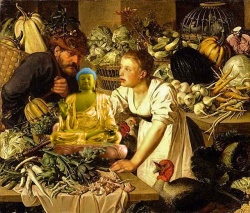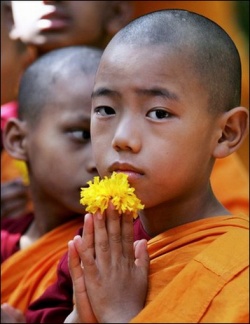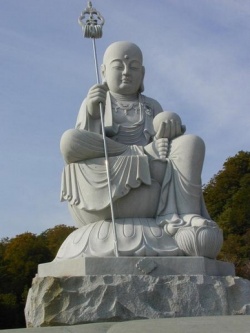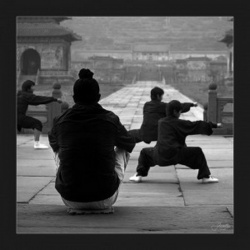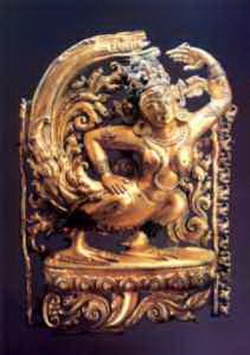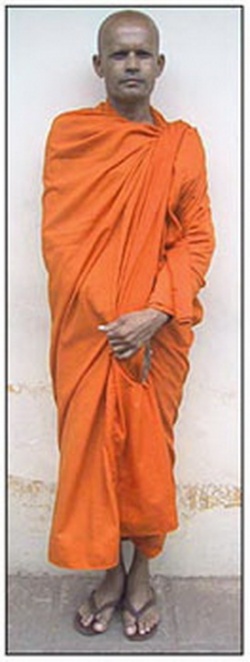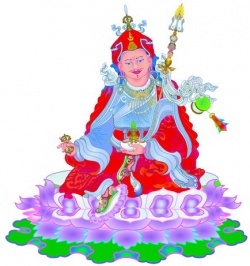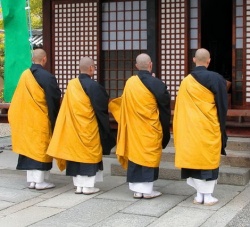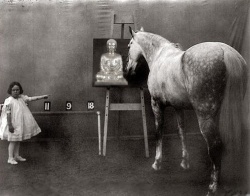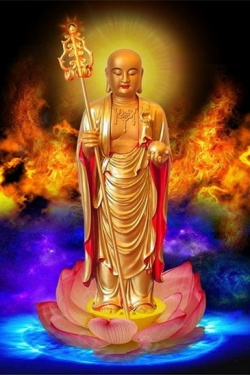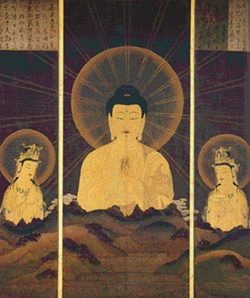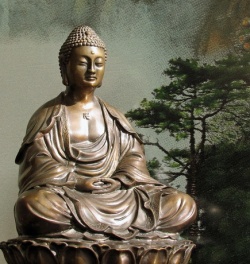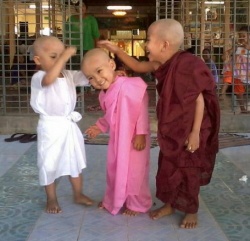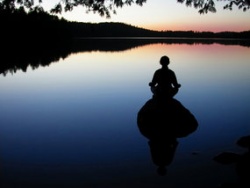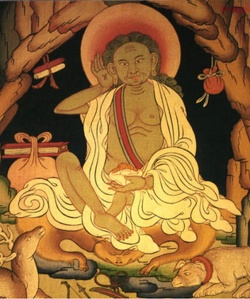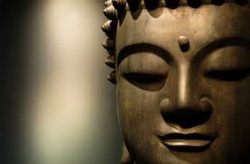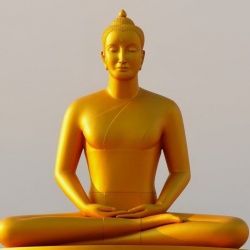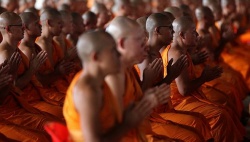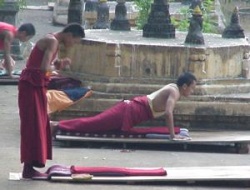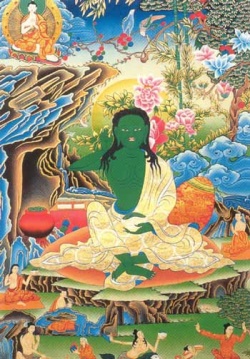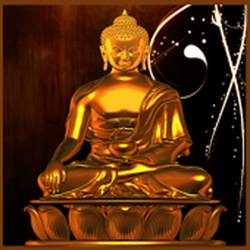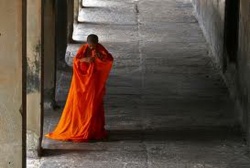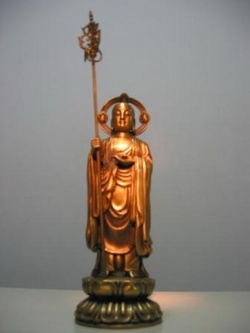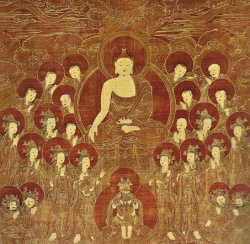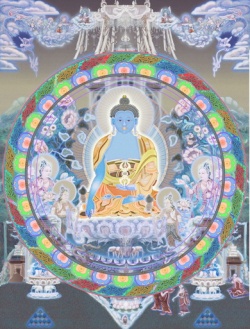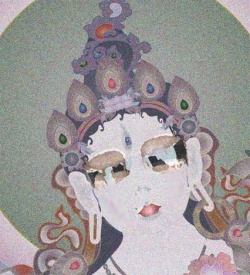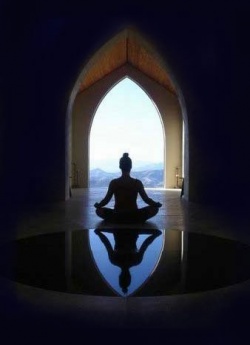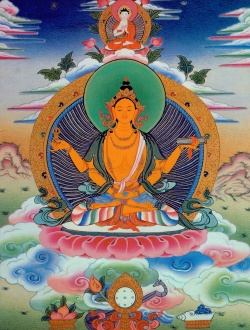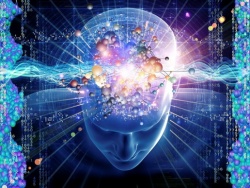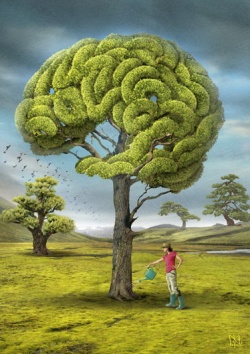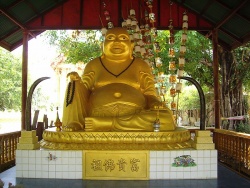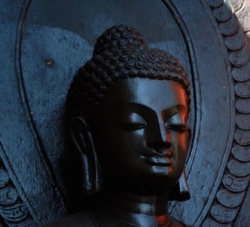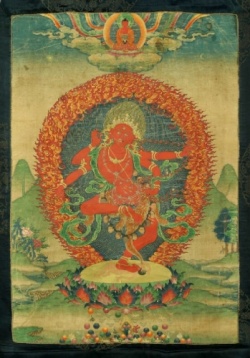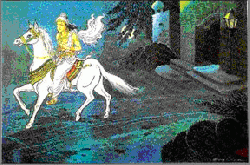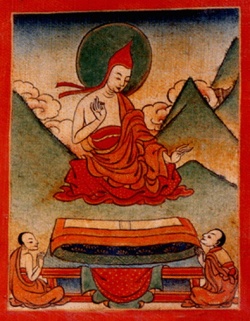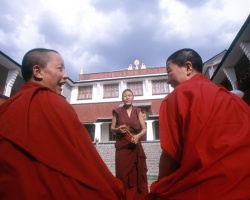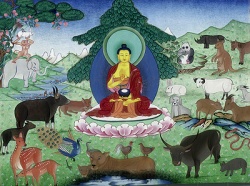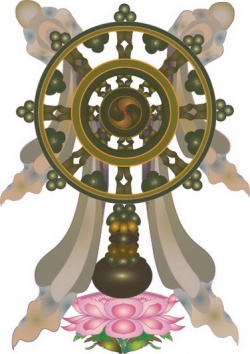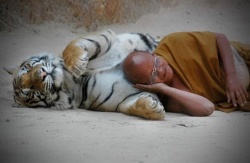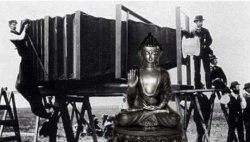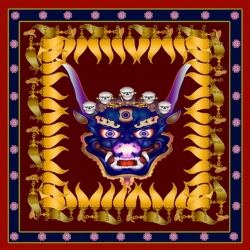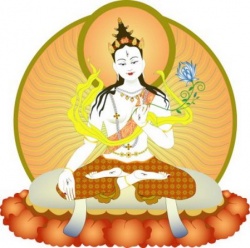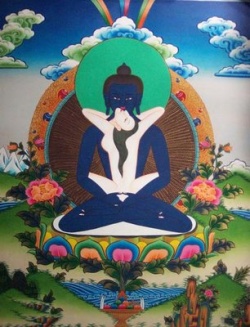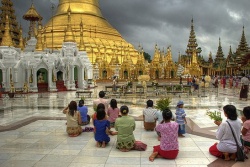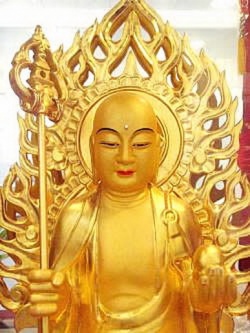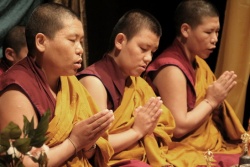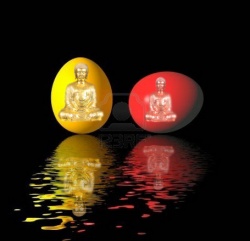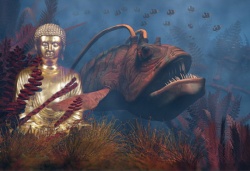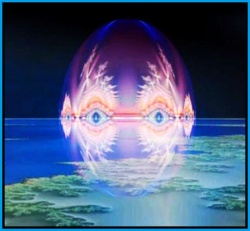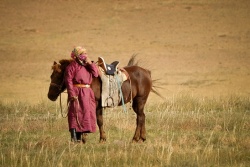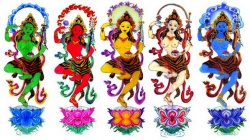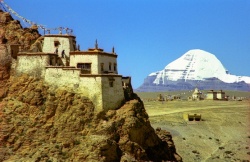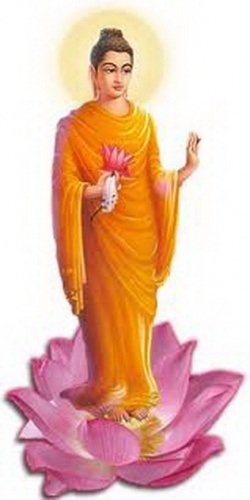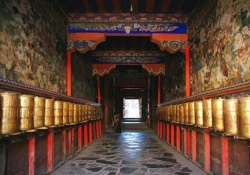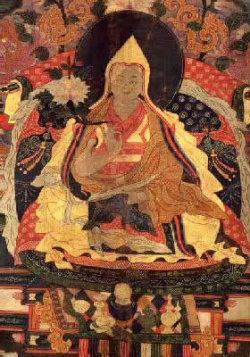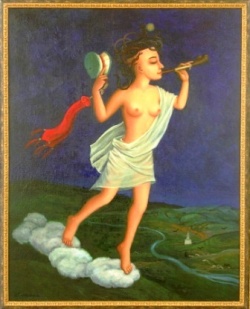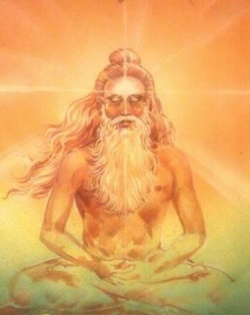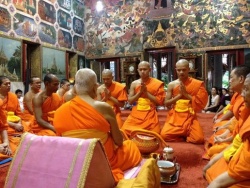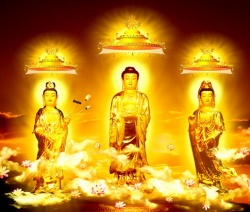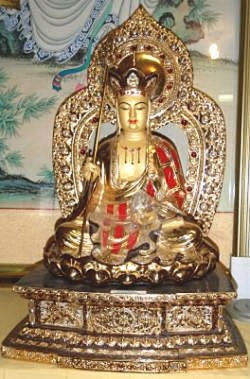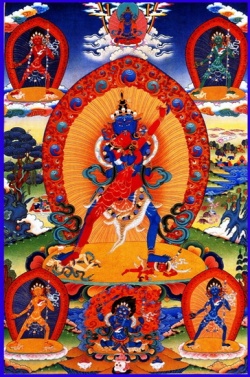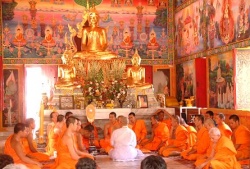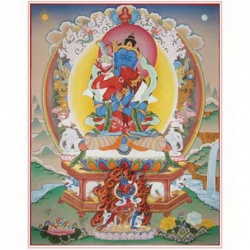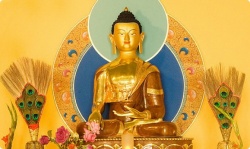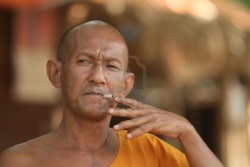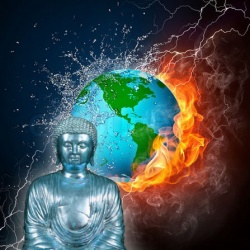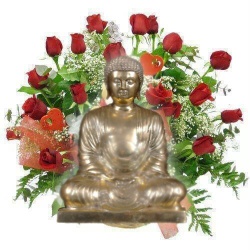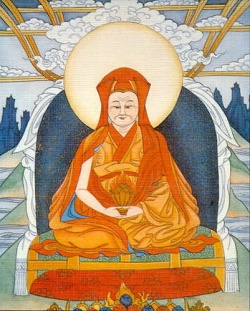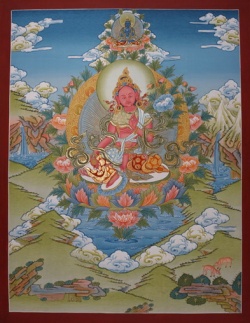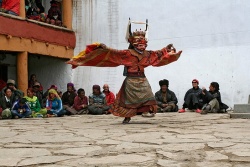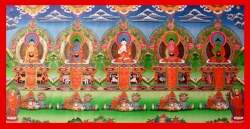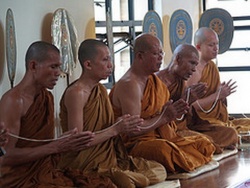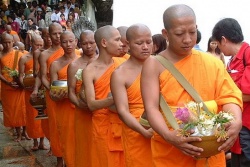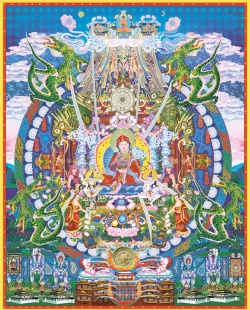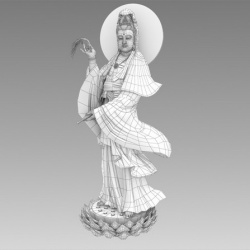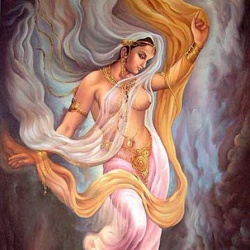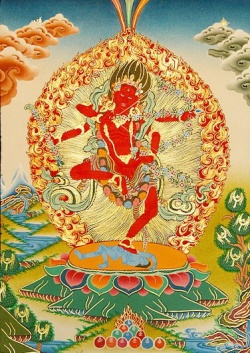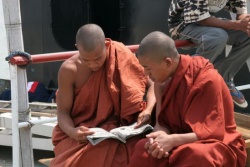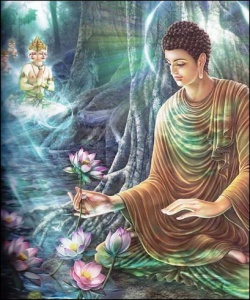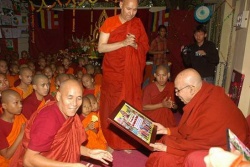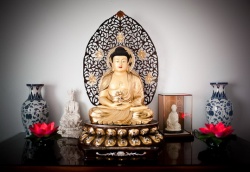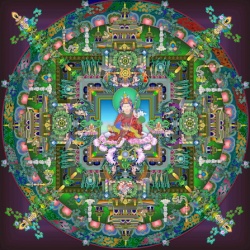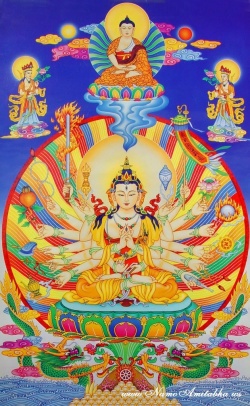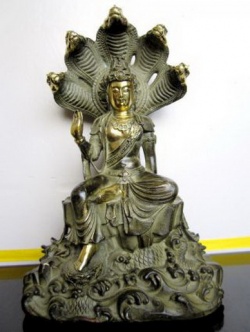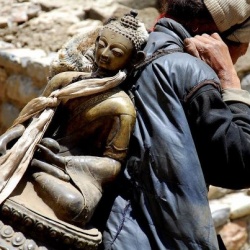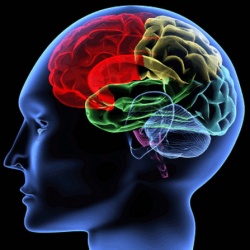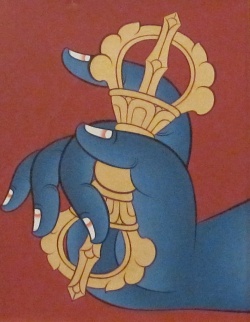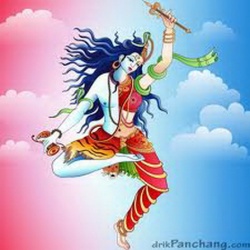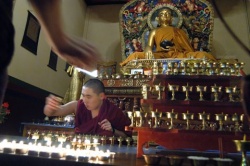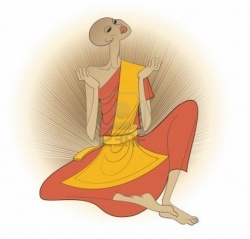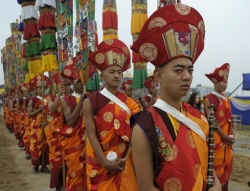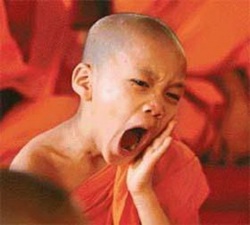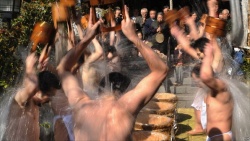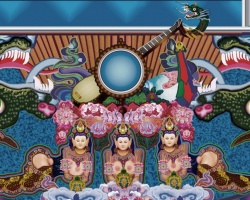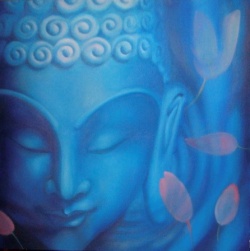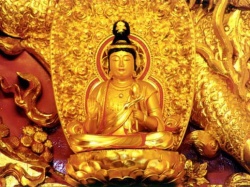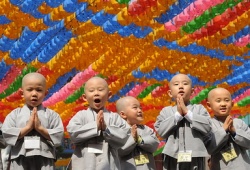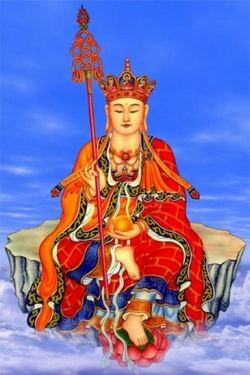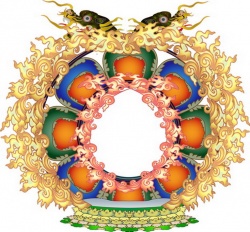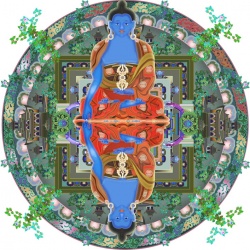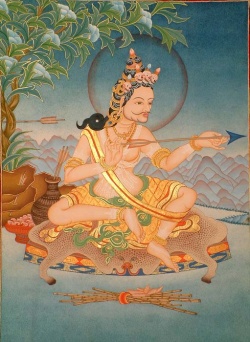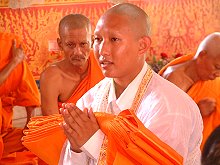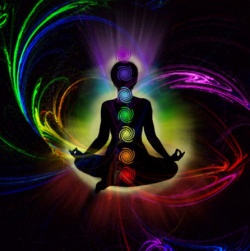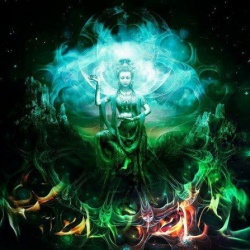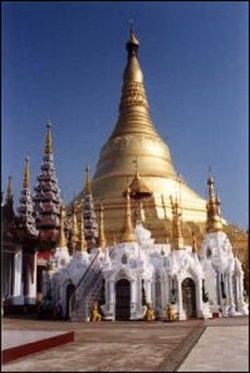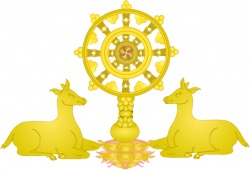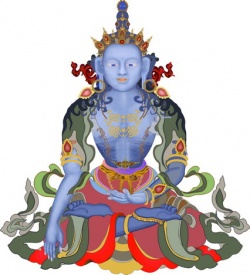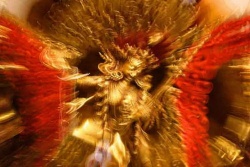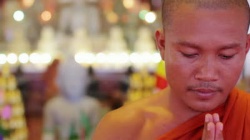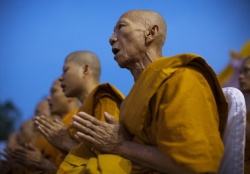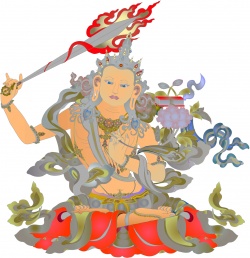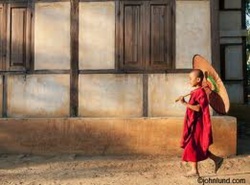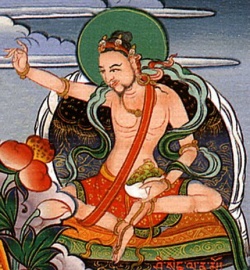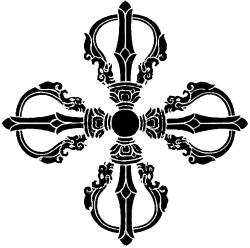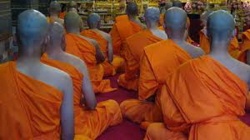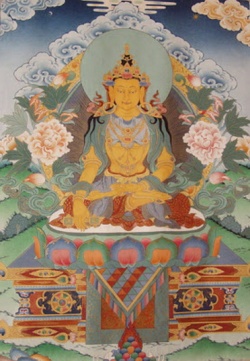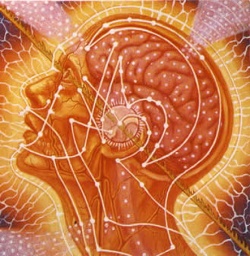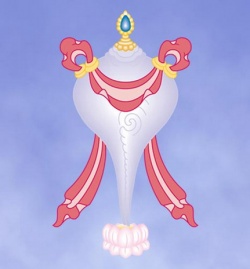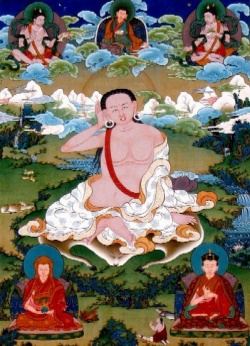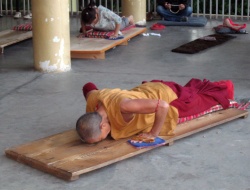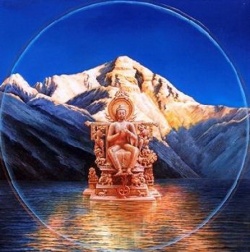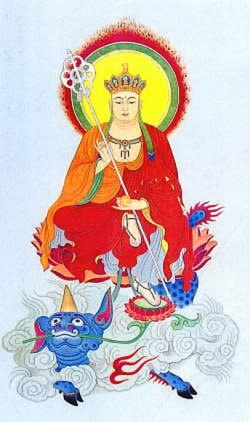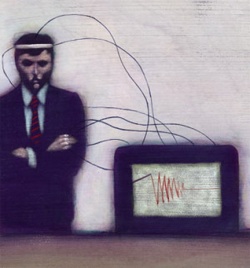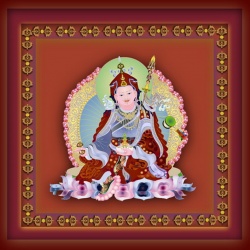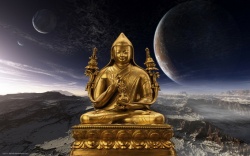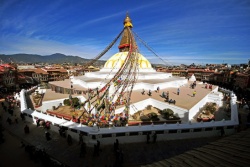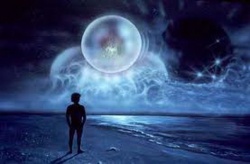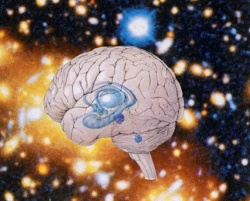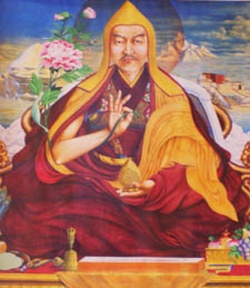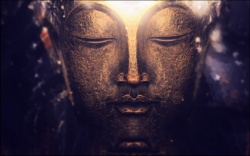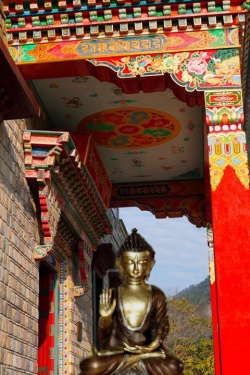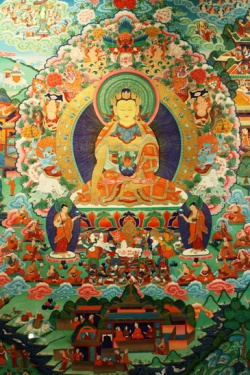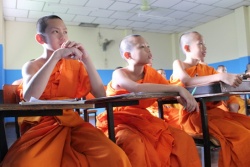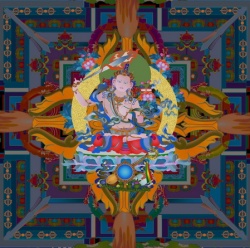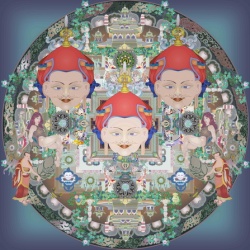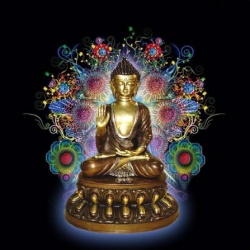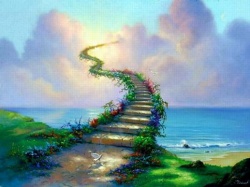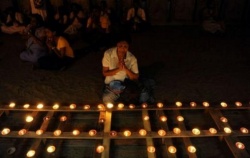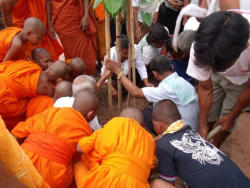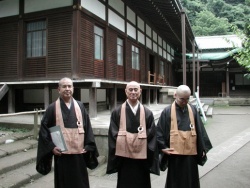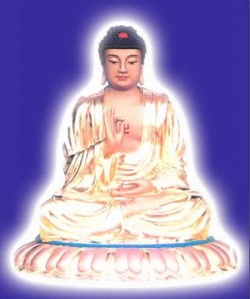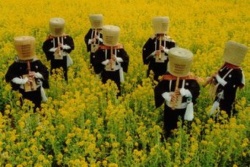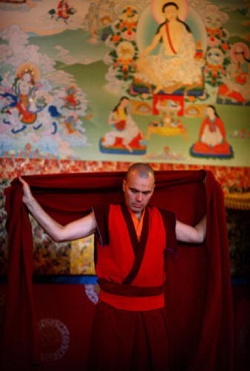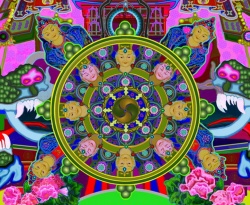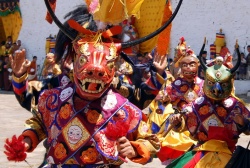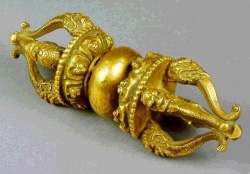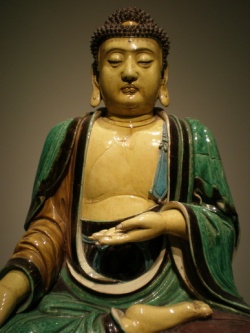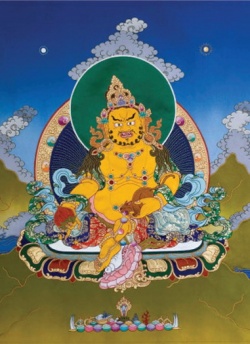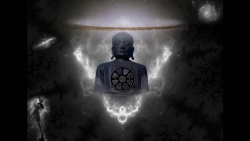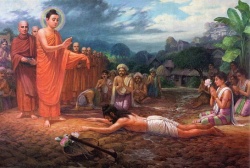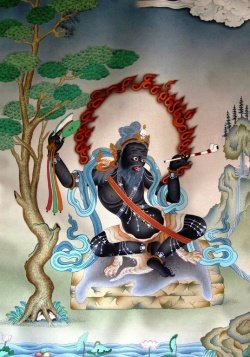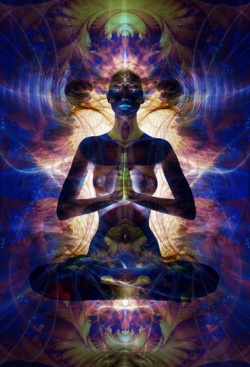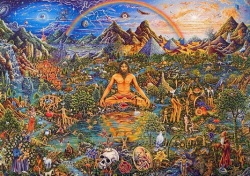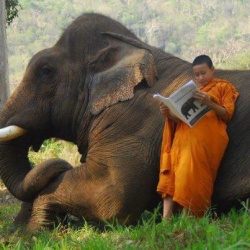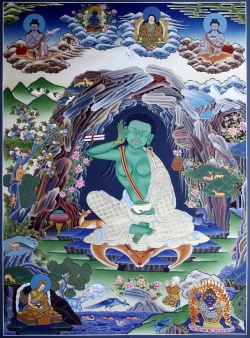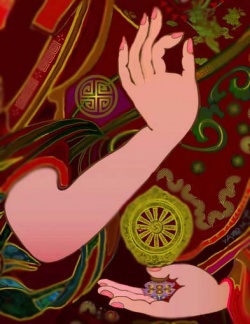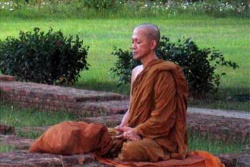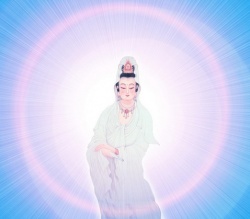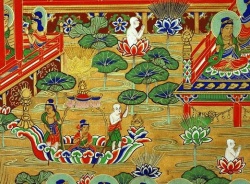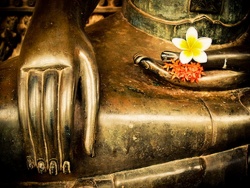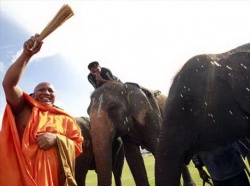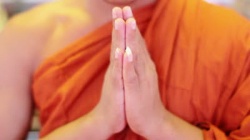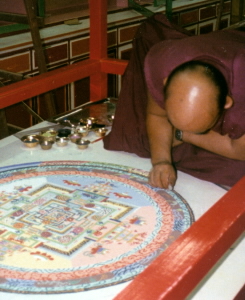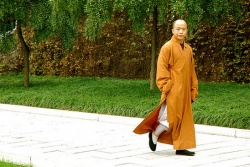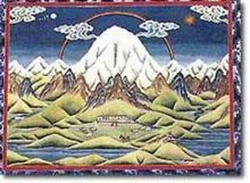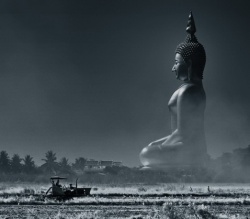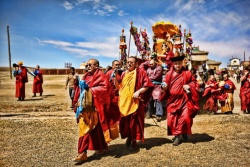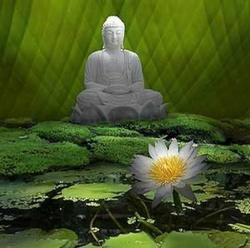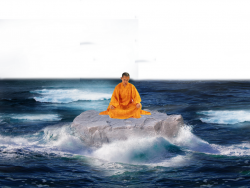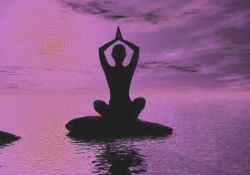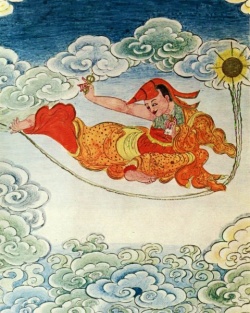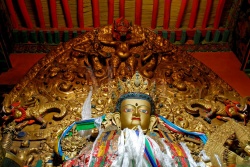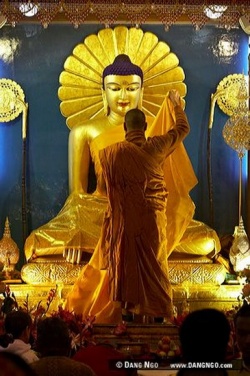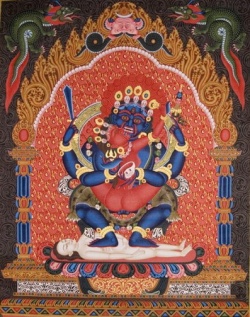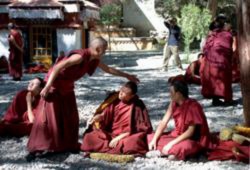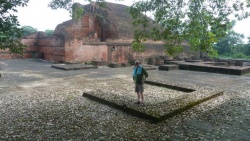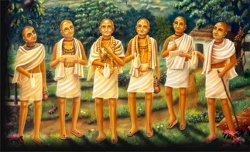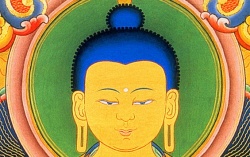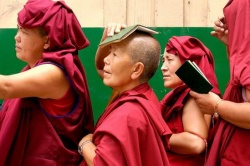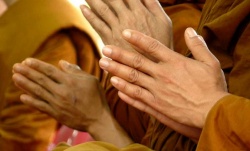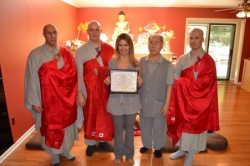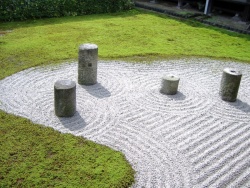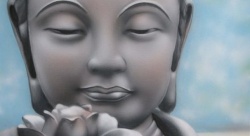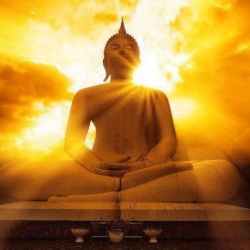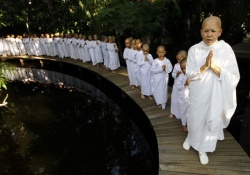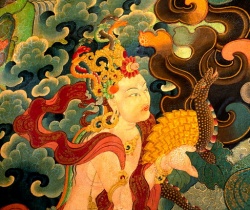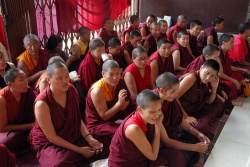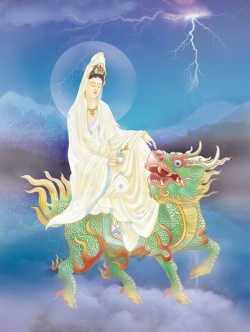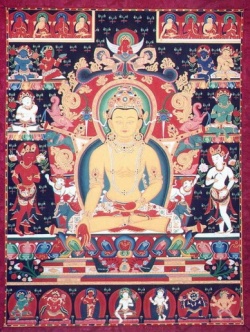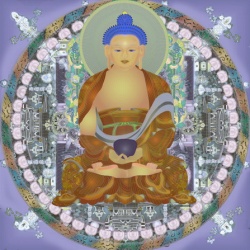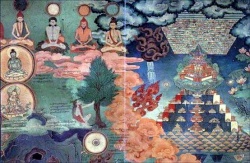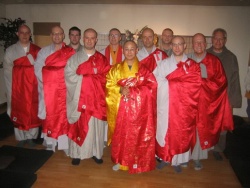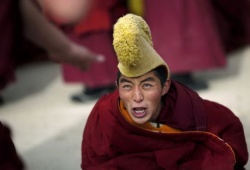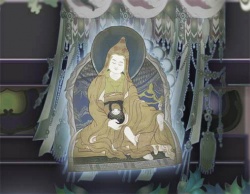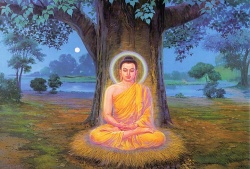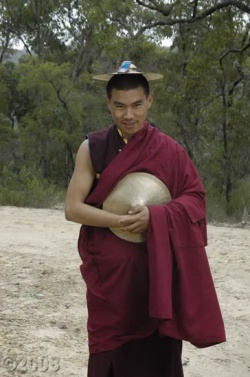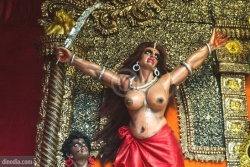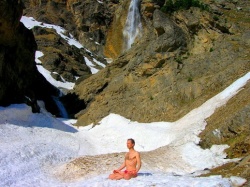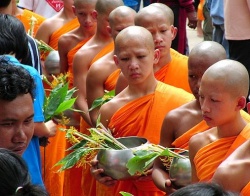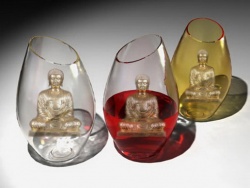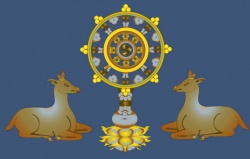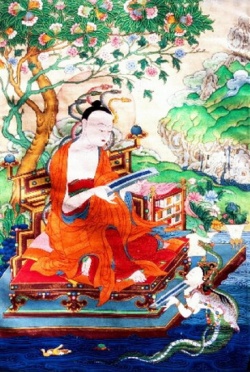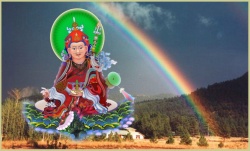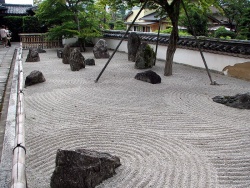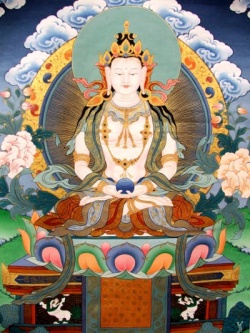The Shurangama Sutra With Commentary by the Tripitaka Master Hsuan Hua: Volume 2
The Shurangama Sutra
With Commentary by the Tripitaka Master Hsuan Hua
Volume 2
Contents
- 1 CHAPTER 1: The Seeing Nature
- 1.1 Seeing Is the Mind
- 1.2 Seeing Does Not Move
- 1.3 Seeing Does Not Become Extinct
- 1.4 Seeing is Not Lost
- 1.5 Seeing Does Not Return
- 1.6 Seeing Does Not Intermingle
- 1.7 Seeing Is Not Obstructed
- 1.8 Seeing Is Not Separate
- 1.9 Manjushri asks a question
- 1.10 Seeing Transcends the Ordinary
- 1.11 Seeing is Apart from Seeing
- 2 CHAPTER 2: The Two False Views
- 3 CHAPTER 3: Mixing and Uniting
- 4 Continue Reading
- 5 Source
CHAPTER 1: The Seeing Nature
K2 He displays the true nature.
L1 He divides the nature of the organ and points straight to the true mind.
M1 He uses the false to reveal the true.
N1 He shows that the seeing is the mind.
O1 He exhibits a dharma analogy.
"Ananda, you have told me that you saw my fist of bright light. How did it take the form of a fist? How did the fist become bright? By what means could you see it?”
Ananda replied, “The body of the Buddha is born of purity and cleanness, and, therefore, it assumes the color of Jambu River gold with deep red hues. Hence, it shone as brilliant and dazzling as a precious mountain. It was actually my eyes that saw the Buddha bend his five-wheeled fingers to form a fist which was shown to all of us.”
Commentary:
The Buddha called again to Ananda: Ananda, you have told me that you saw my fist of bright light. How did it take the form of a fist? How did the fist become bright? Tell me why my fist had light. By what means could you see it? What did you use to see it?
Ananda replied: The body of the Buddha is born of purity and cleanness, and, therefore, it assumes the color of Jambu River gold with deep red hues. Hence, it shone as brilliant and dazzling as a precious mountain. The Buddha’s entire body is the color of Jambu River gold. The Jambu River is located in southern Jambudvipa. The gold found in this river has a slightly reddish cast to it. In southern Jambudvipa there is a species of tree called the Jambu, and it is perhaps the stems of its leaves which turn to gold when they fall into the water. This kind of gold is much heavier than ordinary gold, and the Buddha’s body is likened to it; like the color of Jambu River gold, the color of the Buddha’s body is a combination of gold and red.
A body with that kind of appearance is produced from purity and therefore has light. The light exists because of that purity.
”It was actually my eyes that saw,” Ananda says. “I really used my eyes to see it. The five-wheeled fingers were clenched as they were shown to people, and that is what made the appearance of a fist.”
O2 He states the dharma-analogy and investigates it.
The Buddha told Ananda, “Today the Tathagata will tell you truly that all those with wisdom are able to achieve enlightenment through the use of examples.
Commentary:
The Buddha told Ananda, “Today the Tathagata will tell you truly. Now I am going to tell you the absolute truth. Are you listening? All those with wisdom are able to achieve enlightenment through the use of examples. People who are wise like to use examples in order to attain enlightenment, because if you really have wisdom, you will understand ten things when you are told one thing. I say something one way and you deduce perhaps ten or a hundred things from it. That is to have genuine wisdom.” Here “those with wisdom” does not mean people with genuine wisdom, though, but people with ordinary wisdom which is neither superior nor inferior. Such people can become enlightened through the use of analogies. But if stupid people who lack wisdom are given an analogy, they don’t understand, and they say, “What does that mean?”
Seeing Is the Mind
Sutra:
“Ananda, take, for example, my fist: if I didn’t have a hand, I couldn’t make a fist. If you didn’t have eyes, you couldn’t see. If you apply the example of my fist to the case of your eyes, is the idea the same?”
Commentary:
"Ananda, take, for example, my fist: if I didn’t have a hand, I couldn’t make a fist. By the same token, if you didn’t have eyes, you couldn’t see. If you apply the example of my fist to the case of your eyes, is the idea the same? Are we talking about the same thing or not?” the Buddha asks Ananda.
Sutra:
Ananda said, “Yes, World Honored One. Since I can’t see without my eyes, if one applies the example of the Buddha’s fist to the case of your eyes, the idea is the same.”
Commentary:
Ananda didn’t take time to cogitate over it. He isn’t thinking now. Ananda said, “Yes, World Honored One. Since I can’t see without my eyes, if one applies the example of the Buddha’s fist to the case of your eyes, the idea is the same. Yes, Buddha, if you compare these two cases, the idea is the same.”
O3 He makes clear that without eyes there is still seeing.
Sutra:
The Buddha said to Ananda, “You say it is the same, but that is not right. Why? If a person has no hand, his fist is gone forever. But one who is without eyes is not entirely devoid of sight.
Commentary:
Here the Buddha criticizes Ananda, telling him his idea is incorrect. The Buddha said to Ananda, “You say it is the same, but that is not right. You say the example is the same in both cases. No. Why? If a person has no hand, his fist is gone forever. If someone doesn’t have a hand, he doesn’t have a fist either. But one who is without eyes is not entirely devoid of sight. But with someone else who has no eyes it is not the case that he cannot see anything. He can see.” People without eyes can see. Do you believe that?
Sutra:
"For what reason? Try consulting a blind man on the street: ‘What do you see?’
"Any blind man will certainly answer, ‘Now I see only black in front of my eyes. Nothing else meets my gaze.’
Commentary:
For what reason? Why do I say that? Try consulting a blind man on the street: “What do you see?” Go out to the market and ask a blind man what he sees. Any blind man will certainly answer, “Now I see only black in front of my eyes. Nothing else meets my gaze.” He’ll say that he doesn’t see anything but blackness.
Sutra:
"The meaning is apparent: if he sees blackness in front of him, how would his seeing be considered ‘lost’?”
Commentary:
The meaning is apparent: if you get the idea, if you take a look at what it means, if he sees blackness in front of him, how could his seeing be considered “lost”? If you see blackness before you, your ability to see is not lost; it neither increases nor decreases.
O4 He makes clear that seeing darkness is seeing.
Sutra:
Ananda said, “The only thing blind people see in front of their eyes is blackness. How can that be seeing?”
Commentary:
Ananda reiterates the Buddha’s example: a blind person has no use of his eyes and so sees only darkness. But according to Ananda, this seeing of darkness is not really seeing. Ananda is saying that someone without the use of his eyes cannot see. “Why do you say the blind man sees?” he asks the Buddha.
Sutra:
The Buddha said to Ananda, “Is there any difference between the blackness seen by blind people, who do not have the use of their eyes, and the blackness seen by someone who has the use of his eyes when he is in a dark room?”
Commentary:
Is the darkness that sighted people see when they are in a dark house that is without the light of sun, moon, or lamps any different from the darkness seen by blind people? If a blind person and a person who has sight are together in a dark room, are the two blacks they see distinguishable?
Sutra:
"So it is, World Honored One. Between the two kinds of blackness, that seen by the person in a dark room and that seen by the blind, there is no difference.”
Commentary:
Ananda answers the World Honored One’s question, “So it is. Yes, Buddha. Between the two kinds of blackness, that seen by the person in a dark room - by the sighted person - and that seen by the blind, there is no difference. The two kinds of blackness are the same.”
"Fine,” said the Buddha. “Yes.”
O5 He states that the eye’s seeing is the mind.
P1 He points out the fault in the eye’s seeing.
Sutra:
"Ananda, if the person without the use of his eyes who sees only blackness were suddenly to regain his sight and see all kinds of forms, and you say it is his eyes which see, then when the person in a dark room who sees only blackness suddenly sees all kinds of forms because a lamp is lit, you should say it is the lamp which sees.
Commentary:
The Buddha said to Ananda: Ananda, if the person without the use of his eyes who sees only blackness were suddenly to regain his sight and see all kinds of forms… you say that there is no difference between the two kinds of blackness. But what if the blind person in our example were suddenly to regain his sight so that his eyes could see everything in every direction? You say it is his eyes which see. This is your argument. But what about the case when the person in a dark room who sees only blackness suddenly sees all kinds of forms because a lamp is lit? The sighted person in a dark room also sees blackness, but once a lamp is lit, he too can see everything. Given your argument, you should say it is the lamp which sees.
Why does the Buddha say that? People in a dark room cannot see, but when a lamp is lit, they can see. People who don’t have the use of their eyes cannot see, but if they regain their sight then they can see again. If when that person who cannot see suddenly sees because he regains his sight, then when the person in the dark room sees because of the lamp, that should be called the lamp’s seeing. “Is that right?” the Buddha asks.
Sutra:
“If it is a case of the lamp seeing, it would be a lamp endowed with sight - which couldn’t be called a lamp. And if the lamp were to do the seeing, how would you be involved?
Commentary:
If it really were the case that the lamp could see and do the looking, then it wouldn’t have anything to do with you.
P2 He concludes that in actual fact it is the mind that sees.
Sutra:
“Therefore you should know that while the lamp can reveal the forms, it is the eyes, not the lamp, that do the seeing. And while the eyes can reveal the forms, the seeing-nature comes from the mind, not the eyes.”
Commentary:
Therefore you should know that while the lamp can reveal the forms, it is the eyes, not the lamp, that do the seeing. The lamp allows the shapes to appear, but it is the eyes that see the shapes. By the same token, while the eyes can reveal the forms, the seeing-nature comes from the mind, not the eyes. We are now looking into the first or the ten manifestations of seeing. The first of the ten shows the seeing of the mind, not of the eyes.
Seeing Does Not Move
N2 He shows that the seeing does not move.
O1 Discussion of the assembly’s hope for instruction.
Sutra:
Although Ananda and everyone in the great assembly had heard what was said, their minds had not yet understood, and so they remained silent. Hoping to hear more of the gentle sounds of the Tathagata’s teaching, they put their palms together, purified their minds, and stood waiting for the Tathagata’s compassionate instruction.
Commentary:
Although Ananda and everyone in the great assembly had heard what was said, their minds had not yet understood, and so they remained silent. Ananda and everyone else there closed their mouths and didn’t say anything. Why weren’t they talking? They were thinking, “Oh? My eyes can’t see things? Oh? My mind sees? You may say that isn’t true, but the Buddha has explained it this way. If you say it is true, why haven’t I ever understood it to be this way before?” That’s what they were thinking, because they hadn’t yet understood. Their minds had not yet opened and become enlightened. Hoping to hear more of the gentle sounds of the Tathagata’s teaching - they were thinking, “I hope the Buddha will have a compassionate heart and talk to me.” They put their palms together. Why did they put their palms together? It represents their single-mindedness. They were of one mind, not two. When your hands are apart, it is said you have ten minds, and when your palms are together, it is said you have one mind, because when your palms go together, your mind comes together and becomes one. Purified their minds. Clear out your mind. Clear your heart. Don’t put too much garbage in your head. Take the garbage that is in there and get rid of it. And stood waiting for the Tathagata’s compassionate instruction. They stood waiting for the Buddha’s compassionate words to help them understand better, so they could become enlightened and not be so confused.
O2 He determines the guest and dust.
P1 The Thus Come One asks about the ultimate source of enlightenment.
Sutra:
Then the World Honored One extended his tula-cotton webbed bright hand, opened his five-wheeled fingers, and told Ananda and the great assembly, “When I first accomplished the Way I went to the Deer Park, and for the sake of Ajnatakaundinya and all five of the bhikshus, as well as for you of the fourfold assembly, I said, ‘It is because living beings are impeded by guest-dust and affliction that they do not realize Bodhi or become Arhats.’ At that time, what caused you who have now realized the holy fruit to become enlightened?”
Commentary:
Then, while those in the assembly stood waiting to receive the Buddha’s compassionate teaching and transforming, the World Honored One, Shakyamuni Buddha, extended his tula-cotton webbed bright hand, opened his five-wheeled fingers. On the Buddha’s hand is the hallmark of the thousand-spoked wheel. His hand is extremely soft, like the finest cotton, and it is webbed and luminous. He told Ananda and the great assembly: When I first accomplished the Way. One evening, on the eighth day of the twelfth month, while sitting under the Bodhi tree, he saw a star and awakened to perfect the Way. I went to the Deer Park. This is a vast park devoted exclusively to raising deer. How did that come about? It all began limitless kalpas ago when Shakyamuni Buddha was a deer, the leader of a herd of 500. And guess who else was there? Devadatta, who was also a deer king with a following of 500 deer. In the later life when the Buddha realized Buddhahood, Devadatta became the Buddha’s jealous cousin and tried to kill him. But in that earlier life when both were deer kings, there was a king among the people who used a lot of manpower and machinery to corral vast numbers of wild animals into a certain area. He planned to hunt them all down and kill them on the grounds that there were too many wild animals. So then Shakyamuni Buddha, in the form he had taken of a deer king had a meeting with the deer king Devadatta. They said to each other, “We should save the lives of our retinue. We shouldn’t let the king kill us all. How can we save ourselves? Let’s go talk it over with the king and petition him not to kill us off.” Although they were deer, they could speak the language of people. So the two deer went to see the king, and when they encountered the armed guard at the gates they said in a commanding tone, “We would like an appointment with the king. Can you deliver our message?” When the guard heard that the deer could speak the human language, he went to repeat their message to the king.
The king also found it strange to hear that deer could talk, and he agreed to an audience with them so they could state their petition. The two deer kings went before the king and said, “We are deer. Every day you kill seven or eight of us - more than you can possibly eat in a single day. What cannot be eaten is left to spoil. Wouldn’t it be better if we did it this way: every day we will take turns supplying you with one deer, and in that way you can have fresh venison every day without killing us all off at once. If you use this method, your supply of venison will never run out. Several hundred years from now there will still be venison to eat.”
Because he saw the sense in their petition, and because the deer could speak, the king was moved to grant their request. So each of the deer kings, on alternate days, sent the king a deer. Now one day it happened that it was the turn of a pregnant doe in Devadatta’s herd to go sacrifice herself to the king. Her fawn was heavy in her belly and would probably be born in a day or so. So she pleaded with the deer king Devadatta, “Can you send someone in my place today, and then after the fawn is born I will go to the king and sacrifice myself?”
Devadatta replied, “Impossible. It is your turn, and you must go. There is no politeness in this matter. You don’t want to die. Who does? Not one of the deer want to go to their death. You want to live a few more days now that it has come around to your turn, but that is impossible.”
The pregnant doe’s eyes brimmed with tears and she went to talk to the deer king who was to become Shakyamuni Buddha. Although she didn’t belong to his herd, she went to plead with him and ask if he could work out a temporary exchange so she could live a few more days until her fawn was born. As he considered her request, Shakyamuni Buddha realized that not one of his 500 deer would want to go in her place. However, the Buddha said to her, “Fine. You stay in my herd; you don’t need to go.” Then the deer king Shakyamuni Buddha went himself to be sacrificed in her place.
The king asked him, “What are you doing here? Have all your deer been eaten? Is your herd all gone? Why have you come?. And since he could talk, the deer king Shakyamuni Buddha said, “King, you haven’t eaten all our deer; on the contrary, we are prospering. Day by day our herds are increasing. You only eat one deer a day, and in one day our does give birth to many fawns.”
The king said, “Then why have you come yourself?”
Shakyamuni Buddha explained, “There is a pregnant doe whose fawn will be born in a day or so. It was her turn to come today, but since she wanted to wait until she had given birth to her fawn before she came to let the king eat her, she came to me and pleaded to have someone sent in her place. I thought over her request and realized that none of the deer in the herd would want to die before they had to, so I came myself to substitute for her.”
When the king heard that, he was profoundly moved, and he said, “From now on, don’t send any more deer to the palace.” Then he spoke a verse:
You are a deer with a human head.
I am a person with a deer’s head.
From this day forward,
I will not eat the flesh of living beings.
He said, “Although you have the head of a deer, you are a human being and although I have the head of a human being, I am a deer.” And then he vowed never to eat the flesh of living beings again. Because of that, the deer population in the park increased significantly; and the park was called the Deer Wilds Park. It was also named the Park of the Immortals because the “wind and water,” the geomantic lay of the land and its location, were particularly fine, and many immortals came there to cultivate the Way. So when Shakyamuni Buddha became a Buddha, he went first to the Deer Wilds Park to convert the five bhikshus.
And for the sake of Ajnatakaundinya and all five of the bhikshus. Three of the five bhikshus were relatives of the Buddha’s father and two were relatives of the Buddha’s mother. When the Buddha first left the palace to leave the home-life and cultivate the Way in the Himalayas, his parents had sent these relatives along after him to try to convince him to return. At that time the five bhikshus were not bhikshus, but high officials, and although they exhorted the Buddha to return, he would not. The five of them couldn’t go back and face the king, the Buddha’s father, without having accomplished their mission, so they stayed with the Buddha instead and accompanied him in cultivating the Way.
Of the three who were his father’s relatives, one was called Ashvajit - the name means “horse victory”; one was called Bhadrika - the name means “little worthy”; and the other was called Mahanama Kulika. The two on the mother’s side were Ajnatakaundinya and Dashabala Kashyapa, “drinker of light”, so named because he was a fire worshipper. The five stayed with the Buddha and cultivated ascetic practices, but eventually it became so bitter that three of them couldn’t take it and left. They backed out. The other two continued to cultivate with the Buddha. At that time the Buddha was eating only one grain of rice and one sesame seed a day, and he became so emaciated that he was nothing but skin and bones. Then one day a goddess brought him some milk gruel as an offering. He drank the gruel, and his body began to fill out again. The two who were cultivating with him got upset when they saw this, and they said, “How can someone who cultivates the Way drink milk gruel?” and so they left too. There was Shakyamuni Buddha in the midst of bitter cultivation and the five people his father and mother had sent to be with him all left him, three because they couldn’t take the suffering, and two because they saw the Buddha enjoying his blessings. The Buddha remained alone to cultivate. After he had cultivated there for six years, he went to sit under the Bodhi tree, and on the eighth day of the twelfth month he saw a star appear and became enlightened. “At night he saw a bright star and awakened to the Way.” After his enlightenment, he looked into the matter of who he should convert first, and saw that it was Ajnatakaundinya, one of the five bhikshus, who in a past life had been the king of Kalinga and had cut the Buddha’s body limb from limb. In that life the Buddha had vowed that when he became a Buddha the first one he would save would be the king of Kalinga. That is why when Shakyamuni Buddha became enlightened he went first to the Deer Park and converted the five bhikshus.
Shakyamuni Buddha said, “For the sake of the five bhikshus as well as for you of the four-fold assembly” - the four-fold assembly consists of the bhikshus (monks), bhikshunis (nuns), upasakas (laymen), and upasikas (laywomen). “I said, ‘It is because living beings are impeded by guest-dust and affliction that they do not realize Bodhi or become Arhats.’” Why don’t living beings accomplish Buddhahood or become enlightened? Why don’t they accomplish the first fruit of arhatship?
The phrase “guest-dust” also refers to your false thoughts. False thoughts are “guest-dust” and affliction. You can also say that “guest-dust” refers to the two kinds of delusion: view-delusion and thought-delusion. “Afflictions” can also be said to be delusions of ignorance and delusions as numerous as motes of dust and sand.
Why are people impeded by “guest-dust” and affliction? Because people are really strange. They like to eat afflictions all day long. Fix them good food, give them some good bread and butter, and they won’t eat it. All they want to eat is afflictions, which they find more delicious than vegetable dumplings. Even if someone tells them not to eat affliction, they find it impossible to refrain from it. From morning to night, they eat nothing but “guest-dust” and afflictions and fill their bellies full of anger instead of food. People like that are truly pathetic. Shakyamuni Buddha said, “The reason all you living beings do not become Buddhas or Arhats is because you are impeded by ‘guest-dust’ and affliction.”
At that time, what caused you who have now realized the holy fruit to become enlightened? “That time” refers to the time when Shakyamuni Buddha went to the Deer Park and spoke dharma. “You” the Buddha means the five bhikshus and the fourfold assembly of bhikshus, bhikshunis, upasakas, and upasikas. The Buddha asks them how and why they became enlightened when he talked about “guest-dust” and affliction. What meaning did they see that caused them to obtain the fruition of arhatship?
P2 Purna answers that the Buddha sealed and certified him.
Sutra:
Then Ajnatakaundinya arose and said to the Buddha, “Of the elders now present in the great assembly, only I received the name ‘understanding’ because I was enlightened to the meaning of the word ‘guest-dust’ and realized the fruition.
Commentary:
Ajnatakaundinya was one of the five bhikshus. His name is interpreted to mean “understanding the fundamental limit” and also “the very first to understand” because he was the first to understand and to be certified as having attained arhatship. Then Ajnatakaundinya arose and said to the Buddha. Ajnatakaundinya stood up and spoke to the Buddha. Of the elders now present in the great assembly, only I received the name ‘understanding’ because I was enlightened to the meaning of the word ‘guest-dust’ and realized the fruition. He said, “Now in this great assembly, I am an elder, I am older and much more experienced. Why did I receive the name ‘understanding’? Upon hearing the Buddha speak the word ‘guest-dust’ I understood the meaning and attained enlightenment.” Ajnatakaundinya will explain the meaning of “guest-dust” in the following passages.
Sutra:
"World Honored One, it is like a traveler who stops as a guest at a roadside inn, perhaps for the night or perhaps for a meal. When he has finished lodging there or when the meal is finished, he packs his baggage and sets out again. He does not remain there at leisure. The host himself, however, does not go far away.
Commentary:
World Honored One. Ajnatakaundinya said, “Buddha, why was it that the two words ‘guest-dust’ brought about my enlightenment? It is like a traveler who stops as a guest at a roadside inn, perhaps for the night or perhaps for a meal. A guest who is on a journey, on a holiday, looks for an inn where he can stay for a while. Perhaps he stays overnight there, or perhaps he goes there to eat. When he has finished lodging there or when the meal is finished, he packs his baggage and sets out again. When he has finished eating and sleeping, he readies his suitcases and goes on. He does not remain there at leisure. He’s a guest; he can’t live there all the time. The host himself, however, does not go far away.” The “host” refers to the pure nature and bright substance of the permanently dwelling true mind. The “guest” refers to false thinking, the wearisome dust.
Why is it compared to “guest dust”? Because it is not something fundamental to us. Our bodies are basically clean, but if we go out on a windy day the dust may blow up and cover us, soiling our bodies. When we take our hands and brush away the dust, it disappears. What does this represent? It represents our afflictions and ignorance which are like “guest-dust”; they do not really exist. The guest is affliction and ignorance, the obstruction of affliction, the obstruction of what is known, the delusion of views and the delusion of thought. So Ajnatakaundinya understood that the guest at an inn stays only temporarily, whereas the host of the inn always lives there.
Sutra:
"Considering it this way, the one who does not remain is called the guest, and the one who does remain is called the host. The word ‘guest’, then, means ‘one who does not remain.’
Commentary:
Ajnatakaundinya concludes: Considering it this way, the one who does not remain is called the guest, and the one who does remain is called the host. We can also say that we reside in our bodies temporarily as a guest does in an inn. We should understand that our bodies are merely an inn, not an actual home. They are not our own home, and so we shouldn’t be too attached to them. But our host, the permanently dwelling true mind, never goes away, never ceases to exist. The word “guest,” then, means “one who does not remain.”
Sutra:
"Again, when the sky clears up, the morning sun rises with all resplendence, and its golden rays stream into a house through a crevice to reveal particles of dust in the air. The dust dances in the rays of light, but the empty space is motionless.
Commentary:
Again, when the sky clears up, the morning sun rises with all resplendence, and its golden rays stream into a house through a crevice to reveal particles of dust in the air. When the sun has just come up, early on a clear fresh morning, a morning after a rain, the sun shines through a crack in the door or perhaps a crack in the wall, and it displays the fine bits of dust bobbing up and down in empty space, moving all around in the sunshine. The dust dances in the rays of light, but the empty space is motionless. If the sun doesn’t shine in the crack, you can’t see the dust, although there is actually a lot of dust everywhere. But while the dust moves and bobs up and down, empty space is still. It doesn’t move. The ability to see the dust in the light that pours through the crack represents the attainment of the light of wisdom. When you certify to the fruit and reach the first stage of arhatship and overcome the 88 categories of view-delusion, you have the light of wisdom. Then you can see your ignorance, which causes afflictions as numerous as motes of dust or grains of sand in the Ganges River. The sun of wisdom shines on the dust-particles of affliction, as in Ajnatakaundinya’s analogy of the sun shining through the crack. The dark caverns of ignorance are illumined, and you see the dust of affliction, and you understand.
Sutra:
"Considering it this way, what is clear and still is called space, and what moves is called dust. The word ‘dust’, then, means 'that which moves.’ ”
Commentary:
Ignorance and afflictions as numerous as motes of dust move, but empty space does not move. Empty space represents our seeing-nature, which is also unmoving. It is the genuine host, our permanently dwelling true mind which does not come and does not go.
Considering it this way, what is clear and still is called space. Clear and still, it does not move, and that is called space. And what moves is called dust. The word “dust”, then, means “that which moves.” You see the bits of dust in the patch of sunshine dancing and flying about ceaselessly. What is this dust? It represents affliction, ignorance, the obstacle of affliction, and the obstacle of what is known. Attachment to those things is called “dust”.
Every day you listen to the sutra and I tell you not to have afflictions, and all you’ve got is afflictions. I tell you not to have ignorance and all you do is display your ignorance. Would you call this being obedient? The more it is said that ignorance is not a good thing, the greater the ignorance becomes. When it is said that afflictions aren’t good, the afflictions grow. Before it was discussed, there were no afflictions, but once it was brought up, the afflictions came forth. So it must be that my explanation of the sutra isn’t a good explanation, because I haven’t been able to explain away your afflictions. I hope you will all toss your afflictions into the Pacific Ocean. Don’t look upon your afflictions as precious treasures. Don’t treat afflictions as if they were your own kin. Don’t let affliction be your playmate with birth and death. Don’t be so affectionate towards them. You should toss your afflictions into the ocean, even though there are so many of them that they might well fill up the entire ocean.
Afflictions are demons. Where do you find demons and demonic ghosts? To have demonic ghosts is simply to have afflictions. You and the demons have gotten together. Afflictions are absolutely terrible, and the sutra is being explained just to teach people to get rid of their afflictions, so don’t let it be that the more we speak of afflictions the more they multiply.
Sutra:
The Buddha said, “So it is.”
Commentary:
After Ajnatakaundinya finished speaking, the Buddha gave him positive certification. He said, “What you have said is correct.” The Buddha said, “So it is.” What moves is dust, what does not move is space. Your theory is not mistaken.
Seeing Does Not Become Extinct
N3 He shows that the seeing does not become extinct.
O1 The assembly considers this and asks for further instruction.
Sutra:
When Ananda and the great assembly heard the Buddha’s instructions, they became peaceful and composed both in body and mind. They recollected that since time without beginning, they had strayed from their fundamental true mind by mistaking the shadows of their causally conditioned differentiating minds as something real and substantial. Now on this day they had awakened to such illusions and misconceptions. Like a lost infant who rejoins its beloved mother after a long separation, they put their palms together to make obeisance to the Buddha.
Commentary:
When Ananda and the great assembly heard the Buddha’s instructions. When Ananda and the great Bodhisattvas, the great Arhats, and the great bhikshus, and the others heard this teaching, they became peaceful and composed both in body and mind. Their bodies and minds felt extremely comfortable, so that they didn’t feel the least bit of pain. They had never felt better. They had never known anything so fine. But at the same time, they recollected that since time without beginning, they had strayed from their fundamental true mind by mistaking the shadows of their causally conditioned differentiating minds as something real and substantial. From time without beginning they had renounced their basic mind and had used only their false mind, their conscious mind, their mind which makes distinctions in order to do things. They hadn’t understood external states; they’d taken their false-thinking mind to be true and actual. They had engaged in false activities at the gates of the six organs and hadn’t the least bit of skill when it came to the self-nature. In order to function, they dealt exclusively with the false-thinking mind, the attached mind, the arrogant mind, the mind which seizes upon conditions, the mind which is false in various kinds of ways. Now on this day they had awakened to such illusions and misconceptions. Like a lost infant who rejoins its beloved mother after a long separation, they put their palms together to make obeisance to the Buddha. They had been like a hungry child who had no milk to drink; it had been very painful. All of a sudden the child’s compassionate mother had returned, and the child had milk to drink: that is what it was like for the assembly when they awakened upon hearing the Buddha’s instruction. They placed their palms together and bowed to the Buddha to thank him for his kindness in bestowing the dharma upon them.
Sutra:
They wished to hear such words from the Thus Come One as to enlighten them to the dual nature of body and mind - what is false and what is real, what is empty and what is substantial, what is subject to production and extinction and what transcends production and extinction.
Commentary:
Why did the assembly bow to the Buddha? Because they wished to hear such words from the Thus Come One as to enlighten them to the dual nature of body and mind. They wanted him to uncover it and portray it clearly, to reveal what is false and what is real, what is empty and what is substantial. There is the true and the false, the empty and the actual, and they wanted the Buddha to teach them to recognize each of them. They wanted him to reveal what is subject to production and extinction and what transcends production and extinction - to reveal the mind’s dual nature, the mind with superficial production and extinction and the mind that is not subject to production and extinction.
What is the mind of production and extinction? It is the conscious mind, our mind which seizes upon conditions by turning to the outside and seeking there, instead of developing skill at the self-nature. What is the mind not subject to production and extinction? You must apply your skill to the self-nature and understand that the mountains, the rivers, the great earth, the vegetation, and all the myriad appearances are all the dharma body of all Buddhas. The dharma body of all Buddhas is neither produced nor extinguished. And the pure nature and bright substance of everyone’s permanently dwelling true mind is also not produced and not extinguished.
Why do we have production and extinction, birth and death?
It is because we do not recognize the pure nature and bright substance of the permanently dwelling true mind. It is also because your mad mind has not ceased. So it is said, “when the mad mind ceases, that ceasing is Bodhi.” The mad mind’s stopping itself is the manifestation of your Bodhi mind. Because the mad mind exists and has not ceased, the Bodhi mind cannot come forth. The mad mind covers it over. What is being explained now, and in every other passage of sutra text without exception, has the aim of revealing everyone’s true mind.
O2 King Prasenajit tells his situation and makes a special request.
Sutra:
Then King Prasenajit rose and said to the Buddha, “In the past, when I had not yet received the teachings of the Buddha, I met Katyayana and Vairatiputra, both of whom said that this body is annihilated after death, and that this is nirvana. Now, although I have met the Buddha, I still have doubts about their words. How much I wish to be enlightened to the ways and means to perceive and realize the true mind, thereby proving that it transcends production and extinction! All those who have outflows also wish to be instructed on this subject.”
Commentary:
Then - before the Buddha spoke - King Prasenajit rose in the great assembly. King Prasenajit’s name means “moonlight” in Sanskrit, as mentioned before. The king was born at the same time that the Buddha entered the world. Upon entering the world the Buddha emitted light, but King Prasenajit’s father thought that it was his son who was emitting the light as he came into the world, so he named him “Moonlight.”
King Prasenajit said to the Buddha, “In the past, when I had not yet received the teachings of the Buddha, I met Katyayana and Vairatiputra. Before I received the benefit of the Buddha’s teaching and transforming, I believed in external paths.” He believed in the annihilationism of Katyayana. “Katyayana” is a Sanskrit name which is interpreted to mean “cut hair,” because formerly those who followed this external path did not cut their hair or their fingernails, and so were called the “long-nailed external path.” “Vairatiputra” means “son of Vairati”; Vairati was his mother’s name; the name is interpreted to mean “does not do.” What he didn’t do were good deeds, but he had no hesitation about doing bad deeds.
Both of whom said that this body is annihilated after death, and that this is nirvana. They say that after this body dies there isn’t anything. There is no cause and there is no effect, no future lives and no former lives. Basically a person’s death is like putting out a lamp. It’s gone. There isn’t anything at all. Everything is annihilated. Annihilation means there is no soul, no awareness, no nature, nothing at all, and that’s what they call nirvana. That’s what annihilationists mean by not produced and not extinguished; since there’s nothing, there isn’t any production or extinction. That’s how the external paths talk. But I will tell you all that that is a grave mistake. When people die they are not annihilated.
So, it is just at this point where the distinction between Buddhism and external paths lies. Some external paths talk about annihilation, and some talk about permanence. One advocates annihilation, the other advocates externalism, and both kinds confuse people most seriously.
" Now, although I have met the Buddha, I still have doubts about their words. The Buddha has come into the world and has come to teach and transform me, but I still have ‘fox-like’ doubts and do not believe the doctrine spoken by the Buddha.” He still feels that people are annihilated when they die and that their ceasing to exist is nirvana.
Doubts are said to be “fox-like” because the fox-spirit is doubtful by nature. No matter what you say, he doesn’t believe it. For example, when a fox walks across the ice in winter, he takes one step, stops, cocks his ear, and listens, then takes another step and cocks his ear to listen. If he hears the ice cracking, he immediately retreats. He knows that if the ice cracks it is not thick enough and could send him plunging into the river. He is extremely intelligent. So it is said of an intelligent person, “He’s as smart as a fox-spirit.” He has a lot of doubt in his mind and is apt to argue. He opposes everyone, no matter who, and is always on the defensive, like a fox.
How much I wish to be enlightened to the ways and means to perceive and realize the true mind, thereby proving that it transcends production and extinction! All those who have outflows also wish to be instructed on this subject. How can I come to know the genuine doctrine of no production and no extinction and realize my mind which is not produced and not extinguished? Everyone in the assembly who has not obtained the spiritual penetration of the extinction of outflows wishes to understand this doctrine.
To have outflows is to flow into the three realms - into the desire realm, the form realm, and the formless realm. When people flow there, they undergo birth and death. Those who have not ended birth and death are called people with outflows. So everyone in the assembly who had not certified to the fruit and still had outflows wanted to understand the doctrine of no production and no extinction so that they could all perceive their true minds, be enlightened, and end their outflows.
O3 The Thus Come One thoroughly shows that seeing is not extinguished.
P1 He shows that the body changes.
Q1 Discussion of the overall changes and eventual extinction.
Sutra:
The Buddha said to the great king, “Now I ask you, as it is now is your physical body like vajra, indestructible and living forever? Or does it change and go bad?”
"World Honored One, this body of mine will keep changing until it eventually becomes extinct.”
Commentary:
In this section of text the Buddha asks the king whether the king’s body will decay, and the king answers that it will decay completely. The Buddha said to the great king, “Now I ask you, as it is now is your physical body like vajra, indestructible and living forever? If we just consider your flesh-body, is it as durable as vajra? Is it eternally indestructible like a vajra jewel or a diamond? Or does it change and go bad? In the last analysis, what is it like? Is it possible to destroy it? Tell me.”
World Honored One, this body of mine will keep changing until it eventually becomes extinct. Upon hearing the Buddha’s question, King Prasenajit replied without hesitation, “World Honored One, this body of mine will eventually go completely bad. Eventually it will be finished, that is for certain.”
Sutra:
The Buddha said, “Great king, you have not yet become extinct. How do you know you will become extinct?”
Commentary:
In answer, the Buddha said, “Great king, you have not yet become extinct. You aren’t dead yet; how do you know that in the future you will die? You haven’t become extinct yet, so what enables you to know that you will keep changing until you become extinct? Tell me. How does it happen that you know so much doctrine?”
Sutra:
"World Honored One, although my impermanent, changing, and decaying body has not yet become extinct, I observe it now, and every passing thought fades away. Each new one fails to remain, but gradually perishes like fire turning to ashes. This perishing without cease convinces me that this body will eventually become completely extinct.”
Commentary:
King Prasenajit replied: World Honored One, although my impermanent, changing, and decaying body has not yet become extinct, I observe it now - although it is not dead yet, this body of mine is not eternal, but at best will last only eighty or ninety years. At the very most it won’t last more than a hundred years.”
"Observe” means that he contemplated it in general and in detail, inside and outside, from front to back, and close up and from a distance. “I look at others and look at myself. Other people die and I am the same as they are.”
Every passing thought fades away. Now he regards his mind within, and sees that each thought perishes as the next thought arises. The one replaces the other and is replaced by the next in turn. They are just like waves. Although I cannot see them, they seem like waves which arise ceaselessly, one wave upon the next. They are continually changing and dying out. Each new one fails to remain, but gradually perishes. A thought does not remain forever. As a new thought comes up, the one preceding it disperses, and none can last eternally. It is the same as when incense is lit. Like fire turning to ashes. The ashes fall and the fire reappears, but then, after a short while, the ashes once again cover the fire. The ashes represent the old; the fire is the new. But the new is continually, unendingly turning to ashes. The ashes fall bit by bit and turn into dust and disappear. This perishing without cease convinces me that this body will eventually become completely extinct. So I am absolutely certain without any question that in the future my body will return to extinction.
Sutra:
The Buddha said, “So it is.
Commentary:
Shakyamuni Buddha tells the king that he has explained it correctly. Every passing thought fades away and will eventually become completely extinct.
Q2 A detailed examination of the change and extinction.
R1 He compares old age and youth.
Sutra:
"Great king, at your present age you are already old and declining. How do your appearance and complexion compare to when you were a youth?”
Commentary:
Although the Buddha agreed with King Prasenajit’s explanation, he still had questions to ask. Great king, at your present age you are already old and declining. You’re already old, and your face is now wrinkled, your beard white, your hair snowy. The marks of decay are appearing. How do your appearance and complexion compare to when you were a youth? “Complexion” refers to the color of his face, “appearance” refers to the features. “Is there any difference between your features as they are now and as they were when you were young? Has there been any change?” the Buddha asks King Prasenajit.
Sutra:
"World Honored One, in the past when I was young my skin was moist and shining. When I reached the prime of life, my blood and breath were full. But now in my declining years, as I race into old age, my form is withered and wizened and my spirit dull. My hair is white and my face is in wrinkles and I haven’t much time remaining. How can I be compared to how I was when I was full of life?”
Commentary:
The king answered: World Honored One, in the past when I was young my skin was moist and shining. This refers to when he was a child. Sometimes children are spoiled, act up, and are not very obedient to their parents, and the parents indulge them. “Skin” here refers to the surface of the skin as well as to the subcutaneous region between the skin and the flesh. Children’s cheeks are rosy, and that’s how the king was - very vibrant. When I reached the prime of life, my blood and breath were full. He felt that his body was very strong. But now in my declining years, as I race into old age, he has reached the point where his body no longer helps him out. The body is oppressive and nags at him to move somewhere else. It will soon be unlivable.
It is said that there are three restrictions on the superior person. “When one is young and the blood and breath are restless, the restriction is on sex.” Young people should restrict sex, restrict sexual desire. If you do not, you will cause your body to lose its health and strength. “When one is in one’s prime and the blood and breath are strong, the restriction is on fighting.” You should not spend all your time picking quarrels. If someone hits you, move back a step. Don’t fight with people. “When one is old and the blood and breath are on the decline, the restriction is on acquiring things.” “Acquiring things” means being insatiably greedy. Old people should not be greedy about acquiring things.
The old age that King Prasenajit is racing towards refers to the age of seventy or more. Wasn’t it Emperor Yao who said, “At seventy I turn to rest?” Because he was over seventy, he got lazy and didn’t want to keep looking after the governmental affairs of the country. My form is withered and wizened and my spirit dull. He was dried up and sagging and he couldn’t remember anything. It was not as it was in his youth, when he could remember everything very clearly. “Dull” means that he wasn’t clear about things; he was a bit eccentric, a bit senile. But I don’t believe the meaning is that he was insane. My hair is white and my face is in wrinkles and I haven’t much time remaining. Very few Indians are fair-haired when they are young, but when they get old their hair turns white. When he was young he was dark-haired and handsome, but now his face has become a mass of wrinkles, more wrinkled than the skin of a chicken. So he was really ugly.
”And I haven’t much time remaining.” When he said those words he had endless regrets and certainly heaved a sigh. “I haven’t long to wait. I’m about to die.” As they say in Canton, “Your day is close at hand.”
How can I be compared to how I was when I was full of life? How can I be compared to when I was in my prime? It’s not the same.
R2 He examines in detail his change in appearance.
Sutra:
The Buddha said, “Great king, your appearance should not decline so suddenly.”
The king said, “World Honored One, the change has been a hidden transformation of which I honestly have not been aware. I have come to this gradually through the passing of winters and summers.
Commentary:
The Buddha heard King Prasenajit express inexhaustible regret and sigh sorrowfully. He was on the verge of dying. His youth was gone and he had probably lost the vitality he had as a young man. When he was young he liked to exercise, play ball, and perhaps dance. And he was always on the go. Now in his old age he could not do these sorts of things. So he felt very put out. So he said, .I’m old now. I cannot be compared to when I was in my youth. That time was truly blissful. The way I am now is really meaningless and boring.”
The Buddha said, “Great king, your appearance should not decline so suddenly.. Your body can’t have gone completely bad. You still have something about you which is not old. You say that you are changing and going bad, but there is still something within you which does not change or go bad. Look within yourself and find it.
The king said, “World Honored One, the change has been a hidden transformation of which I honestly have not been aware.” This matter of people getting old consists of a hidden transformation. You don’t notice it. Youth becomes middle-aged and then old, and you don’t know it has happened. Silently, imperceptibly, a change takes place. And so King Prasenajit replies, “I will say quite frankly that I haven’t been aware of aging and I don’t know how it is that I am old, and yet now the mark of old age is upon me. But I don’t know what day I got old. I have come to this gradually through the passing of winters and summers. Summer and then winter, winter and then summer; one harvests in the autumn and stores for the winter: changing, shifting, and flowing, year by year.” Thus he gradually got old, with white hair and a face full of uncountable wrinkles. His eyebrows were so long that sometimes, when he wanted to look at something, he’d have to part his eyebrows. Imagine what a bother that was.
Sutra:
"How did it happen? In my twenties, I was still young, but my features had aged since the time I was ten. My thirties were a further decline from my twenties, and now at sixty-two I look back on my fifties as hale and hearty.
Commentary:
How did it happen? How did I gradually get to be so decrepit and old? I’m so old that my legs don’t cooperate when I try to walk, and my hands shake when I try to eat. In my twenties, I was still young, but my features had aged since the time I was ten. At twenty I was no longer the child I was at ten; I was already an adult. My thirties were a further decline from my twenties, and now at sixty-two I look back on my fifties as hale and hearty. At thirty I was already older than at twenty, and at fifty I was a lot stronger than I am now. At fifty I could still lift well over a hundred pounds with my bare hands, but now it would be hard for me to manage thirty or forty pounds.
Here King Prasenajit realizes that his old age has rendered him useless.
Sutra:
"World Honored One, I am contemplating these hidden transformations. Although the changes wrought by this process of dying are evident through the decades, I might consider them further in finer detail: these changes do not occur just in periods of twelve years; there are actually changes year by year. Not only are there yearly changes, there are also monthly transformations. Nor does it stop at monthly transformations; there are also differences day by day. Examining them closely, I find that kshana by kshana, thought after thought, they never stop.
Commentary:
King Prasenajit again called out to the Buddha: World Honored One, I am contemplating these hidden transformations. I perceive that the doctrine of these hidden changes and silent transformations is in fact not easily known. Although the changes wrought by this process of dying are evident through the decades, I might consider them further in finer detail: these changes do not occur just in periods of twelve years; there are actually changes year by year. Day by day I am perishing in a process that flows like water in its continual change. It is said, “As the light of time lessens, the light of life fades.” Time has made me old. Just now I made a comparison decade by decade, but if you ask me to think about it in detail, I see that in fact there are changes not just every twelve or twenty-four years, but every year. Not only are there yearly changes, there are also monthly transformations. How could it stop with just month-by-month changes? There are also differences day by day. Every day I am older than on the day before. Examining them closely, I find that kshana by kshana, thought after thought, they never stop. I quiet my mind and ponder it deeply. I ask myself, how did I get old? What day did I get old? What year, what month, what time?
What is a “kshana”? The Prajna Sutra of the Humane King Who Protects His Country explains that in every thought, brief as a thought is, there are ninety kshanas. In every kshana there are nine hundred productions and extinctions. It is not easy to understand, not easy to detect. To explain it to this point is to get into fine detail. Even in the extremely brief space of a kshana, the process of aging never ceases. And so by now I am so old I’m useless. The food I eat hasn’t any flavor; when I sleep I feel my skin separating from my flesh and it is very painful; the manifestations of old age are suffering indeed!
R3 General conclusion that it must become extinct.
Sutra:
"And so I know my body will keep changing until it is extinct.”
Commentary:
And so I know. King Prasenajit, having finished explaining the principle of extinction - how at all times everything is in a state of flux, that the appearance of birth and death is always inherent in things - said he knew his body will keep changing until it is extinct.
P2 He points out that the seeing is not produced or extinguished.
Q1 The question is fixed and he promises to explain.
Sutra:
The Buddha told the great king, “By watching the ceaseless changes of these transformations, you awaken and know of your extinction, but do you also know that at the time of extinction there is something in your body which does not become extinct?”
King Prasenajit put his palms together and exclaimed, “I really do not know.”
The Buddha said, “I will now show you the nature which is not produced and not extinguished.
Commentary:
After King Prasenajit finished saying how his body would certainly change and become extinct, the Buddha told the great king, “By watching the ceaseless changes of these transformations you notice that from when you were little you became middle-aged. From middle-age you got old. Once old, you eventually will die. So you awaken and know of your extinction. You know that in the future you will certainly come to the end of it all. But do you also know that at the time of extinction there is something in your body which does not become extinct?”
King Prasenajit put his palms together, bowed to the Buddha, and exclaimed. When the king heard the Buddha say that, he respectfully said, “I really do not know. I truly do not know this principle.”
The Buddha said, “I will now show you the nature which is not produced and not extinguished. Your inherent nature doesn’t change, but you have not yet realized this to be so. Now I will explain to help make you clear.”
Q2 What he sees does not change.
Sutra:
"Great king, how old were you when you saw the waters of the Ganges?”
The king said, “When I was three years old my compassionate mother led me to visit the Goddess Jiva. We passed a river, and at the time I knew it was the waters of the Ganges.”
Commentary:
The Buddha said, “Great king, how old were you when you saw the waters of the Ganges?”
The king said, “When I was three years old my compassionate mother led me to visit the Goddess Jiva, ‘Eternal Life.’ We went to seek for long life at the temple of the Goddess Jiva. We passed a river, and at the time I knew it was the waters of the Ganges. When I saw it, I knew at the time it was the Ganges River.”
Sutra:
The Buddha said, “Great king, you have said that when you were twenty you had deteriorated from when you were ten. Day by day, month by month, year by year until you have reached sixty, in thought after thought there has been change. Yet when you saw the Ganges River at the age of three, how was it different from when you were thirteen?”
The king said, “It was no different from when I was three, and even now when I am sixty-two it is still no different.”
Commentary:
The Buddha said to King Prasenajit, “Great king, you have said, let’s just look at what you’ve said, that when you were twenty you had deteriorated from when you were ten. You were more out of shape than when you were ten, you were getting older. Day by day, month by month, year by year until you have reached sixty, in thought after thought there has been change. Every thought brings change. Yet when you saw the Ganges River at the age of three, how was it different from when you were thirteen? But when you were three, when you saw the Ganges River, how was the water different from when you saw it at thirteen?”
The king said, “It was no different from when I was three.” King Prasenajit said, “It was the same as when I saw the water at three years old. It is not any different. And even now when I am sixty-two it is still no different. There are no two ways about it, it is still the same.”
There are scholars who spend their efforts on superficialities and say that there are some questions linked with the age of King Prasenajit given here in the text. This is really just looking for something to do when there’s nothing to do; eating one’s fill and then wanting to haul garbage as if that were cleaning things up. They’re got nothing better to do so they gather excrement from the toilets. So be it; it serves them right!
Q3 His ability to see is not extinguished.
Sutra:
The Buddha said, “Now you are mournful that your hair is white and your face is wrinkled. In the same way that your face is definitely more wrinkled than it was in your youth, has the seeing with which you look at the Ganges aged, so that it is old now but was young when you looked at the river as a child in the past?”
The king said, “No, World Honored One.”
Commentary:
The Buddha said again to King Prasenajit: Now you are mournful that your hair is white and your face is wrinkled. In the same way that your face is definitely more wrinkled than it was in your youth, has the seeing with which you look at the Ganges aged, so that it seems, as you look, that the Ganges River, is old now but was young when you looked at the river as a child in the past? Is there a distinction from what you saw as a youth and Volume Two . The Seeing Nature 44 what you see now in your old age? Is there any difference in your seeing? The seeing with which you saw the Ganges at three years old and the seeing with which you see it now doesn’t have any variation of young and old, does it?
The king said, “No, World Honored One.” Although the king was as stupid as a scholar, he knew it was not that way; he knew that there hadn’t been any change. So he said decisively, “No, World Honored One.” His seeing hadn’t changed.
Sutra:
The Buddha said, “Great king, your face is in wrinkles, but the essential nature of your seeing has not yet wrinkled. What wrinkles is subject to change. What does not wrinkle does not change.
Commentary:
The Buddha said, “Great king, your face is in wrinkles, but the essential nature of your seeing has not yet wrinkled. Your seeing which views the Ganges has not wrinkled. The nature of seeing is not wrinkled; it is still the same. What wrinkles is subject to change. The wrinkles on your face display the change. What does not wrinkle does not change. Since the seeing doesn’t have wrinkles, how can you say it changes? It doesn’t change.”
Sutra:
"What changes will become extinct, but what does not change is fundamentally free of production and extinction. How can it be subject to your birth and death? Furthermore, why bring up what Maskari Goshaliputra and the others say: that after the death of this body there is total extinction?”
Commentary:
What changes will become extinct, but what does not change is fundamentally free of production and extinction. How can it be subject to your birth and death? Since it has no production and extinction how can you say that your seeing nature will undergo birth and death the same as your body? Furthermore, why bring up what Maskari Goshaliputra, “Not Seeing the Way,” and the others say: that after the death of this body there is total extinction. They all say that after the body dies everything perishes. It’s all over. All they know about is permanence and annihilationism.
Q4 The king and the others are extremely happy.
Sutra:
The king heard these words, believed them, and realized that when the life of this body is finished, there will be rebirth. He and the entire great assembly were greatly delighted at having obtained what they had never had before.
Commentary:
The king, Prasenajit, heard these words, he believed them, and realized that when the life of this body is finished, after the death of the body, when it has been cast aside, there will be rebirth. One will go to the place of one’s next rebirth. He and the entire great assembly were greatly delighted - they were so happy they jumped for joy - at having obtained what they had never had before. They said, “We never knew about this principle before. We were completely confused about the theory of birth and death, permanence and annihilationism.”
Seeing is Not Lost
N4 He shows that the seeing is not lost.
O1 Because Ananda has awakened he has a doubt about something said previously.
Sutra:
Ananda then arose from his seat, made obeisance to the Buddha, put his palms together, knelt on both knees, and said to the Buddha, “World Honored One, if seeing and hearing are indeed neither produced nor extinguished, why did the World Honored One refer to us as people who have lost their true natures and who go about things in an upside-down way? I hope the World Honored One will give rise to great compassion and wash my dust and defilement away.”
Commentary:
At that time Ananda had another question. So he then arose from his seat, stood up, made obeisance to the Buddha, put his palms together, knelt on both knees, and said to the Buddha, “World Honored One, if seeing and hearing are indeed neither produced nor extinguished, why did the World Honored One refer to us as people who have lost their true natures and who go about things in an upside-down way? You said we had ‘lost’ our basic natures and that we are upside-down. We do really perverted things. I hope the World Honored One will give rise to great compassion and wash my dust and defilement away. Wash away the defilement of my doubts.”
O2 The Thus Come One explains it is because of upside-downness that he said it was lost
P1 Then he uses an analogy of his arm being upside-down but not lost.
Q1 First he determines the appearance of an upside-down arm.
Sutra:
Then the Thus Come One let his golden arm fall so that his wheeled fingers pointed downward, and, showing Ananda, he said, “You see my mudra-hand: is it right-side up or upside down?”
Ananda said, “Living beings in the world take it to be upside down. I do not know what is right-side up and what is upside down.”
Commentary:
The Buddha heard Ananda say that and then the Thus Come One let his golden arm fall so that his wheeled fingers pointed downward, and, showing Ananda, he said, “You see my mudra-hand: is it right-side up or upside down? When I do this, is my hand right-side up or upside down?”
Ananda said, “Living beings in the world take it to be upside down, all beings in the world, all people would say it is upside down. I do not know what is right-side up and what is upside down. I, Ananda, don’t know what to call right-side up and what to call upside-down.” He won’t decide himself, he’s really slippery. This way, if he’s wrong, it won’t have been his own opinion in the first place, it will have been that of “living beings.”
Q2 He then determines the appearance of a right-side up arm.
Sutra:
The Buddha said to Ananda, “If people of the world take this as upside down, what do people of the world take to be right-side up?”
Ananda said, “They call it right-side up when the Thus Come One raises his arm, with the fingers of his tula-cotton hand pointing upward in the air.”
Commentary:
The Buddha said to Ananda, “If people of the world, you say the living beings of the world take this as upside down, what do people of the world, all the living beings, take to be right-side up, I ask you?”
Ananda said, “They call it right-side up when the Thus Come One raises his arm, with the fingers of his tula-cotton hand pointing upward in the air. When you hold your arm over your head, Buddha, that’s called right-side up.”
Q3 He makes clear it is upside-down, not lost.
Sutra:
The Buddha then held up his hand and said: “Worldly people are doubly deluded when they discriminate between an upright and inverted hand.
Commentary:
It’s really deluded to call one right-side up and the other upside-down just because the position changes.
P2 He fits the analogy to the fact that the mind is upside-down but not lost.
Q1 He names the parts of the analogy.
Sutra:
“In the same way they will differentiate between your body and the Thus Come One’s pure dharma body and will say that the Thus Come One’s body is one of right and universal knowledge, while your body is upside down.
Commentary:
Once there is confusion within confusion, they will think that your body and the Thus Come One’s pure dharma body, the spiritual body, are different. In the same way they will differentiate between your body and the Thus Come One’s pure dharma body. They are adding confusion to confusion and don’t understand the principle.
They will say that the Thus Come One’s body is one of right and universal knowledge, while your body is upside down. They will say that the Thus Come One’s body is proper and all-knowing because it is enlightened in the true sense. And they will say your bodies are upside down because of your delusion and ignorance. They will say your self-nature is inverted.
Q2 The body is devoid of upside-down and right-side up.
Sutra:
"But examine your bodies and the Buddha’s closely for this upside-downess: what exactly does the term ‘upside down’ refer to?”
Thereupon Ananda and the entire great assembly were dazed, and they stared unblinking at the Buddha. They did not know in what way their bodies and minds were upside down.
Commentary:
"But examine your bodies and the Buddha’s closely for this upside-downess. Look into it well, look at it carefully,” the Buddha said, “for this upside-downness. What exactly does the term ‘upside down’ refer to?”
Thereupon Ananda and the entire great assembly were dazed like blind people who can’t see anything and they stared unblinking at the Buddha. They didn’t take their eyes off the Thus Come One. They did not know in what way their bodies and minds were upside down. They couldn’t find the point at which their bodies were upside down. They were confused again.
Q3 Upside-down and right-side up come from the mind.
R1 First the Thus Come One displays compassion and informs the assembly.
Sutra:
The Buddha’s compassion arose and he took pity on Ananda and on all in the great assembly and he spoke to the great assembly in a voice that swept over them like the ocean-tide.
Commentary:
The Buddha’s compassion arose and he took pity on Ananda and on all in the great assembly. When the Buddha saw that Ananda and the members of the great assembly were confused and did not know in what way they were upside down, the Buddha displayed compassion and he spoke to the great assembly in a voice that swept over them like the ocean-tide. Gathering them in with the tremendous power of his voice, he captured their total attention and then explained for them.
R2 He uses former teaching to make clear the appearance of right-side up.
Sutra:
"All of you good people, I have often said that form and mind and all conditions, as well as dharmas pertaining to the mind - all the conditioned dharmas - are manifestations of the mind only. Your bodies and your minds all appear within the wonder of the bright, true, essential, wonderful mind.
Commentary:
Having given rise to great compassion, the Buddha said: All of you good people, referring to the large number of good men and women who were there. I have often said that form and mind and all conditions, as well as dharmas pertaining to the mind - all the conditioned dharmas. He said, “In the past I have said this again and again.” “Form” refers to the form-dharmas, and “mind” to the mind-dharmas. According to the Shastra of the Door to Understanding the Hundred Dharmas, there are eleven form-dharmas and eight mind-dharmas. The mind-dharmas belong to the eighth consciousnesses of the “mind king.” There are fifty-one dharmas belonging to the mind, here referred to as the servants of the mind, and there are twenty-four dharmas which do not interact; that is, they do not interact with form-dharmas, with mind-dharmas, or with unconditioned dharmas. Finally, six unconditioned dharmas make 100 dharmas. “All the conditions” refer to four kinds of conditions:
- conditions based on immediate causes;
- augmenting conditions;
- sequential conditions, which are also called equal unintermittent conditions; and
- conditioned conditions.
Are manifestations of the mind only. All dharmas are produced from conditions and do not extend beyond the manifestation of a single thought of the true mind. From where do all dharmas - the mountains, the rivers, the great earth, the vegetation, and all the myriad appearances - come into being? They come forth from minds; all the myriad things are contained within the mind. It is not that these things contain the mind; but rather the opposite: absolutely everything in the environment, both natural and manmade, is contained in a single thought of the mind; and all are produced from the mind. If you recognize your original true mind, all these things cease to exist.
Your bodies and your minds all appear within the wonder of the bright, true, essential, wonderful mind. “Your body” refers to the body you now have, and “your mind” refers to your conscious mind. Both are manifested in the wonderful mind.
Is it the case that above and beyond the conscious mind there is yet another wonderful mind?
No. It is just in the basic substance of the conscious mind that there is the wonderful mind, but because people don’t know how to use the wonderful mind, they think their conscious mind is their mind. Actually they are mistaking a thief for their son, and for that reason they become confused.
R3 He scolds them for losing recognition of the appearance of right-side up.
S1 He scolds them for losing the true and recognizing the false.
Sutra:
"Why do I say that you have lost track of what is fundamentally wonderful in you, the perfect, wonderful bright mind, and that in the midst of your bright and enlightened nature, you mistake the false for the real because of ignorance and delusion?
Commentary:
Why do I say that you, all of you people, have lost track of what is fundamentally wonderful in you, the perfect, wonderful bright mind, the fundamentally wonderful permanently dwelling true mind which is fundamentally subtle and wonderful, the perfect subtle wonderful mind which possesses an extremely valuable light, and that in the midst of your bright and enlightened nature, you mistake the false for the real because of ignorance and delusion? You think you understand clearly about the pure nature and bright substance of your permanently dwelling true mind, but actually you do not understand. You have not perceived that you have a perfect wonderful bright mind, the precious light of your wonderful nature. You think the conscious mind that you perceive is your mind. You think that it is the mind which you are clear about, which you have understood and become enlightened to. But actually that is only confusion within confusion, and you have not understood. It is your upside-downness, it is the problem of your mistaking a thief for your son.
S2 He explains the dharma of the characteristics of recognizing it as lost.
Sutra:
"Mental dimness turns into dull emptiness. This emptiness, in the dimness, unites with darkness to become form.
Commentary:
Mental dimness turns into dull emptiness. Originally the wonderful bright mind is devoid of awakening or confusion, so why do we suddenly “lose” the essence of our self-nature? It is due to the initial thought of ignorance, here referred to as “mental dimness,” which obscures true emptiness and changes it into dull emptiness. This dull emptiness is like the empty space appearing in a dream-world. This is the appearance of karma, the first of the three subtle appearances.
This emptiness, in the dimness, unites with darkness to become form - the form of darkness. This is also the beginning of the doctrine of the twelve links of conditioned causation: ignorance conditions activity. The dull emptiness, the deluded mind, based as it is in ignorance now, turns the inherent light of wisdom into the falseness of subjective perception. This is the appearance of turning, the second of the three subtle appearances.
Out of longing for objects of perception, since in the beginning the appearance of karma is not visible, the subjective seeing stares long and hard until the deluded mind gives rise to form as its projection and manifestation. Just as in the dream-world, the dull-minded dreamer often experiences the existence of a dream-body, a dream-mind, and the illusory environment in which they find themselves, including mirage-like mountains, waters, and the like. This is the appearance of manifestation, the third of the three subtle appearances.
Sutra:
"Stimulated by false thinking, the form takes the shape of a body.
Commentary:
Within the emptiness and ignorance, the darkness binds together to become form - the kind as though existent in a dream. Form is mixed with false thinking. Ignorance conditions activity, activity conditions consciousness, and consciousness conditions name and form. False thinking is the consciousness, and when it takes shape as the body, that is the name and form. We have bodies because our false thinking creates them.
Sutra:
"As causal conditions come together there are perpetual internal disturbances which tend to gallop outside. Such inner disturbances are often mistaken for the nature of mind.
Commentary:
As causal conditions come together there are perpetual internal disturbances which tend to gallop outside. Many kinds of conditions are brought together to form the body and mind. At the time of this external movement you can say that the six entrances, the eyes, ears, nose, tongue, body, and mind, come into being. Name and form condition the six entrances, and the six entrances condition contact. The tendency to gallop outside is a kind of rudimentary awareness of contact, such as a small child has. In this instance it refers to the sense organs being drawn outside by the sense data. The contact and the false-thinking mind go outside and race back and forth at a gallop at random all over the place, because one has no genuine wisdom. One doesn’t know where to run to; one can’t tell north, south, east, and west from one another. This is disorder and disturbance, and such inner disturbances are often mistaken for the nature of mind. You think this kind of lack of clarity is the nature of your mind. Since you lack clarity it is as if you had lost it - lost your own genuine perfect wonderful bright mind, the precious light of your wonderful nature. But it is not a true loss; your true nature only seems to be lost, because you take the mark of disorder and disturbance to be the nature of your mind, the mind which has perfect transparency and bright comprehension, and thus you are disordered and disturbed.
Sutra:
"The primary misconception about the mind and body is the false view that the mind dwells in the physical body.
Commentary:
You have the confusion of attachment and you lack enlightenment. The primary misconception about the mind and body is the false view that the mind dwells in the physical body. You think that your true mind is inside the physical body. This is the first confusion.
Sutra:
"You do not know that the physical body, as well as the mountains, the rivers, empty space, and the great earth are all within the wonderful bright true mind.
Commentary:
Most people think the mind is within the body. This is an extremely great mistake. It is outside our body? It is not outside either. But as I say, it is also not the case that our mind is in our body. It is that we people are within the true mind. So the sutra says: You do not know that the physical body, as well as the mountains, the rivers, empty space, and the great earth are all within the wonderful bright true mind. All these various kinds of things are within your fundamental wonderful bright true mind. They are not outside. So you should know that our mind encompasses empty space and the ten thousand things. It is not that empty space and the ten thousand things contain us. If you understand this doctrine you have not lost your true nature and your true mind.
S3 An analogy explains the characteristic of losing one’s recognition.
Sutra:
"It is like ignoring hundreds of thousands of clear pure seas and taking notice of only a single bubble, seeing it as the entire ocean, as the whole expanse of great and small seas.
Commentary:
What is it like? I’ll give you an analogy. It is like ignoring hundreds of thousands of clear pure seas and taking notice of only a single bubble. You only recognize one bubble of water on the surface of all those great seas. You say, “This bubble is the great sea.” Isn’t this a grave mistake? The situation is the same with the mind in our body that Ananda is speaking of. That mind within our body is as small as a bubble on the sea. The mind beyond the body, our true mind, is as vast as hundreds of thousands of great seas. You reject the hundreds of thousands of great seas; you don’t recognize them; you don’t know they are seas. You take an infinitesimal bubble to be the sea. In the same way, the pure nature and bright substance of your permanently dwelling true mind, the substance of the dharma nature, pervades the dharma-realm. It is everywhere, and it is our true mind. But you don’t realize it is your true mind; you think that what is in your body is your mind. That is like seeing one miniscule bubble as the entire ocean, as the whole expanse of great and small seas. This is the same mistake as to take that small mind in your body to be your true mind. Your true mind is not inside, and it is not outside. All of you are complete with it, but you don’t recognize it. You don’t recognize your own true mind.
O3 Concludes by severely scolding them for their confusion and upside downness and ties it to the former analogy.
Sutra:
"You people are doubly deluded among the deluded. Such inversion does not differ from that caused by my lowered hand. The Thus Come One says you are most pitiable.”
Commentary:
You people are doubly deluded among the deluded. You people who have not accomplished the fruition or obtained the state of no outflows are confused within confusion. Such inversion does not differ from that caused by my lowered hand. When I lowered my hand, you said that it was upside-down. When I raised it, you said it was right-side-up. In fact there was no upside-down or right-side-up to the hand. There is no upside-down or right-side-up, but you set up names and call it “upside-down” or “right-side-up.” This is confusion within confusion. Originally there was no problem, and you created a problem. Originally there wasn’t all this trouble, and you have gone looking for trouble. That is what is meant by someone being doubly deluded among the deluded. It is the same confusion which mistakes a single bubble for the great seas; there’s no difference.
The Thus Come One says you are most pitiable. The Buddha looks upon such doubly confused people with sympathy and pity. People who pile confusion upon confusion are sad indeed.
Seeing Does Not Return
N5 He shows that seeing does not return.
O1 Ananda seeks to decisively renounce his attachment.
Sutra:
Having received the Buddha’s compassionate rescue and profound instruction, Ananda’s tears fell, and he folded his hands and said to the Buddha, “I have heard these wonderful sounds of the Buddha and have realized that the wonderful bright mind is fundamentally perfect; it is the eternally dwelling mind-ground.
Commentary:
As the beginning of the sutra relates, Ananda fell into the hands of people of an external path and was in grave danger, since he was on the verge of destroying the precept-substance. The Buddha instructed Manjushri Bodhisattva to use the Shurangama Mantra to rescue Ananda and bring him back, and the Buddha then instructed him repeatedly, one doesn’t know how many times. So the sutra says, having received the Buddha’s compassionate rescue and profound instruction, Ananda’s tears fell, and he folded his hands and said to the Buddha. Ananda was so grateful to the Buddha that he didn’t know what to do, so he wept. His tears kept falling as he spoke.
I have heard these wonderful sounds of the Buddha and have realized that the wonderful bright mind is fundamentally perfect; it is the eternally dwelling mind-ground. Having been instructed in subtle and wonderful doctrines as have just been spoken, such dharma sounds as these, I understand now that the wonderful bright mind, the mind-ground, is fundamentally perfect, perfect from the beginning. I now understand that it is the pure nature and bright substance of the permanently dwelling true mind.
Sutra:
"But now in awakening to the dharma-sounds that the Buddha is speaking, it is my conditioned mind which I use to contemplate them reverently. Having just obtained the mind, I do not acknowledge that it is the fundamental mind-ground.
Commentary:
But now in awakening to the dharma-sounds that the Buddha is speaking, it is my conditioned mind which I use to contemplate them reverently. Ananda says that in understanding the subtle, wonderful dharma-sounds and in respectfully looking upon the Buddha’s countenance and contemplating the sound of his voice, he is still using his mind which seizes on conditions.
Having just obtained the mind, I do not dare acknowledge that it is the fundamental mind-ground. Ananda says he has obtained it, but he doesn’t dare acknowledge it. He doesn’t dare recognize it and admit completely that it is his true mind. The Buddha explained to him, “The mountains, the rivers, the great earth, everything is your true mind. They are all within your true mind.” The Buddha explained that the seeing nature is just the permanently dwelling true mind of each one of us. Ananda understood the doctrine, but he still doesn’t dare accept it and make it his true mind. He hasn’t turned himself around immediately. So instead here he is asking questions again. Ananda always has something to say.
Sutra:
"I pray that the Buddha will take pity on me and proclaim the perfect sound to pull out my doubts by the roots and enable me to return to the Unsurpassed Way.”
Commentary:
Why doesn’t Ananda dare accept the doctrine?
He says that when he listened to the Buddha speak dharma, he was listening with his mind which seizes upon conditions. He thinks that if there were no mind which seized upon conditions, no dharma would be heard. This is a mistake. Here is Ananda with yet another layer of delusion.
He said, “It’s all right to reject my mind which seizes upon conditions, but if I put aside my mind which seizes upon conditions, what will I use to listen to dharma? I won’t have a mind.” He still thinks that the mind which seizes upon conditions is his true mind. He doesn’t know that your mind which seizes upon conditions, which makes discriminations, is the conscious mind which is subject to production and extinction. If you can put aside and listen to dharma, then you will be genuinely listening to the dharma. If you listen to the dharma with the true mind, all dharmas are true. If you listen to the dharma with your mind which seizes upon conditions, then no matter how much you listen, it always seems to be right and yet somehow not right. There’s a continual doubt. You should receive the dharma with the true mind.
But Ananda doesn’t know that, and so he doesn’t dare accept what Shakyamuni Buddha said about the true mind. He was afraid that if he accepted the true mind, he wouldn’t be able to listen to the dharma, and listening to the dharma was what was most important to him. He thought, “It doesn’t matter to me if it is the mind subject to production and extinction or what kind of mind it is, what counts is whether I get to listen to the dharma.” It is this point that he has not understood and that causes him to have doubts.
Since he didn’t accept the doctrine, he said: I pray that the Buddha will take pity on me and proclaim the perfect sound. The “perfect sound” is the perfect unobstructed sound. The perfect sound is the one perfect sound. It is said, “The Buddha speaks the dharma with one sound; living beings understand it, each according to his kind.” When people hear the one perfect sound, they understand it; when gods hear it, gods understand it; when ghosts hear it, ghosts understand it; even when animals hear it, they understand it. Every category of living beings - people, gods, Bodhisattvas, arhats, great bhikshus, animals, beings in the hells, hungry ghosts - each understands the doctrines which the Buddhas speak with a single voice. When the Buddha speaks the dharma, living beings only need have conditions with the Buddha, and no matter how far away they are from him, they can hear it just the same as if they were right at the Buddha’s side. They don’t notice the distance. Would you say that is wonderful or not?
So Ananda asks the Buddha to instruct him with the perfect sound, and “to pull out my doubts by the roots and enable me to return to the Unsurpassed Way. I have not gotten rid of my doubts yet. The roots of doubt are still in my mind. If the Buddha will help me pull them out, I will be able to understand the unsurpassed doctrine.”
O2 The power of the Thus Come One provides refutation and revelation.
P1 He refutes that the conditioned mind has a place it returns to.
Q1 He refutes the place of conditioned objective dharmas.
Sutra:
The Buddha told Ananda, “You still listen to the dharma with the conditioned mind, and so the dharma becomes conditioned as well, and you do not obtain the dharma-nature. It is like when someone points his finger at the moon to show it to someone else. Guided by the finger, that person should see the moon. If he looks at the finger instead and mistakes it for the moon, he loses not only the moon but the finger also. Why? He mistakes the pointing finger for the bright moon.
Commentary:
Granting Ananda’s request that his doubts be removed, the Buddha said, “You still listen to the dharma with the conditioned mind, and so the dharma becomes conditioned as well. You are still using your mind that seizes upon conditions, and so as you listen to the dharma it also becomes conditioned. It turns into a dharma subject to production and extinction, and you do not obtain the dharma-nature. You do not obtain the basic substance and nature of the dharma. It is like when someone points his finger at the moon to show it to someone else. Guided by the finger, that person should see the moon. I’ll give you an example. I point to the moon and say to you, ‘See? That’s the moon.’ The appropriate things for you to do is look at the moon. If he looks at the finger instead and mistakes it for the moon, he loses not only the moon but the finger also. But you don’t look at the moon I’m pointing at; you look at my finger and say, ‘Ah, that’s the moon. That’s what the moon is like.’ You take the finger for the moon, and so you lose the moon. You miss out.” The sutra speaks earlier of “losing your true nature.” Here someone looks at a finger and takes it for the moon, and so he not only loses the moon, he doesn’t even recognize the other persons’ finger. It is lost too. Why? He mistakes the pointing finger for the bright moon. He recognizes neither the finger nor the moon. Who is he? It is Ananda who is like that. The moon is the true mind. The dharma which is spoken is the finger, since the Buddha speaks the dharma to point to the true mind. And so the light of the true mind is lost, and even the dharma is not understood. Thus the Buddha said, “You listen to the dharma with your conditioned mind, and the dharma becomes conditioned also.” Would you say a person like that is pitiable? I think that kind of person is pitiable.
Sutra:
"Not only does he lose the finger, but he also fails to recognize light and darkness. Why? He mistakes the substance of the finger for the bright nature of the moon, and so he does not understand the two natures of light and darkness. The same is true of you.
Commentary:
Not only does he lose the finger, but he also fails to recognize light and darkness. He doesn’t recognize either the finger or the moon for what they are, and so they are lost. And yet, neither is really lost. They are still there. It is just that he doesn’t understand. He also doesn’t understand or recognize light and darkness. In other words, this person basically doesn’t know what is meant by enlightenment or what is meant by the lack of enlightenment, what is meant by ignorance and what is meant by true understanding.
Why? He mistakes the substance of the finger for the bright nature of the moon. He confuses the nature of the substance of the finger which is dark, and the bright nature of the moon. Isn’t that upside-down? Everyone knows it is. But he wants to do it anyway. And so he does not understand the two natures of light and darkness. He doesn’t even know what is meant by the concept of light and darkness. This is utter stupidity, wouldn’t you say?
The same is true of you. Ananda, you are just like the person who mistakes the finger for the moon and completely fails to understand light and darkness. You listen to the dharma with the mind which seizes upon conditions and you’re afraid that if you accept the doctrine of the true mind, you won’t be able to hear the dharma. You think the true mind is just in the dharma, and so you mistake the finger for the moon. You can’t tell light from darkness, which means you don’t have any genuine wisdom. Go ahead and listen to the dharma with the conditioned mind as much as you want, but the more you listen the stupider you’ll become. The more you run, the farther away you’ll get.
One doesn’t know how Ananda felt then. Earlier, when he lost track of his mind, he was upset and startled and didn’t know what to do. He leapt from his seat. Now that the Buddha has told him he has lost both the finger and the moon, one doesn’t know what he thought.
The Buddha speaks dharma to point to the true mind. But Ananda mistakenly heard that the true mind was just in the dharma. So the Buddha used the analogy of the finger and the moon to point this out to Ananda.
Q2 He refutes the place of conditioned subjective dharmas.
Sutra:
"If you take what distinguishes the sound of my speaking dharma to be your mind, then that mind itself, apart from the sound which is distinguished, should have a nature which makes distinctions. It is like the guest who lodges overnight at an inn; he stops temporarily and then goes on. He does not dwell there permanently, whereas the innkeeper does not go anywhere: he is the host of the inn.
Commentary:
If you take what distinguishes the sound of my speaking dharma to be your mind, then that mind itself, apart from the sound which is distinguished, should have a nature which makes distinctions. If the mind you are using, the mind which seizes upon conditions and makes distinctions, is indeed your true mind, then it should have a distinction - making a nature separate from the distinctions that it makes. When you are not listening to dharma, you would still have a nature which is making distinctions; that’s how it would have to be. Why?
It is like the guest who lodges overnight at an inn; he stops temporarily and then goes on. He does not dwell there permanently. He stays for two or three days; he can’t live in the hotel forever. Whereas the innkeeper does not go anywhere: he is the host of the inn. The person who looks after the hotel can’t go away. The distinction-making mind is like someone who stays temporarily in a hotel, while the genuine true mind, which cannot go, is like the inn-keeper.
Sutra:
"Likewise, if it is truly your mind, it does not go anywhere. However, in the absence of sound it has no discriminating nature of its own. Can you tell the reason why?
Commentary:
Likewise, if it is truly your mind, it does not go anywhere. When the sound ceases, the mind which distinguishes it is not there. But if it were indeed the true mind that distinguishes it, that would mean that the true mind would depart when the sound ceases. However, in the absence of sound it has no discriminating nature of its own. Can you tell the reason why? Yet the true mind is the host, not the guest; it does not leave. Therefore it can’t be the true mind which makes the distinctions. You have made a mistake.
Sutra:
"This, then, applies not only to the distinguishing of sound; in distinguishing my appearance, there is no distinction-making nature apart from the mark of form.
Commentary:
This, then, applies not only to the distinguishing of sound. When there is sound there is the making of distinctions, and when there is no sound, no distinctions are made. This doctrine does not apply only to sounds. In distinguishing my appearance, there is no distinction-making nature apart from the mark of form. When you look at my thirty-two hallmarks and eighty subtle characteristics, you make distinctions among them; when you are separated from them, you do not, and the discriminating nature is not present.
Some people argue, “I listen to the sounds of the dharma being spoken and when I go home I can still hear it in my mind. I look at things, and when I close my eyes I still have an impression of them. It is as if I were still looking at them.”
Would you say that is true or false? Are you really hearing? It is just an impression in your eighth consciousness, a memory, which is meant by the “shadows of discriminations of objects of mind;” it is not real. It is an illusory awareness. It is not an actual distinction being made, because apart from objects which are distinguished, there is no distinction-making nature.
Sutra:
"Thus even when the making of distinctions is totally absent, when there is no form and no emptiness - the obscurity which Goshali and the others take to be the ‘profound truth’ - in the absence of causal conditions, the distinction-making nature ceases to exist.
Commentary:
The Buddha has just explained the doctrine that in the absence of sound there is no distinction-making nature, and that apart from the dust of form there is no distinction-making nature. Thus - the same is true - even when the making of distinctions is totally absent, when there is no form and no emptiness. When you reach a state in which all making of distinctions is gone, you can’t say it is either form or emptiness; it is neither. It is also the state of maintaining an “inner composure.” Followers of external paths cultivate that kind of profound truth which is total oblivion. They think it is the highest and most wonderful experience. This is the obscurity which Goshali and the others take to be the “profound truth.” The Sanskrit name “Goshali” is interpreted to mean “cowshed.” Maybe Goshali lived next to a cowshed, or perhaps he lived in a cowshed, and so he was called “cowshed.” Some say “cowshed” was his mother’s name. But I don’t believe his mother was a cow. Goshali was one of the six masters of external paths, and he and the others fell into a state of obscurity, that is, of confusion and lack of understanding. They reached the state where the making of distinctions is totally absent, and because they basically did not understand, they became obscured. The Chinese word mei ( ) obscure, is one of the two characters used to transliterate the Sanskrit word samadhi. But the character mei alone does not refer to samadhi. Instead it is rather like sleep, and yet one is not asleep. You say you are awake, and yet you are muddled. The Buddha is talking about this state in this passage, not about samadhi. When one enters the samadhi Buddhism speaks of, one remains absolutely clear and aware, but these external-path practitioners the Buddha is referring to are muddled. When they are in that state, they feel they are one with the life-force of heaven and earth; their bodies are identical with it. Heaven and earth are indestructible, and they are also indestructible. But they don’t understand. They do have a little bit of spiritual penetration of a certain kind, like that of a first-stage arhat, but they do not have the penetrations of one who has accomplished the fruition. There are many distinctions which must be made when one starts talking about spiritual penetrations. There are not just one but many kinds.
These masters of external paths call their lack of understanding the “profound truth.” “Profound” means the absence of everything. Everything is empty. But it is still not genuine emptiness; it is only dull emptiness, a state like waking and yet like sleep, in which you “do not perceive your own perception, and are not aware of your own awareness.” They call this “profound truth” the highest state one can attain. That is their theory.
In the absence of causal conditions, the distinction-making nature ceases to exist. Their profound truth is separate from the conditions of all dharmas, and it has no distinction-making nature when the conditions of all dharmas are absent. As soon as conditions of dharmas arise, these people still have a distinction-making nature. So this is the profound truth of the external paths.
Q3 Points out that everything returns to something.
Sutra:
"How can we say that the nature of your mind plays the part of host since everything perceived by it returns to something else?”
Commentary:
Shakyamuni Buddha said to Ananda, “You think it is your conditioned mind which listens to dharma. If you listen to the dharma with a mind that seizes upon conditions, then the nature of the dharma is also conditioned. That mind of yours doesn’t make distinctions when apart from the dust. It hasn’t any distinction-making nature of its own. How can we say that the nature of your mind plays the part of host since everything perceived by it returns to something else? Everything about the nature of your mind should return somewhere else, as when you borrow something from someone and then return it. If the mind exists because of the dust, then it should return to the dust. If everything returns to something else, then who is your host?”
P2 He reveals that the nature of seeing does not return to anything.
Q1 Ananda seeks instruction about that which does not return.
Sutra:
Ananda said, “If every state of our mind returns to something else as its cause, then why does the wonderful bright original mind mentioned by the Buddha return nowhere? I hold out the hope that the Buddha will shower us with such compassion as to enlighten us on this point.”
Commentary:
Now Ananda is even more in the dark, even more confused. Ananda said, “If every state of our mind returns to something else - if everything about my mind is not my own, but must be returned to others - then why does the wonderful bright original mind mentioned by the Buddha return nowhere? How come that fine, subtle, wonderful, fundamental, originally permanently dwelling true mind of which you speak, Thus Come One, has no place to go back to? The more I listen to this doctrine, the more confused I get and the less I understand. I hold out the hope that the Buddha will shower us with such compassion as to enlighten us on this point.”
The dharma body, the reward body, and the response body of the Thus Come One are all very tall. “Now my sole wish,” Ananda says, “is that the Thus Come One will look down upon me and pity me. For the sake of me, Ananda,” he says, “please explain the doctrine of the non-retreating of the true mind.”
Q2 The Thus Come One reveals it in detail.
R1 He points out by analogy that the essence of seeing is true.
Sutra:
The Buddha said to Ananda, “As you now see me, the essence of your seeing is fundamentally bright. If the profound bright original mind is compared to the moon, the essence of your seeing is the second moon rather than its reflection.
Commentary:
The Buddha said to Ananda, “As you now see me, the essence of your seeing is fundamentally bright. The essence of your seeing, which sees my thirty-two hallmarks and eighty subtle characteristics, has the basic characteristic of clarity. But if the profound bright original mind is compared to the moon, the essence of your seeing is the second moon rather than its reflection.” The essence of seeing is basically the eighth consciousness which is called the mind-king. The seeing of the mind-king can go to the side of the good, or it can go to the side of the bad. If it ascends, it penetrates through to the Buddha-nature. If it descends, it penetrates through into the seventh consciousness. Although the substance of the eighth consciousness is not in itself our true mind, our true mind is contained within the eighth consciousness. So don’t make a mistake here and think that by saying the essence of seeing is not the wonderfully essential bright mind, the Buddha does not dare recognize it as the true mind either. The essence of seeing is the true mind. The Buddha has already proved this. The seeing which sees is the true mind, but it is like a second moon, not like the moon’s reflection. How is this? If you press against your eye with your finger, the eye will see two moons in response to the pressure. But those two moons are one moon, the one real moon, not a reflection like the moon seen in water. The Buddha is saying that the eighth consciousness, the mind-king, is the basic substance of our true mind. You should not mistakenly think that the eighth consciousness is not the true mind.
R2 He promises to show him what does not return to anything.
Sutra:
"You should listen attentively, for I am now going to show you the place of no returning.
Commentary:
Ananda, you should listen attentively, for I am now going to show you the place of no returning. Ananda, you should pay close attention. Don’t be muddled when I am speaking. Listen well. Now I am going to instruct you, just as you asked, about the true mind and about how it does not return anywhere.
The Buddha begins by asking Ananda a question.
R3 He shows how the eight appearances all return to something else.
Sutra:
"Ananda, this great lecture hall is open to the east. It is flooded with light when the sun rises in the sky. It is dark at midnight during a new moon or when obscured by clouds or fog. Looking out through open doors and windows your vision is unimpeded; facing walls or houses your vision is hindered. Your vision is causally conditioned in such places where there are forms of distinctive features; in dull void, you can see only emptiness. Your vision will be distorted when the objects of seeing are shrouded in dust and vapor; you will perceive clearly when the air is fresh.
Commentary:
Ananda, this great lecture hall is open to the east. It is flooded with light when the sun rises in the sky. The Buddha’s great lecture hall where he spoke the Shurangama Sutra held a vast number of great Bodhisattvas, great Arhats, and great bhikshus, who had come from throughout the three thousand great-thousand worlds of the ten directions. When the sun ascends the sky, its light shines into this lecture hall.
It is dark at midnight during a new moon or when obscured by clouds or fog. The sun mounting the sky represents the light of wisdom in people, which can illumine and destroy their darkness. The clouds and fog bringing dimness and obscurity represent people’s stupidity. When there are clouds in space and fog on the ground, you cannot see anything. That stands for people in the height of stupidity, who are totally lacking in wisdom and do not understand the principle behind anything. They don’t know where the road is, where the Way is. They want to cultivate the Way but they cannot find it. They want to perform good deeds, but they don’t know how to go about it in the right way.
People’s wisdom is light and their stupidity is darkness. But what makes the difference between them? Can we think to ourselves, “Ah, I’m wise. I’m really smart,” and thereby gain wisdom? No. The more you think you have wisdom and the smarter you think you are, the stupider you are, as stupid as a pig. A pig is incapable of thinking himself into intelligence. If you think that you yourself are intelligent, you are the stupidest sort of person, because you are too self-satisfied. “Look at me,” you say. “No one can equal me.” If no one can equal you, then you aren’t even human! If you were a person, then it wouldn’t be the case that people couldn’t equal you, since people are all alike. Do you understand? This is an extremely important point.
If you weren’t stupid, then no matter what you were like, you wouldn’t be able to consider yourself incomparable. You wouldn’t be arrogant and self-satisfied. “Look at me, I am first.” This is the point of view of extreme stupidity. Those who like to be first don’t even count. Why? Because if you like to be first, everyone has your number. If you are genuinely first, then no number is involved. Being first doesn’t count for people who are really number one. People who are incredibly stupid look upon themselves as intelligent, but truly intelligent people are not aware of their intelligence. They are incapable of pondering the question of their own intelligence. In the darkness one cannot see anything at all, but, like the blind man who can’t see anything either, one thinks one is smarter than anyone else.
Looking out through open doors and windows your vision is unimpeded. From inside, one can see outside. You penetrate through without any obstruction by means of the five eyes and six spiritual penetrations. One day one of my disciples told me, “After lunch when everyone is supposed to be working, some people go to sleep.” How did he know people were sleeping? Had they told him? It is because he has the Buddha eye, and so he knows what everyone is doing.
"What are you minding other people’s business for?” I asked him. It used to be, when it was just me, that people might do something and not tell me about it, thinking that I didn’t know. So I wouldn’t pay any attention to the matter either. Now I have a helper, a deputy. I’ve told him to tell me about the faults he finds in others. Now that someone is telling me, I have proof, and so I can cross-examine anyone who is at fault. But you should not be afraid. I don’t intend to ask about small matters. If something of major importance happens, then I will ask.
This disciple is my helper and if anyone steals something, my helper sees it; if anyone kills someone, he knows it. If I want to tend to trivial matters I can do so at any time. If I do not want to tend to trivial matters, it is possible to make everything disappear. So those of you who are thinking of stealing things, don’t be frightened. And those of you who want to do things which you don’t want me to know about also needn’t be afraid. For the time being I am still not paying any attention to these small matters.
Facing walls or houses your vision is hindered. Where there cracks, seeing penetrates, but where there no cracks it does not. Your vision is causally conditioned in such places where there are forms of distinctive features. The places where there are distinctions are all the states you see, whether they be mountains, rivers, the great earth, groves, fountains, everything which can be distinguished - high and low, good and bad, houses, porches, verandas, cottages, and waterways. Those are distinctions made by the mind, and therefore are conditions. In dull void, you can see only emptiness. Dark, dull emptiness, devoid of efficacy, is the place where there is no awareness; there is emptiness. Your vision will be distorted when the objects of seeing are shrouded in dust and vapor. “Vapor” refers to the places where mist rises up from the earth. When there is no sun, the vapors look like smoke, but when the sun comes out, there is nothing there at all. “Dust” refers to a place where the wind picks up the dust and sand and blows it about. Both mist and dust darken the air and distort it, like the distortion caused by heat-mirage, which makes things appear wavy and not straight. You will perceive clearly when the air is fresh. The text refers to a freshness like the pure, clear sky just after a rain. “Fresh” air refers to the moist, clean atmosphere.
Sutra:
"Ananda, observe all these transitory characteristics as I now return each to its place of origin. What are the basic origins? Ananda, among all these transitions, the ‘light’ returns to the sun. Why? Without the sun there is no light; therefore the reason for light belongs with the sun, and so it can be returned to the sun.
" 'Darkness’ returns to the new moon. ‘Penetration’ returns to the doors and windows while ‘obstruction’ returns to the walls and eaves. ‘Conditions’ return to distinctions. ‘Emptiness’ returns to dull emptiness. ‘Darkness’ and ‘distortion’ return to the mist and haze. Bright ‘purity’ returns to freshness, and nothing that exists in this world goes beyond these kinds.
Commentary:
The Buddha went on to say, “Ananda, observe all these transitory characteristics as I now return each to its place of origin. Whether they be light or darkness, penetration or obstruction, conditions or dull emptiness, purity or turbidity, all these eight kinds of characteristics can be returned to the place they came from. What are the basic origins? What are the places they come from? Ananda, among all these transitions: you should listen and be particularly attentive to what I am going to explain to you about these various transformations, these eight kinds of transitory characteristics. The ‘light’ returns to the sun. Why? Without the sun there is no light. I’ll give light back to the sun. Without the sun, there is no light; when there is no light, the light has returned to the sun. Therefore the reason for light belongs with the sun, and so it can be returned to the sun. Therefore, I’m taking the light and returning it to the sun. Would you agree, Ananda? Do you have any opinion?” Ananda didn’t open his mouth, although if he had had another doubt or a question or something he wished to say, he could have spoken at this point, but he didn’t, so the Buddha continued speaking: “’Darkness’ returns to the new moon. I’ll give the darkness to the new moon.. In Chinese, the full moon is called bai yue ( ), “white moon,” and the new moon is called hei yue, “black moon,” but this does not mean that the moon gives off a black light. That would be to translate so literally as to destroy the meaning. When you eat, you should be able to digest the food, and it is the same with the text of the sutra. Don’t think the Shurangama Sutra says the moon gives off a black light; that’s to eat and not digest. What good would that be?
" Penetration” returns to the doors and windows while “obstruction” returns to the walls and eaves. The places that can be seen through can be returned to the doors and windows which have cracks and holes, while the obstructed places, where there is no seeing through, can be returned to the walls and eaves. “Conditions” return to distinctions. Conditions return to the mind which makes distinctions. “Emptiness” returns to dull emptiness. The place where there is dull emptiness returns to emptiness at large. “Darkness” and “distortion” return to the mist and haze. Mist and haze are defilements of the atmosphere and can be returned to the dust. Bright “purity” returns to freshness. The bright purity can be returned to the fresh clear sky. And nothing that exists in this world goes beyond these kinds. These eight kinds of transitory characteristics which I have discussed, these four pairs, include every single thing in the world, the many, the few, the far, and the near, everywhere you look. All return somewhere.
R4 He reveals that only the nature of seeing does not return to anything.
Sutra:
"To which of the eight states of perception will the essence of your seeing return? Why do I ask? The answer lies in the fact that if it is returned to brightness, you will not see darkness when there is no light. Although such states of perception as light, darkness, and the like differ from one another, your seeing remains unchanged.
Commentary:
To which of the eight states of perception will the essence of your seeing return? What about your essential bright nature which is able to see the eight kinds of transitory characteristics which the Buddha has been discussing? “What should it return to?” the Buddha asks Ananda. “Why do I ask? Speak up,” he says. Which one of these should the bright nature of your seeing-essence return to? What the Buddha is saying is, “What are you going to return it to, since there’s no place to return it? The answer lies in the fact that if it is returned to brightness, you will not see darkness when there is no light. If you return your seeing essence to brightness, it should not see darkness; but in fact it can see darkness. Therefore, it does not return to light. You can’t say that seeing returns to darkness, either, because when it is light, the seeing essence can still see. Although such states of perception as light, darkness, and the like differ from one another, your seeing remains unchanged. Although only light and dark have been discussed here, it is the same with the other six kinds. The various things, the various appearances, the various transitory characteristics all have natures which are distinct from one another. But what differences would you say exist in seeing? What distinctions? When it sees light, it is seeing; when it sees darkness, it is seeing; when it sees purity, it is seeing; when it sees turbidity, it is seeing; when it sees through things, it is seeing; when it sees obstructions, it is seeing. What distinctions are there?”
Someone says, “There certainly are distinctions in seeing. When you see light, the seeing perceives that it is light. When look at darkness, it knows it is darkness. Isn’t this the making of distinctions?”
Not bad. Distinctions are being made when you perceive light and darkness, but not by your seeing; it is your distinction making mind, your mind which seizes upon conditions, that makes them. Don’t take that to be the seeing essence. Your knowledge of light and darkness is a matter of your mind. Your seeing sees everything as equally without any distinction. Whenever you see, it is simply seeing. No distinctions are made. The distinctions you make are made by your distinction making mind. Everyone should be particularly attentive to this point. Don’t take the distinction making mind to be the bright source of your seeing essence.
O3 Based on the former explanation, he determines clearly and bids him decisively to renounce attachment.
Sutra:
"That which can be returned to other sources is clearly not you; that which can be returned nowhere is none other than you.
Commentary:
This particular section of text explains the doctrine extremely well in a few words. It says: That which can be returned to other sources is clearly not you; that which can be returned nowhere is none other than you. All transitory characteristics can be returned to something else. They are not yours. That which stays with you and does not go anywhere else, that which you cannot return to anyone else - whose is it if not yours? If it isn’t yours, you Seeing Does Not Return 77 should return it to someone else. You can’t. Whoever you give it to does not want it. You give it to the light, but the light does not want it. You give it to the darkness, but the darkness does not want it. You give it to purity, but purity does not want it. You give it to turbidity, but turbidity does not want it. If you could give it away, then you wouldn’t be able to see anymore. It is something you cannot give away. “Although you have accomplished the first fruition, you haven’t any way, you haven’t the spiritual penetrations to give your seeing away to someone else so that you yourself will have no more seeing,” the Buddha is telling Ananda. “If it isn’t yours, whose it is then? You still don’t dare admit that it is yours, you still do not understand. Ananda, you are extremely pitiable.”
These few words explain the principle very clearly, and the Chinese text of this sutra is extremely fine. If you want to study Chinese and have not studied the Shurangama Sutra, your study of Chinese is not complete. If you have studied the Shurangama Sutra, then when you write essays in Chinese, it is probable that the best scholars of ancient China would not have been able to compare to the excellence of your written Chinese. To understand but a portion of the Shurangama Sutra text is of inexhaustible use. Those of you who like to study Chinese should not let the opportunity pass to study this superb text. Don’t enter the mountain of jewels and return empty handed. Don’t be like the bear who goes into a cornfield to eat corn. The bear puts one ear of corn under one arm and then reaches for another ear of corn to put under the other arm. While doing that, he drops the first ear of corn. Then he reaches out to put a third ear of corn under the first arm, and he drops the second ear of corn. All the while he thinks he’s loading up a lot of corn, but when he leaves the cornfield and takes a look, he finds out he’s only got one. When you enter the mountain of jewels, don’t be so overwhelmed by all the gems that as you pick up one you’ve decided to bring back, you drop the other one you were holding. This explanation of the sutra which you are now hearing is the mountain of jewels. In fact it is even more valuable than the gems found there, more valuable than gold, silver, lapis lazuli, crystal, mother of pearl, red pearls, and carnelian. Why? If you understand one sentence of this sutra and then cultivate and apply effort to your work without retreating, if you vigorously progress with courage, then you will become a Buddha. And so its value far transcends the worth of a mountain of jewels. Don’t be like “the black bear that picks the ears of corn and loses them as fast as he gets them.” The Chinese and the meaning of the sutra text are both excellent. There is nothing about them which is not good. It just remains to be seen if you can accept it. If you can accept it, then no matter what happens, even if I beat you with a board and tell you to get out, you won’t be able to leave. That’s what will happen if you truly understand, and that is an inconceivable state.
O4 He concludes that it is Ananda who is immersed in his own confusion.
Sutra:
"Therefore I know that your mind is fundamentally wonderful, bright, and pure. You yourself are confused and deluded. You miss what is fundamental, and you are caught in the turning wheel of the six paths, tossing and floating on the stormy sea of birth and death all the time. No wonder the Thus Come One says that you are the most pitiable of creatures.”
Commentary:
Shakyamuni Buddha said: Everything which can be returned is clearly not you, while as for what there is of you that cannot be returned, what is it if it is not you? Therefore I know that your mind is fundamentally wonderful, bright, and pure. But you still don’t understand. You can’t admit that it is your true mind. So you yourself are confused and deluded. There is no place your true mind returns to, but you yourself are confused - you don’t understand - and you are deluded - it seems to be right and yet is not. This is what I meant when I said earlier that you lost it. It is something which originally belongs to you, but you don’t realize it, so it seems lost. You are caught in the turning wheel of the six paths. Your fundamental, true mind escapes you. If one fails to understand one’s true mind, then life after life one falls and does not ascend. Although the true mind is not actually lost, the fall is genuine enough. One falls into the sea of suffering, and one turns this way and that, tossing and floating on the stormy sea of birth and death all the time. Being in the sea where one suffers birth and death is just like being tossed about on the surface of the open ocean and being drowned. If birth and death have not been ended, then even if you can handle the water and swim, after being tossed about for long enough you will drown. No wonder the Thus Come One says that you are the most pitiable of creatures. The waters of the sea of birth and death are composed of the karmic offenses you create. And in these waters you are tossed back and forth in your human body. That represents the giving rise to delusion and the creation of karma. One creates karma because one does not recognize the true mind. It is said, “The sea of karma is vast.” It has no boundary. Sometimes you are tossed about on its surface, sometimes you sink to the bottom. It is dangerous to be in that water. That is what makes Ananda pitiable.
Seeing Does Not Intermingle
N6 He shows that the seeing does not intermingle.
O1 Ananda doubts the self-nature because of the unclear intermingling of material things and the seeing.
Sutra:
Ananda said, “I recognize that the seeing-nature does not return to anything, but how can I come to know that it is my true nature?”
Commentary:
The Buddha explains it once for Ananda and he does not understand. He explains it twice and he still doesn’t understand. He explains it three times, four times, five times, six times and still he does not understand. He still has not recognized his true mind clearly. Now Ananda has another doubt.
Ananda said, “I recognize that the seeing-nature does not return to anything.” The word “recognize” reveals Ananda’s doubt. In fact, he says he knows that the seeing-nature does not return to anything, as the Buddha has just explained, but in fact he doesn’t know what it is ultimately all about. Within his “knowing” that the seeing-nature does not return, a doubt has already arisen, a doubt which resides in and is produced from the so-called knowing. But how can I come to know that it is my true nature? Now he makes it even clearer. “I know it does not return, but for it not to return is one thing; how do I know it is my true nature?” If he had no doubts, if he really recognized it, how could he fail to know it is his true nature? He knows the doctrine of being unable to give the seeing-nature to anyone, but he still does not know that the seeing-nature is truly the nature of his mind. After all that the Buddha has explained, Ananda still doesn’t have a mind. It is still lost, because he still doesn’t recognize it and still doesn’t know he has it. I believe that at this point in the sutra, Ananda was at a total loss.
O2 The Thus Come One divides material things and the seeing clearly to reveal the self-nature.
Sutra:
The Buddha told Ananda, “Now I have a question for you. At this point you have not yet attained the purity of no outflows. Blessed by the Buddha’s spiritual strength, you are able to see into the first dhyana heavens without any obstruction, just as Aniruddha looks at Jambudvipa with such clarity as he might an amala fruit in the palm of his hand.
Commentary:
The Buddha sees that Ananda is simply too pitiful, because he puts all his effort into literary learning. He asks questions repeatedly, and he doesn’t understand after repeated explanations. One complication after another arises. As it is said, “Branches spring from the joints.” There aren’t any branches, but Ananda wants to produce leaves by making branches spring from the joints. Since Ananda was so pitiful, the Buddha taught him, using the spirit derived from the “great kindness where there are no affinities” and the “great compassion where the substance is the same.” You should be most compassionate towards whoever has the least affinities with you. That is what is meant by “the great kindness where there are no affinities.” If they have no conditions with you, if they don’t get along with you, you should have a compassionate attitude toward them.
I have told you that “one person is all people; all people are just one person.” One is all, all is one. That is what is meant by great compassion where the substance is the same. For example, I consider your difficulties as I would my own. No matter what, I think of a way to alleviate your difficulties. Thus I often see some of my disciples smoking cigarettes, and I hope that they will put a stop to their smoking. If you stop smoking, you can breathe the same air as the Buddha. If you don’t stop, then the clouds you breathe in and the fog you breathe out will keep the light of the Buddha from reaching you. The bad habit of smoking is painful suffering, and it is conduct which is not in accord with dharma. If my disciples who truly want to study Buddhism don’t quickly put a stop to it, I will consider it something that I myself have done. Why? I base myself on the Buddha’s spirit of “great compassion where the substance is the same.” So I hope that no one will have faults. I hope that everyone will be a perfect person. When any one of you is not a completely good person I will feel that I myself am not a good person, because I am just like you. Therefore, since I want to be a good person, I have to think of a way to cause you to be a good person, too. That is what is meant by the “great compassion where the substance is the same.” If everyone had this attitude nowadays, there wouldn’t be any wars or fighting in the world, no arguments, nothing at all.
The Buddha told Ananda, “Now I have a question for you. At this point you have not yet attained the purity of no outflows. You have not obtained the fourth fruition of arhatship. You have merely accomplished the first fruition, which does not reach the purity of no outflows.” The purity of no outflows is the purest of purities. Nothing is defiled about it. It’s easy to talk about, but it’s a very difficult state to reach. In that state, there are no outflows from the eyes, ears, nose, tongue, body, or mind. When your eyes see things and you run outside, that is an outflow. If your ears hear something, and you cannot apply the skill of returning the hearing, but instead run outside and listen, that is an outflow also. Your nose smells scents, your tongue tastes flavors, your body comes in contact with objects, your mind climbs on dharmas: these are all classed as outflows. I’ve explained before that it is like a glass bottle with a hole in the bottom. It leaks when water is poured into it. If you people don’t cultivate and don’t attain the state of no outflows, each of you is like a leaky bottle. You flow constantly from the heavens to the realm of people. From the human realm you flow into the animal realm and from being an animal you flow into a hungry ghost and into the hells. You go with the flow, back and forth, without knowing where you are flowing to. It depends on what kind of karma you have created.
Blessed by the Buddha’s spiritual strength, you are able to see into the first dhyana heavens without any obstruction. Although Ananda hasn’t attained the purity of no outflows, he can borrow the Buddha’s strength in order to see the realm of the first dhyana heavens. Ananda had already opened the Buddha’s wisdom eye, but he still couldn’t see the first dhyana heavens. When it comes to opening eyes, there are a thousand levels and distinctions. It isn’t just a simple matter of opening eyes and being able to see things, as it is with ordinary eyes. Some people can see for three miles, some for seven miles, some for ten, some for thirty, or 300 or 3000. At the very most, one can see 84,000 miles and can contemplate things that occur within 80,000 great kalpas. It’s not the case that as soon as your eyes open you can see everything. Only by relying on the strength of the Buddha’s spiritual penetrations, was Ananda able to see the first dhyana heavens clearly, in all purity, without any obstruction, just as Aniruddha looks at Jambudvipa with such clarity.
The Venerable Aniruddha was foremost in the heavenly eye. His name is Sanskrit and is interpreted to mean “not poor.” In this life and life after life, Aniruddha is never poor. This venerable one was a cousin of the Buddha. I mentioned earlier that he had a strange problem. Whenever the Buddha explained sutras, Aniruddha fell asleep. Then the Buddha scolded him:
Hey! Hey! How can you sleep
Like an oyster in the deep?
Sleep, sleep, a thousand years;
The Buddha’s name you will not hear.
Oysters stay in their shells and never stick their heads out. When the Buddha scolded him this way, Aniruddha’s zeal arose: never again would he sleep! He gazed fixedly and did not sleep day and night. After seven days and seven nights of no sleep, he went blind. Then he went to the Buddha and asked him for help. The Buddha told him not to worry and taught him the Vajra Illuminating Light Samadhi. By cultivating that samadhi, Aniruddha obtained the penetration of the heavenly eye and thereafter he could see Jambudvipa - which means the whole world - as he might an amala fruit in the palm of his hand. There are many Jambudvipas of which the one we live in is just one. The amala fruit grows in India, but not in China. I don’t know whether it is grown in America. But the point is that the world, as large as it is, is seen as clearly as a piece of fruit held in the hand.
I’ll say more about Aniruddha. In a former life he was a farmer who was very poor. Every day he took coarse rice to the fields in his lunch box - or if they didn’t have boxes back then, he probably wrapped it in paper and tied it with a string. The rice he ate was rough and of poor quality but very inexpensive. He didn’t have the money to buy meat to eat or milk to drink or anything else but the coarse rice. One day Aniruddha met an old bhikshu who lived on the mountain. This old bhikshu was already certified as a pratyekabuddha. Every seventh day he came down from the mountain into the city to beg for food. With his bowl he begged sequentially at seven houses. If he received food at the seven doors, he would eat. If not, he went back to the mountain and didn’t eat.
On that particular day, famine had struck the area and no one had anything to eat. Food was terribly expensive. The pratyekabuddha came down the mountain and begged at seven houses, and no one had anything to give him. According to his vow, after seven houses he turned around and started back with an empty bowl. On his way back, he met a farmer on the road, and the farmer probably called out to him, “Old cultivator, did you get any food today?”
The old cultivator said, “No. No food to eat today. Will have to go hungry.” The farmer thought that over and said, “You didn’t get any food today and that means you have to go hungry for seven more days before you come back down the mountain to beg for food again. That won’t do. If you aren’t afraid that my rice won’t be good to eat, I won’t eat my food, I’ll give it to you.”
The pratyekabuddha was extremely happy. Why? He’d already gone hungry for seven days and if he’d had to go back that day without anything to eat he would have had to go hungry for two whole weeks. Although he had attained enlightenment, food was still important to him. He too got hungry if he didn’t eat. So he was very grateful. “Thank you very much,” he said, and he transferred merit to the farmer, saying, “Those who practice giving are sure to reap rewards. Those who give seeking happiness will surely later be at ease.” He said, “You are giving food to me now, and I certainly will fulfill your wishes for whatever you may seek. If you want happiness and you make an offering, you will certainly be at peace afterward. You will have that kind of reward.”
Now what do you suppose happened to the farmer who had given the food to the pratyekabuddha? A strange thing happened. If I tell you, you won’t believe it. I also find it unbelievable. But Shakyamuni Buddha explained it this way in the sutra, and there is no reason not to believe it. You must believe the unbelievable.
What happened?
As soon as he began to hoe the ground, a rabbit hopped out of the ground and in a single leap landed on his shoulder. Once there, it didn’t move. The farmer got scared. He couldn’t figure out why the rabbit had hopped on his back. No matter how hard he tried to shake it off, no matter what he did, the rabbit wouldn’t get down. So he stopped working and went back home as fast as he could so that his wife could have a look and see what it was all about. When he got home, his wife discovered that the rabbit had turned to gold. Afterward, whenever he took a piece of the golden rabbit to exchange it for money, the piece grew back. Since he was a poor man, he didn’t dare take the whole rabbit to sell, so he broke off the four paws to sell, and by the time he got back, the rabbit had grown four more paws. And because of that, his wealth was inexhaustible. Not only was he wealthy from then on in that life, he was wealthy for life after life for ninety-one great kalpas, in the heavens, among people, no matter where he was. So he’s called Aniruddha – “never poor.”
In Buddhism, it is said of giving that you “relinquish one and obtain ten thousand in return.” It says so in the Sutra of the Past Vows of Earth Store Bodhisattva. Everyone should believe that doctrine deeply, without the least bit of doubt. Look at the Venerable Aniruddha, who resolved the problem of a pratyekabuddha’s hunger by offering him his inferior food, and the pratyekabuddha transferred merit to him so that he obtained the reward of inexhaustible wealth. In China, when a thousand monks are gathered together there is bound to be one arhat among them. You should think every monk you meet is an arhat, although it is not that easy, and arhats are one in a thousand. But then it remains to be seen if you can recognize him. The Venerable Aniruddha made an offering to only one monk, but the monk was a pratyekabuddha, and so he obtained that kind of good reward.
Now why didn’t the pratyekabuddha receive any offerings when he went to beg for food that day? Once again this must be explained in terms of cause and effect.
Cultivating wisdom and not cultivating blessings,
the arhat holds an empty bowl.
Cultivating blessings and not cultivating wisdom,
the elephant is bedecked with necklaces.
If you only know how to cultivate wisdom, you say, “I’m going to study the sutras and investigate the Buddhadharma.” That’s fine, you can open wisdom. But you also should cultivate giving. You must nourish your blessings and your wisdom. You should seek blessings by making offerings to the Triple Jewel. If you do not plant blessings, then in the future when you’re an arhat who goes out begging, no one will give you any food because you have no blessings.
On the other hand, if you cultivate blessings but do not cultivate wisdom, if you only know how to do good deeds and how to practice giving, then in the future you’ll be the elephant bedecked with necklaces. You’ll cast off this body and become a big dumb elephant whose body is strung with necklaces and adorned with gems. In former times, women wore such necklaces in their hair. The necklaces were beautiful on the outside and hollow in the middle. One who has blessings but no wisdom is the elephant bedecked with necklaces. Thus when you cultivate the Way, you should cultivate both blessings and wisdom, cultivate outside by doing good deeds and cultivate inside until you obtain the light of wisdom. Then you can obtain a mutual response with the Way.
Sutra:
"Bodhisattvas can see hundreds of thousands of realms. The Thus Come Ones of the ten directions see everything throughout the pure lands as numerous as fine motes of dust. Living beings’ sight does not extend beyond a fraction of an inch.
Commentary:
Differences exist when it comes to seeing things. Arhats of the first stage cannot see the first dhyana heavens, while a second-stage arhat can see the first dhyana heavens but not the second dhyana heavens. Arhats of the third fruition can see the second dhyana heavens but not the third dhyana heavens, unless they are aided by the Buddha’s spiritual strength; in that case they can see the fourth dhyana heavens and the heavens of the four stations of emptiness. Bodhisattvas, the great beings, are different; Bodhisattvas can see hundreds of thousands of realms. The Bodhisattva of the first ground can see a hundred worlds, the Bodhisattva of the second ground a thousand worlds, and the Bodhisattvas of the third ground ten thousand worlds. What is seen at each position of enlightenment is different.
The Thus Come Ones of the ten directions see everything throughout the pure lands as numerous as fine motes of dust. Only the Buddhas of the ten directions are able to see throughout the pure adorned lands of all Buddhas; they see them clearly and completely. Thus the Vajra Sutra says, “All the various thoughts that occur to all the living beings... are known completely and seen completely by the Thus Come One.” When Bodhisattvas possess the understanding of others’ thoughts, they know what’s on your mind without your saying a word. All the Buddhas can see your thoughts even more clearly.
Living beings. sight does not extend beyond a fraction of an inch. “Living beings” refers to ordinary people. When compared to the vision of a sage or of the Buddhas, you can’t see farther than a tenth of an inch or an inch at the most, even if you use all your power of sight. The Buddhas can see all the pure lands as numerous as fine motes of dust, and you can’t even see one land. You can’t even see all of San Francisco. If you look to the left, you can’t see what’s on your right. If you look to the right, you can’t see what’s on your left. If you look ahead, you can’t see what is behind you, and if you try to see behind you, you can’t see what’s in front of you. There are obstructions in the eyes of ordinary people. Although the seeing-nature is neither produced nor extinguished, your physical body has limitations, and that is why you cannot see. The Arhats, the Bodhisattvas, and the Buddhas all have the spiritual penetration of the heavenly eye, and their seeing penetrates without obstruction. But consider what living beings can see: I can see you now, but if I hold a piece of paper up in front of my eyes, it stops me from seeing you. And the piece of paper is not even a tenth of an inch thick. The same would be true if I held up an inch-thick board. That’s how it is with ordinary peoples’ eyes. If you open the heavenly eye, of course, there is no obstruction and you can see everything. Compared to the Buddha, we truly are off by a long way.
Sutra:
"Ananda, as you and I now look at the palace where the four heavenly kings reside, and inspect all that moves in the water, on dry land, and in the air, some are dark and some are bright, varying in shape and appearance, yet all are nothing but dust before us - distinctions and obstructions.
Commentary:
The Buddha said further to Ananda: Ananda, as you and I - at present let’s just talk about you and me - now look at the palace where the four heavenly kings reside. The Heaven of the Four Kings is the heaven closest to us, located halfway up Mount Sumeru, as explained in the Buddhist sutras. It does not reach the peak of Mount Sumeru. The four great heavenly kings are the eastern heavenly king, the southern heavenly king, the western heavenly king, and the northern heavenly king. The lifespan of beings in the Heaven of the Four Kings is 500 years; after 500 years, they are destined to fall, and the five marks of decay appear, as I explained earlier. A day and a night in the Heaven of the Four Kings is equivalent to fifty years among people. “How is this?” you ask.
I’ll give you an example to help you understand. If we feel very happy on a given day, the day passes without our even being aware of it. We feel the day was very short. All of us are like that. Because it is blissful in the heavens, a day and night there is equal to fifty years among people.
Why is fifty years such a long time in the realm of people? In the realm of people there is continual disturbance and affliction, suffering and difficulty, fighting and quarrelling. People are busy from morning to night, and they don’t have any idea what they are doing. They are like flies in the air flying north, south, east, and west without knowing what they are doing. You haven’t any bliss here. So the time is very long.
Then again, a day and a night among people is equivalent to fifty years in the hells, because the pain and suffering in the hells is so intense, and so the beings there feel the time is extended. From this you should understand that time is neither short nor long. Earlier a disciple asked me, “What is time?” I haven’t any time. There is no time. Time is just each person’s individual awareness of long and short; that is all. If you are happy every day, fifty years can go by and you won’t feel it has been a long time. If one’s life is very blissful, if one has no worries, anxieties, anger, or afflictions, one’s entire life seems but a short time - the blink of an eye. Ultimately, time is nothing more than a distinction based upon each person’s awareness. When I said I haven’t any time, it can mean that I don’t perceive time, that I’m so busy that I don’t perceive time, and that I’m not intent upon perceiving it - these three meanings.
And inspect all that moves in the water, on dry land, and in the air - that is, look at all the creatures, all the animate objects without exception. Some are dark and some are bright, varying in shape and appearance, yet all are nothing but dust before us - distinctions and obstructions. They are all dust before your eyes, just obstructions arising from your making distinctions. They are not your own things: they are an external realm of dust, the dust outside. This dust is an “obstruction.” It lingers in your brain and in your thoughts, but it does not belong to you.
P2 He tells him to select between them.
Sutra:
"Among them you should distinguish which is self and which is other. I ask you now to select from within your seeing which is the substance of the self and which is the appearance of things.
Commentary:
Because Ananda has still not understood the doctrine of the true mind, he could not make a distinction between the true mind and the false mind. Shakyamuni Buddha has just told him, “Of these various shapes and appearances, all are nothing but the dust before you. They are all a mundane state before you - distinctions and obstructions. Among them you should distinguish which is self and which is other. Ananda, at this point you should make a distinction between that which is your own self-nature and that which is the substance of things.” “Self” refers to one’s own true mind. “Other” refers to the substance of things. I ask you now to select from within your seeing which is the substance of the self and which is the appearance of things. The “substance of self” refers to the substance of the seeing-nature. Can you tell it from the appearance, the characteristic of things? Take a look yourself and see if you can make the distinction. If you can, you are more intelligent than Ananda. If you can’t you aren’t as smart as Ananda. Everyone can test his or her own wisdom.
P3 He distinguishes clearly between things and the seeing.
Q1 He makes clear things are not seeing.
Sutra:
"Ananda, if you take a good look at everything everywhere within the range of your vision extending from the palaces of the sun and moon to the seven gold mountain ranges, all that you see is not you, but are things of different features and lights. At closer range you will gradually see clouds floating, birds flying, wind blowing, dust rising, trees, plants, rivers, mountains, grasses, animals, people, all of which are not you, but things.
Commentary:
This doctrine is unspeakably wonderful. You put it into words, and it’s not it. You describe it, and that isn’t what it is.
What’s it like?
It is ineffable. How can you ask what it is like? Ananda, if you take a good look at everything everywhere within the range of your vision. Examine it to the ultimate point, to the very source of your seeing. Extending from the palaces of the sun and moon to Volume Two . The Seeing Nature 92 the seven gold mountain ranges. The seven golden mountains surround Mount Sumeru. Around the four sides of Mount Sumeru are seven ranges of mountains made of gold, each separated by a sea of fragrant water.
"Where are these mountains?” you say. “I’ll go there and seize some gold and get rich.
I can’t tell you that. If I tell you, and you go steal the gold, and the gold on the golden mountains gets depleted, how can they remain golden?
"Sumeru” is a Sanskrit word which is interpreted to mean “wonderfully high.” Surrounding the four sides of Mount Sumeru are seven layers of golden mountains. Now I’ll tell you something. Even if you haven’t taken the five precepts, you are still not permitted to steal my gold mountains. Those gold mountains are mine. If you steal my gold mountains, I’ll recite a mantra and make your head ache so much that you won’t be able to pick up the gold. Don’t try to bully this teacher; he has too much power.
Look carefully everywhere. Use your heavenly eye to look, use your Buddha eye to look, use your wisdom eye to look. All that you see is not you, but are things of different features and lights. Of all these appearances of things, tell me, which one is you? Find one. At closer range you will gradually see clouds floating, flying back and forth through the sky, birds flying overhead, wind blowing - but there is no way to explain this. I don’t have any method to explain these words of the sutra. I’ll just have to stop and ask the Great Master the Sixth Patriarch. The text here says quite clearly that the wind moves, but the Sixth Patriarch’s Sutra says “It is not the wind which moves; it is not the flag which moves.” Ultimately, what is it that moves? The Sixth Patriarch’s Sutra says, “It is your minds, kind sirs, which move.” Here, though, it isn’t known whose mind moves. Is it your mind that moves or is it my mind that moves? Is it someone else’s mind that moves? Whose mind is it that moves? So how am I supposed to explain these words of the sutra? There’s no way to explain them. One doesn’t know what moves. Sixth Patriarch’s Sutra says it isn’t the wind that moves. The sutra here says the wind moves. Which would you say is right? If you say it is the mind that moves, not the wind, then whose mind moves?
"I don’t know,” you say.
If you don’t know, then it isn’t your mind which moves. If your mind hasn’t moved, whose has? Well, I’ll just explain according to the meaning of the sutra text here in it’s most literal aspect. We’ll just say that the wind moves. Your mind hasn’t moved, my mind hasn’t moved. Someone else’s mind hasn’t moved. The wind moves and blows up black smoke and pestilent vapors. The movement of the wind is a display of temper. The heavenly lord gets angry and blows up a great wind which uproots trees and blows down houses.
Dust rising. How can dust rise? Can it rise by itself? No. The reason the dust rises is that the wind blows. At first the dust is sleeping quite nicely on the ground. The dust is quite comfortable, but the wind comes and says, “Wake up, wake up, and go away.” Then the dust gets up and goes to work.
"What work does dust do?” you wonder.
It attaches itself to everything in the world, and it makes everything dirty. This is the work dust does. Dust works to make every place unclean. Do you understand?
Trees, plants, rivers, mountains, grasses, animals, people. There are still other things: vegetation and every kind of inanimate object, as well as people and animals, all of which are not you, but things.
In the last analysis, are these the appearance of things, or are they your seeing-nature? Answer! Speak up! This passage has the tone of inquiry. I’m asking you, so hurry up and speak! Why aren’t you speaking? That’s how it is expressed here. Is it true they are things and not you, or isn’t it? This is what is meant by “tapping someone with a stick and making him yell” - arousing someone from his folly. He is brought up for questioning, just as if it were before a judge during an inquisition. “Are you guilty of stealing? If so, hurry up and admit it. If not, then explain yourself.”
Q2 He makes clear seeing is not things.
Sutra:
"Ananda, all things, near and far, have the nature of things. Although each is distinctly different, they are seen with the same pure essence of seeing. Thus all the categories of things have their individual distinctions, but the seeing-nature has no differences. This essential wonderful brightness is most certainly your seeing-nature.
Commentary:
Through the various presentations of the doctrine, Shakyamuni Buddha has asked Ananda, “You see all these things. Which is your seeing-essence? Find it.” Now he makes the distinction between the essence of seeing and the appearance of things, because Ananda is afraid he won’t be able to tell them apart. Ananda said that things and seeing are mixed together, and he doesn’t know which is which. So the Buddha has initiated this discussion in order to reveal the seeing-nature, and this section of text points straight to it.
Ananda, all things, near and far, have the nature of things. All have the appearance of things, the substance and nature of things, although each is distinctly different. They are all different. Wind is wind, dust is dust. Birds are birds, clouds are clouds. Trees are trees, mountain streams are mountain streams. Grasses are grasses, people and animals are people and animals.
In Chinese the character cha should be pronounced chi. This is an important point of scholarship. Most people who go to school for a few days or a few years don’t know this. To be aware of this kind of distinction in the meaning of characters takes fifteen years of study at the very least.
"How many years have you studied?” someone asks.
I’ll tell you frankly, I went to school two and a half years. I studied less than you people have.
”Then why do you understand?”
I don’t know why I understand. It is enough that when it comes right down to it, I do understand. You shouldn’t ask why. Isn’t that right?
They are seen with the same pure essence of seeing. Your essence of seeing is able to see all these differing things clearly, thus all the categories of things have their individual distinctions, but the seeing-nature has no differences. The things your seeing encounters are all naturally different from one another, but what distinctions lie within the seeing-nature itself? When you see Mr. Jang, it is the seeing-nature, when you see Mr. Lee, it is still the seeing-nature. The seeing is the same, without any distinction. A cat, a person, no matter what you see, it is seeing. Does the seeing change? Does it make distinctions? Shakyamuni Buddha asks Ananda, “Do you see any distinctions in the seeing?” Ananda hasn’t anything to say. It’s not that he’s dumb; he’s just tongue-tied. If he were dumb, he could still make guttural sounds, but Ananda can’t even do that at this point.
"What is the most essential, most wonderful, most brilliant thing?” The Buddha asks him. “What is it? Speak up!” Ananda still didn’t make a sound. If you think about it, you realize that the Buddha certainly asks Ananda again and again at this point, “What do you say this is?” But Ananda still doesn’t have anything to say. The Buddha is one of great kindness and great compassion and so when he saw he had confounded his disciple to the point he didn’t have anything to say, he said, “I’ll tell you. This essential wonderful brightness is most certainly your seeing-nature. Do you know it? Do you understand?” That’s the tone he used.
Q3 He returns to discuss how seeing is not things.
Sutra:
"If seeing were a thing, then you should also be able to see my seeing.
Commentary:
This section of text is expressed wonderfully well: “If seeing were a thing, then you should also be able to see my seeing. Ananda, you’ve said that seeing and the substance of things are mixed together, that they cannot be distinguished clearly. You said the seeing-nature is a thing. If it were, you should be able to see what my seeing is like, and I should be able to see what your seeing is like. Can you? I don’t mean can you see what I see, but can you see the seeing that I see with? What is it like? Is it white, is it black, is it yellow? Is it red? What color it is?” At that point Ananda was probably tongue-tied once again. “Is it long? Is it short? Is it square? Is it round? Things definitely have a form and an appearance, and if seeing is indistinguishable from things, as you say, then what is seeing’s form and appearance? Take a look: mountains have the form of mountains, trees have the form of trees, rivers have the form of rivers. Ultimately, what is your seeing like? Have you seen it?” the Buddha asks Ananda.
Sutra:
"If you say you see my seeing, when we both look at the same thing, then when I am not seeing, why don’t you see my not-seeing?
Commentary:
This sutra is truly difficult to explain. As it goes back and forth to bring out the principles, you can get confused just trying to read it, not to mention trying to explain it. “What does that say?” you ask. “What’s that all about?”
I’ll tell you. If you say you see my seeing, when we both look at the same thing, then when I am not seeing, why don’t you see my not-seeing? When you see something and I don’t see it, how is it that you can’t see my not seeing it? You should also be able to know that I do not see it. But you don’t know. You can’t see whether or not my seeing sees it.
This is how this principle goes: you say that seeing is a thing, and when you and I look at the same thing, you say that you see my seeing. Therefore, when I do not see it, you should be able to see my not seeing it. But you can’t see my not seeing it; therefore you can’t have seen my seeing either. This is an analogy. Doesn’t it seem that this is a difficult place to make clear? But if you understand this principle, then the passage is very easy to understand. If you don’t understand the principle, then you can explain it many different ways and all you will do is confuse people. You explain, and they say, “In the end, what does this say? What’s it all about? It talks about so many ‘seeings.’ Seeing what seeing?” I really like the Shurangama Sutra because the discussions in it are so wonderful. More wonderful than that Wonderfully High mountain.
Sutra:
"If you do see my not-seeing, it is clearly not the thing that I am not seeing. If you do not see my not-seeing, then it is clearly not a thing, and how can you say it is not you?
Commentary:
This section of text is very easy to explain. If you understand the previous passage you should be able to understand this passage upon hearing it read. No need to explain it; everyone has understood it, so I’ll just go on strike.
However, there’s someone who says, “I haven’t understood yet. Please explain it.” So I will. I won’t go on strike for the time being.
If you do see my not-seeing, it is clearly not the thing that I am not seeing. I say that the seeing is not a thing, but you don’t believe it yet. Let me make it clearer. If my seeing-nature, which is without distinctions, sees a thing which has certain distinctions, and if the seeing becomes that thing, as you say, then the seeing-nature should be visible. Therefore you should be able to see my seeing, because if seeing is a thing, it should have characteristics which can be distinguished. However, there is nothing certain about when my eyes look at things. Sometimes my glance comes in contact with something, and then, you say, the seeing is that thing. But sometimes I withdraw my glance from the object and do not see it. If you hold that when I am looking at something my seeing is that thing, and if you say that when you also look at that thing you see my seeing as well, then when I withdraw my glance and no longer look at the thing, why can’t you also see the substance of my not-seeing? Why can’t you point out where it is? Since you cannot see my not-seeing, then are you really seeing my seeing when we are both looking at something?
However, say that you insist that you do see where my not-seeing is when I am not seeing something. The substance of my not-seeing is still the seeing-nature. The appearance which I do not see is still a thing. When my seeing has separated from the thing, and you continue to see the substance of my seeing as you say, it should be clear without further explanation that my not-seeing is certainly not the thing not seen.
If you do not see my not-seeing, then it is clearly not a thing. If you do not see where my not-seeing is, if you don’t see the appearance of my not-seeing, then the seeing is not a thing. You had doubts, and you said that seeing and the substance of things are mixed together and cannot be distinguished clearly; but how do you understand? You can’t see where my not-seeing is; you don’t know whether or not I see. Why? Because my seeing hasn’t any form or appearance. It is neither green, yellow, red, white, nor black; neither long, short, square, nor round. It isn’t anything, and so you can’t see it. If you can’t see it, it is obviously then not a thing. When Chinese people scold someone, they say, “You’re nothing.” But it is actually a good thing not to be anything. Your seeing-nature is not a thing. So when people scold someone by saying, “You’re nothing,” a very subtle and wonderful meaning is actually to be found in it. Most people just consider it an insult and don’t understand the meaning. Why not? They don’t understand the Shurangama Sutra. If they did, they would know that what is not a thing is actually our seeing-nature.
"If you do not see my not-seeing, then it is clearly not a thing.” This passage is like the earlier one: “Everything that can be returned is clearly not you.” Whatever can be given back to others is not yours, but what there is of you that cannot be returned, whose is it if it is not yours? The same doctrine is being expressed in the present passage. The things that you can see clearly are things, while that which you cannot see clearly is not a thing. You cannot put the seeing which you cannot see in the same category with things. Your seeing and things won’t stick together.
You say, “If seeing cannot be put in the same category as things, what is it then? What is it in the same category with?”
You figure it out. Investigate it. People who investigate Chan (dhyana) investigate a hua tou, a meditation topic, and this is a hua tou you can investigate. You see that it is not a thing. What would you say it is? Asking “Who is mindful of the Buddha?” Is simply to investigate this question. If you can recognize seeing just at this place - if you can say, “Oh, basically the seeing does not come and does not go. Basically it is not produced and not extinguished. Basically it penetrates perfectly without obstruction.” - if you understand this doctrine, then you understand your seeing nature.
In the earlier passage the Buddha asks, “Whose is it, if it is not yours?” Here he asks Ananda, “How can you say it is not you? How can you say it is not yours? How can you say it gets mixed up with things? How can you say there is no clear distinction? Do you understand now? You should understand by now. I have spoken so many principles for you that if you are still unclear, you truly are a muddled worm.”
Q4 He returns to discuss how things are not the seeing.
Sutra:
"What is more, if your seeing is a thing, things should also see you when you see things. With substance and nature mixed up together, you and I and everyone in the world are no longer in order.
Commentary:
Shakyamuni Buddha said, “Since you can’t see my seeing, since the seeing hasn’t any distinctive appearance that can be seen, ultimately is there any seeing? The seeing still exists, but although it exists, it has no visible appearance and no substance, and there is nowhere it can return to. So tell me, how can you fail to acknowledge it as yours? But if you still insist, if you are still attached, you should know that what is more, if your seeing is a thing, things should also see you when you see things. If you insist upon saying that your seeing is definitely a thing, then things ought to be able to see your seeing, too. After all, you say your seeing is simply a thing, a thing which can see things. In that case other things must also be able to see, and those things should see your seeing. With substance and nature mixed up together - you look at things and things look at you; ultimately who is looking at whom? Speak up! Which looks at which?” Perhaps Ananda might say, “It’s just like two people; you see me, and I see you.” But when people look at one another, there is mutual awareness; when I look at you, you are aware of it, and when you look at me, I am aware of it. But when things look at you, are the things aware of it? When your seeing, which you say is a thing, looks at other things, are the other things aware of it? This would be the mixing up together of substance and nature. They are in a state of confusion. Things can see you and you can see things, and things can see one another. This is to make a mess of things. It’s lumping everything into one category. Then you and I and everyone in the world are no longer in order. “Everyone in the world” refers to the sentient world - that is, people - and the material world, that is the mountains, rivers, the great earth, the houses, porches, verandas, and cottages. All sentient beings, including people, are also called the “proper retribution.” The mountains and rivers, the great earth, the houses, porches, verandas, and cottages are called the “dependent retribution.” Proper retribution is so called because the body that living beings have is the proper retribution for them to be undergoing at any given time. In short, if your seeing were a thing, nothing would be compatible, and everything would be in a state of disorder. This would not be a world; everything in the world would not add up to a world. That is the meaning here.
Sutra:
"Ananda, if, when you see, it is you and not I who see, then the seeing-nature pervades everywhere. Therefore whose is it if it is not yours?
Commentary:
Shakyamuni Buddha again called out to his disciple: Ananda, do you understand now? I have explained so many doctrines and you are still confused. You aren’t clear yet. If, when you see, it is you and not I who see - your seeing which can see is your seeing, not my seeing - then the seeing-nature pervades everywhere. You have the seeing-nature, and I have the seeing-nature. Everyone has the seeing-nature. The seeing-nature is all-pervasive, and there is the same amount of seeing-nature in the Buddha as in ordinary living beings. So it is said, “It is not more in a sage, it is not less in an ordinary person.” At the level of a sage it does not increase by the slightest bit. At the level of an ordinary person it does not decrease by the slightest bit. “You have your seeing, I have mine, everyone has his or her own, and the amount is the same; it is exactly the amount people can use. It cannot be insufficient. Just this very point is where the wonder lies. Since everyone has his or her seeing-essence - since it is all-pervasive in this way - who do you intend to give your seeing to if you don’t want it? If you don’t dare acknowledge your seeing, whose is it, then? If it is not yours, speak up and tell me whose it is! Well?”
At that point Ananda was once again speechless. He was once again tongue-tied.
P4 He admonishes him for doubting the self-nature.
Sutra:
"Why do you have doubts about your own true nature and come to me seeking verification, thinking your nature is not true?”
Commentary:
Why do you have doubts about your own true nature and come to me seeking verification, thinking your nature is not true? Why do you doubt what is yours? You doubt whether your seeing-nature is yours, yet your seeing-nature is true, actual, and not in the slightest bit false. But you think it is not true, and you turn to me and ask me to demonstrate whether your seeing-nature is yours. With that kind of thinking, the farther you run the farther away you get. You are running away from the Way, way off the track! You are really pitiful.
At this point the Buddha didn’t have any way to help Ananda. It’s the same as when my disciples are disobedient; I haven’t any way to help them either. The Buddha has explained so much principle by now, but Ananda hasn’t listened. All he does is run farther away. The more it is explained to him, the less he understands. Having no way to help him, the Buddha waits for Ananda to reply.
Seeing Is Not Obstructed
N7 He shows that the seeing is not obstructed.
O1 Because of the mundane, Ananda wonders about obstruction.
Sutra:
Ananda said to the Buddha, “World Honored One, given that this seeing-nature is certainly mine and does not belong to anything else, when the Thus Come One and I regard the palace of the four heavenly kings with its supreme store of jewels and stay at the palace of the sun and moon, this seeing completely pervades the lands of the Saha world. Upon returning to the sublime abode, I only see the monastic grounds and in the pure central hall I only see the eaves and corridors.
Commentary:
Ananda said to the Buddha, “World Honored One, given that this seeing-nature is certainly mine and does not belong to anything else - you say for certain that this seeing-nature which can see things is clearly mine and each person’s; it is not any other thing. When the Thus Come One and I regard the palace of the four heavenly kings with its supreme store of jewels - the World Honored One has used the strength of his spiritual penetrations to take me to see the four heavenly kings.” “Supreme” means particularly fine and wonderful, and “store” means that especially valuable gems were used to make the jeweled palace. And stay at the palace of the sun and moon: we also go to the palace of the sun and moon, this seeing completely pervades the lands of the Saha world. Now the seeing can see very far and wide; it can see everywhere and everything. This proves that the seeing is perfectly pervasive.
At this point some say that the phrase “lands of the Saha world” and the earlier mention of “Jambudvipa” should be switched, but actually it is all the same without switching them. It is not important. All that matters is that you understand the principle at this point. Some people say that the “lands of the Saha world” refers merely to our world, whereas “Jambudvipa” includes lots of worlds. But it is possible to regard the “lands of the Saha world” as meaning many worlds as well. According to my present explanation of the sutra, the two phrases are not switched.
But, upon returning to the sublime abode, I only see the monastic grounds and in the pure central hall I only see the eaves and corridors. The “sublime abode” is the Jeta Grove. The “monastic grounds” in Chinese is qie lan, which refers to places where there are dharma-protecting spirits like Guan Di Gong, the one with the long beard and the red face. Ananda is saying, “I see there are dharma protectors, that Qie Lan Bodhisattva is here.”
In the phrase “the pure central hall” the word xin does not carry the usual meaning of “heart” but means the center of the sublime abode. “When I go inside,” Ananda says, “all I see are the eaves and corridors in front of me, and nothing more. When I went to the heavens I saw so much more, and now that I’m in this room I see so little! Ultimately how is it that my seeing shrinks? Why can’t I see outside?” Ananda still has reason to argue. He still wants to debate with the Buddha and have the Buddha consider his reasoning. What he says next is even more wonderful.
Sutra:
"World Honored One, that is how the seeing is. At first its substance pervaded everywhere throughout the one realm, but now in the midst of this room it fills one room only. Does the seeing shrink from great to small, or do the walls and eaves press in and cut it off? Now I do not know where the meaning in this lies and hope the Buddha will let fall his vast compassion and proclaim it for me thoroughly.”
Commentary:
To take on a disciple like this one is a lot of trouble. A big headache. He asks about the long and the short, the great and the small, the square and the round. He asks why the seeing can see so much and then so little. Is it that the walls press in and cut the seeing off? World Honored One, that is how the seeing is. When I was in the heavens I saw a lot and now that I’m in my room I see so little. At first its substance pervaded everywhere throughout the one realm. The substance of this seeing originally pervaded the one realm of empty space. But now in the midst of this room it fills one room only. All my seeing can do now is see all of this room. Does the seeing shrink from great to small? Is it that the seeing is big and then shrinks, so that it becomes small? It was the size of the world and it shrinks down to the size of the inside of a room. Ultimately how does it shrink? I don’t understand this doctrine.
A balloon is big when it is filled with air, but when the air is released it becomes small. It is gone, all gone. Is the seeing like a balloon? Ananda is still making seeing into a thing. He still thinks, “Ah, seeing is a thing. I’ve got to think of a way to use an analogy in order to debate with the Buddha and win. I’m going to think of a way to invalidate your principle. I’m going to find a way to make the doctrine I speak be the right one, and have you certify me.” That is what is going on in Ananda’s mind. “You say that everything I say is wrong. I’m definitely going to find something to say that’s right and let you have a look at it.” One suspects that Ananda’s view of self is particularly tenacious just now. “Why do you say that everything I say is wrong?” So then he talks about the seeing shrinking, “or do the walls and eaves press in and cut it off? When I come into the room from outside, the walls and eaves press in and cut off my seeing. How else could it become small after being so wide-reaching before?”
At this point I will tell you a joke. Once in China there was a student who was about to begin his first day of school. His father and mother who were extremely wealthy, invited a distinguished professor to tutor their student. The wealthy man said to the professor, “Don’t be too stern. If you can just teach my child one character a day, I’ll give you any amount of money you say. In fact, it will be sufficient if you can just teach him to recognize one character.”
"That will be easy,” said the professor, and he began to teach the student. The student was exceptionally dull, so the professor concentrated on teaching him the character yi, “one,” which in Chinese is a single horizontal line. He wrote it again and again and said, “Look, now, this is the character ‘one.’ It’s called yi. Remember it clearly.” He instructed him for several days, and eventually the student did not forget. He remembered the character “one.” Then one day the master of the house invited the professor for cocktails and dinner. After they finished eating he took his child for a walk in the garden to look at the flowers. The professor felt very self-satisfied and said, “Your child is very intelligent. You said he was extremely dull, but I’ve taught him to read. He is able to recognize characters.”
The master of the house was pleased and asked, “What can he read? Give him a text and let’s see.” The professor used his foot and drew a huge character “one” in the ground. Then he asked the child, his student, “What is that?”
The student cocked his head this way and that and peered at it and finally said, “I don’t know.”
The professor said, “I’ve been teaching you that every day! It’s the character ‘one,’ isn’t it?”
What do you suppose the child said? ”The ‘one’ you taught me wasn’t that big.”
Ananda is the same as that child. He says, “When I’m outside I see so much, why is it when I come in a room I see so little? It’s strange! Do the walls press in and cut off my seeing? Now I do not know where the meaning in this lies. Now I don’t understand. The more it is explained the more confused I become. What is going on here? Ultimately, how is it that the seeing can be big and little? I haven’t shrunk it; how can it get little? If it can shrink, at least there has to be someone shrink it. Perhaps the walls have cut it off. I don’t understand this doctrine. Just what is it about? I hope the Buddha will let fall his vast compassion and proclaim it for me thoroughly. World Honored One, put forth great compassion and resolve my doubts, and explain the doctrine thoroughly, bit by bit, to make it clear. Instruct me.” Ananda is more confused than I am. Now I understand this doctrine, but at the time, Ananda did not understand it.
O2 The Thus Come One shows that the nature is not obstructed.
P1 He makes clear the mundane is not fixed.
Sutra:
The Buddha told Ananda, “All the aspects of everything in the world, such as big and small, inside and outside, are classed as the dust before you. You should not say the seeing stretches and shrinks.
Commentary:
Ananda just said that his seeing was suddenly big and then suddenly little. Did it shrink and stretch? Is that possible? The Buddha told Ananda: All the aspects of everything in the world, including the sentient world and the material world, such as big and small, inside and outside, are classed as the dust before you. Perhaps they are big, perhaps they are small, perhaps they are inside, perhaps they are outside. “All aspects” refers to these characteristics and other such forms and appearances. They are all the marks of dust before your eyes. You should not say the seeing stretches and shrinks.
Sutra:
"Consider the example of a square container in which a square of emptiness is seen. I ask you further: is the square emptiness that is seen in the square container a fixed square shape, or is it not fixed as a square shape?
Commentary:
Why do I say that you shouldn’t say the seeing stretches and shrinks? Consider the example of a square container. I’ll give you an analogy. There is a square container, a box, in which a square of emptiness is seen. Since the box is square, the space inside it is square. I ask you further: Now I have another question for you. Is the square emptiness that is seen in the square container, is the square space inside the box, a fixed square shape, or is it not fixed as a square shape? Does the shape of the emptiness become square in the container? If so, then when the container is removed, the square-shaped emptiness wouldn’t be able to be united with the rest of emptiness. Is the emptiness definitely square, or not? If it is not square, then it is all-pervasive, and it is just like your seeing. Why do you doubt and think that it becomes big or little, that is stretches and shrinks?
Sutra:
"If it is a fixed square shape, when it is switched to a round container the emptiness would not be round. If it is not a fixed shape, then when it is in the square container it should not be a square-shaped emptiness.
Commentary:
"If it is a fixed square shape, when it is switched to a round container the emptiness would not be round. If you say the emptiness is fixed in a square shape, then when it is placed in a round container, the emptiness would not become round. It would still be square-shaped. If it is not a fixed shape, if you say that the space which the emptiness occupies is not fixed, then when it is in the square container it should not be a square-shaped emptiness. If you say it does not have a definite square shape, then how could it be that the emptiness becomes square in a square container? What is the principle here?” he asks Ananda. “In the end, would you say the emptiness is square or round? The emptiness is analogous to the seeing. You say the seeing can stretch and shrink, that it can become big or little. Therefore, would you say that the emptiness becomes square or round?” Do you see how the Buddha’s questions become more and more impossible to resolve? The more questions Ananda asks, the more confused he becomes.
Sutra:
"You say you do not know where the meaning lies. The nature of the meaning is thus; how can you speak of its location?
Commentary:
You say you do not know where the meaning lies. Ananda, you say you don’t understand this doctrine and don’t know where, in the end, the seeing is. The nature of the meaning is thus. If you say that seeing and emptiness are the same, would you then say that the emptiness is square or round? It was explained above that if you say emptiness is square, then when it is placed in a round container it would not become round. If you say it is round, when it is placed in a square container it could not be square. In the last analysis, would you say the empty space is round or square? The nature of the meaning of emptiness is like this. The nature of the meaning of the seeing you speak of is the same as in the doctrine of the emptiness. Would you say, then, that it shrinks from large to small or that it is pressed in upon and cut off by the walls? The doctrine has already been explained very clearly. How can you speak of its location? Now you understand the doctrine of emptiness; so how can you ask where the seeing is? The seeing pervades everywhere. How can you propose theories about where the seeing is located and ask me where the seeing is?
P2 He tells him to forget the mundane and experience pervasiveness.
Sutra:
"Ananda, if you now wished there to be neither squareness nor roundness, you would only need to take the container away. The substance of emptiness has no shape, and so you should not say that you would also have to take the shape away from the emptiness.
Commentary:
Why? Ananda, if you now wished there to be neither squareness nor roundness - you want the empty space in the container to be neither square nor round and not to conform to the square or round shape of the container. You would only need to take the container away, because the substance of emptiness has no shape. The nature of the substance of emptiness is neither square nor not square, nor round. It may be either round or square. And so you should not say - Ananda, you should not speak without any basis. Don’t make casual statements - you should not say that you would also have to take the shape away from the emptiness. To release the emptiness from the temporary squareness it has assumed in conformity to the square container, simply remove the container. You don’t need to do anything to the emptiness itself; you don’t need to try to change its shape, because basically it has no shape. It conforms to the container, but the emptiness inside is not cut off from the emptiness outside. They are still connected. Ananda, you think the container is an impediment and an obstruction in the same way you think the walls and eaves cut off your seeing. But in fact emptiness is not made square or round by a container, and your seeing is not made big or small by walls and eaves. There could be no such principle. How can you bring it up? You shouldn’t speak like that!
Here the Buddha scolds Ananda.
P3 He repeats Ananda’s question and reveals his mistake.
Sutra:
"If, as you ask, your seeing shrinks and becomes small when you enter a room, then when you look up at the sun is your seeing pulled out until it reaches the sun’s surface? If you build walls and eaves which can press in and cut off your seeing why then is there no evidence of a joining when you drill a small hole? Therefore, that idea is incorrect.
Commentary:
If, as you ask, your seeing shrinks and becomes small when you enter a room - your idea is that your seeing is something you can open out and fold up and put away again - then when you look up at the sun is your seeing pulled out until it reaches the sun’s surface? Actually, all you need to do to see the sun is to lift your face and look. But if, as you say, your seeing shrinks when you enter a room, by the same token, can you take hold of your seeing with your hand and pull it out all the way to the sun when you look at it? If you build walls and eaves which can press in and cut off your seeing. When you build the house, its walls would be able to press in and cut off your seeing, according to your idea. If your seeing could be severed, you could also connect it up again by drilling a small hole in the wall which you can see through. Why then is there no evidence of a joining when you drill a small hole? For example, if there is a tear in a small robe, a patch will be seen after it is sewn up. In the same way, if your seeing is severed from itself by the walls of a house and then reconnected by a hole, why isn’t there the slightest evidence of the point of connection? There certainly should be some sign of it. Therefore, that idea is incorrect. The doctrine you propose is completely mistaken.
P4 He brings up the cause of the obstruction.
Sutra:
"From beginningless time until now, all living beings have mistaken themselves for things and, having lost the original mind, are turned around by things. That is why they contemplate bigness and smallness in the midst of all this.
Commentary:
From beginningless time until now, all living beings have mistaken themselves for things. “All living beings” includes beings born from wombs, from eggs, from moisture, and by transformation, as well as beings having form, beings lacking form, beings that have thought, beings that lack thought, beings that do not have thought entirely, and beings that do not lack thought entirely. All have mistaken themselves and considered themselves to be things. They do not know that things are basically objects within their true mind. And, having lost the original mind, are turned around by things. Their true minds are not fundamentally lost, but they seem lost to them. They do not know that they still have their fundamental minds. Thus the fundamental, everlasting true mind is turned around by things, instead of it turning things around. That is why they contemplate bigness and smallness in the midst of all this. You look and say that the seeing is big and then that it is small. That shows that you are completely upside-down. Ananda, you are very pitiful.
P5 He instructs him to turn things around with self mastery.
Sutra:
"If you can turn things around, then you are the same as the Thus Come One.
Commentary:
What is meant here? To be turned around by things means to become attached to whatever outside appearance you encounter, to whatever state you’re in, and to get stuck in it. As soon as you become attached, you run after things. Your self nature loses its control and pursues external states. Once it runs outside after things then the more it runs, the further away it gets. And the further away it gets, the more it runs. It’s like when you lose your way. The longer you are unable to find the way, the more nervous you become. And the more nervous you become, the farther away you go. The farther away you go, the farther you go down the wrong road. Following after things and being turned around by them involves the same principle.
To “turn things around,” now; what does that mean? It means not running after things, but instead having things follow you and run after you.
”Things are inanimate,” you say. “How can they run after me? Living things can run after people, and we people can run after things, because we are animate. But how can things run?”
Don’t be too rigid in your interpretation. Things turn you around, or you turn things around; if you do not run after things, things will be turned around by you: the meaning is that if you understand your true mind, then all external states are merely manifestations of the mind. They are things that are manifested from within your mind. Since they are in your mind, why do you want to run after them? Don’t run after them.
Basically, there is no separation between you and things. To turn things around is to understand that everything is made from the mind alone, that everything is a manifestation of the mind alone. To be turned around by situations is to “turn your back on enlightenment and unite with the dust.” To oppose the doctrine of enlightenment and form an association with external dust, mundane objects, is to be turned around by things. To turn your back on enlightenment and unite with the dust is to form an association with things. It is as when someone wants to open a business but lacks sufficient funds, and someone else offers to buy shares of stock. When you turn your back on enlightenment and unite with the dust, it is as if you had formed a partnership with the dust. You have joined together with it. That is to be turned around by things. If you turn things around, you “turn your back on the dust and unite with enlightenment.” You oppose the things which you see now, you separate yourself from them and unite with enlightenment. It is like turning your hand over. The back of your hand represents turning your back on enlightenment and uniting with the dust. To turn your hand over is to turn your back on the dust and unite with enlightenment. Just turn it over. That is what is meant by turning things around. If you can turn things around, you are the same as the Thus Come One. Why is the Thus Come One called the Thus Come One? Because he turned his head around; he came to understand. He truly understands, and thus he is called the Thus Come One. If you understand your true mind, then you are the same as the Thus Come One.
Sutra:
"With body and mind perfect and bright, you are an unmoving place of the Way.
Commentary:
How can the body and mind be perfect and bright? You have obtained a kind of enlightenment and are the same as the Thus Come One, and so you have light and are especially perfect. You are an unmoving place of the Way. Then wherever you are is a place of the Way. Every place is the dharma body. “A place of the Way” is a place to cultivate the Way. For example, the place where the Buddha sat beneath the Bodhi tree, cultivated the Way, and opened enlightenment is called the Bodhi Place of the Way. Now we are in the Buddhist lecture hall, and so it is called the Buddhist Lecture Hall Place of the Way. If you can turn things around, then wherever you are is the dharma body. Wherever you are is in a state of unmoving suchness. Wherever you go, there is no difficulty. Wherever you go is an unmoving place of the Way. “Unmoving” signifies a kind of samadhi-power. You can turn things around because you have samadhi-power, the power of the great Shurangama Samadhi.
Sutra:
"The tip of a single fine hair can completely contain the lands of the ten directions.”
Commentary:
The tip of a single fine hair refers not to a hair on the head but to a fine hair on the body. It can can completely contain the lands of the ten directions. The lands of the ten directions are all contained on the tip of a single strand of fine hair. Such a small place can contain the lands of the ten directions. How vast would you say those lands are?
"I don’t believe this principle,” you say. “One of my fine hairs couldn’t even hold a single person, let alone the lands of the ten directions. Not to mention a person, it couldn’t support even a very small particle of something. How could it possibly contain all the lands of the ten directions?”
That is just how wonderful the Buddhadharma is. Your lack of understanding of the Buddhadharma lies just here. Although the tip of a fine hair is small, the small can contain the great. In the small can appear the state of the lands of the ten directions. If you have opened the Buddha eye, you can see this state very clearly. You have that kind of spiritual penetration, that kind of wonderful function. “In the midst of the small, the great appears.” The place is small, but it can manifest a large state. How? Because you are the same as the Thus Come One. The Thus Come One can manifest the great in the midst of the small. He can manifest limitless unbounded lands. That is how wonderful the dharma is.
Seeing Is Not Separate
N8 He shows that the seeing is not separate.
O1 Ananda doubts that his body and seeing each have a substance.
Sutra:
Ananda said to the Buddha, “World Honored One, if this seeing-essence is indeed my wonderful nature, my wonderful nature is now in front of me. If the seeing is truly me, what, then, are my present body and mind? Yet it is my body and mind which make distinctions whereas the seeing does not make distinctions and does not discern my body.
Commentary:
The Buddha expounded this kind of wonderful principle, wonderful dharma, wonderful samadhi, and Ananda still did not understand. Instead, he kept talking. Ananda said to the Buddha, “World Honored One, if this seeing-essence is indeed my wonderful nature, my wonderful nature is now in front of me. The seeing-essence which can see is certainly my wonderful nature, and it is before me.” Now he says it is in front of him! “If the seeing is truly me, what, then, are my present body and mind? If my seeing sees me, what then are my present body and mind called? What things are they? Yet it is my body and mind which make distinctions whereas the seeing does not make distinctions and does not discern my body. My body and mind make distinctions, but my seeing, which does not make distinctions cannot discern my body.”
Sutra:
"If it is really my mind which causes me to see now, then the seeing-nature is actually me, and the body is not me.
Commentary:
If it is really my mind which causes me to see now, then the seeing-nature is actually me, and the body is not me. If you say the seeing-nature is truly the mind, it can cause me to see and the seeing-nature which can see is then truly me. I see, and since I see, I know it is truly mine. But I can’t see my seeing, so in fact, I don’t know if it is mine or not. If the seeing is me, then my body is not me. It becomes a thing. It becomes something else.
When Ananda talks, he truly causes people not to understand. It is fortunate that the Buddha has great knowledge and great wisdom which enables him to answer as he does.
Sutra:
"How is this different from the question the Thus Come One asked about things being able to see me? I only hope the Buddha will let fall his great compassion and explain for those who have not yet awakened.”
Commentary:
How is this different from the question the Thus Come One asked about things being able to see me? How is this different from what you, World Honored One, asked me earlier? You said, “If seeing is a thing, things should be able to see me.” Now the seeing is in front of me, and it is the same as the doctrine the Buddha spoke earlier. I only hope the Buddha will let fall his great compassion and explain for those who have not yet awakened. World Honored One, I hope you will bring forth the mind of great compassion and explain to me the doctrines which I have not yet understood.
O2 The Thus Come One explains that the myriad dharmas are a single substance.
P1 He scolds him for his false proposal.
Sutra:
The Buddha told Ananda, “What you have now said - that the seeing is in front of you - is actually not the case.
Commentary:
You could say that Ananda is confused within confusion. Actually, though, Ananda is certainly not confused. But he manifests the appearance of being confused in order to cause living beings not to be confused. He is acting as a model for living beings. He enables them to see that Ananda, confused to such an extent, is able to become enlightened. Now as we look into the meaning of the sutra, some people may be more intelligent than Ananda, and they will be even less confused. That is the meaning of it. Earlier in the sutra, Ananda said that his seeing was in front of him and had no connection with his body. Then he asked the Buddha to instruct him about this doctrine. The Buddha told Ananda - since Ananda asked, Shakyamuni Buddha is now going to tell him. “What you have now said - that the seeing is in front of you - is actually not the case. You say that the seeing which can see is in front of you, but your assertion is totally mistaken, completely incorrect.” The Buddha straightened him out immediately.
P2 He dismisses it as the seeing.
Q1 The Thus Come One’s question.
Sutra:
"If it were actually in front of you, it would be something you would actually see, and then the seeing-essence would have a location. It wouldn’t be that there is no evidence of it.
Commentary:
If it were actually in front of you - if it really were the case that the seeing is in front of you, it would be something you would actually see. You should see the seeing. But you haven’t seen the seeing, so what you have said is wrong. If you actually could see it, then the seeing-essence would have a location. To be in front of you would be to have a location. It wouldn’t be that there is no evidence of it. If the seeing is in front of you, what indication is there of it that makes you think it is there?
Sutra:
"Now as you sit in the Jeta Grove you look about everywhere at the grove, the ponds, the halls, as far as the sun and moon, with the Ganges River before you. Now, before my lion’s seat, point out these various appearances: what is dark is the groves, what is bright is the sun, what is obstructing is the walls, what is clear is emptiness, and so on from the grasses and trees to the finest particle of hair. Their sizes vary, and since they all have appearances, none cannot be located.
Commentary:
This section of text is spoken to break up Ananda’s attachment. Now as you sit in the Jeta Grove you look about everywhere at the grove, the ponds, the halls, as far as the sun and moon, with the Ganges River before you. Sitting in Prince War-Victor’s grove, among small pools of water here in the sublime abode, looking upward to the palaces of the sun and moon, and facing the Ganges River, now, before my lion’s seat, point out these various appearances. With your hand, point to these various forms, these various shapes and appearances. What is dark is the groves - the places in darkness are the groves of trees; what is bright is the sun - the places where the sun is shining; what is obstructing is the walls, which impede and do not allow things to go through; what is clear is emptiness, which goes through and offers no obstructions; and so on from the grasses and trees to the finest particle of hair. I have been speaking generally; “and so on” includes everything in between that has not been mentioned, from blades of grass to the finest particle of hair. Didn’t I just say,
On the tip of a hair
the lands of the Buddha appear.
Sitting in a fine mote of dust
one turns the great dharma wheel.
A particle, that is, a fine mote of dust, and a strand of fine hair represent the very smallest possible things. Their sizes vary, and since they all have appearances, none cannot be located. Big or small, all these things have a form and appearance, and everything which has form and appearance can be pointed out. Now which among them would you say your seeing is? Which thing is your seeing?
The seeing has been discussed again and again, but Ananda still does not understand, and so the seeing is still being explained. These are the ten manifestations of seeing, ten kinds of distinctions made to point out that the seeing is neither produced nor extinguished, and that it does not come or go. Actually, Ananda had perhaps already understood, but on behalf of living beings he has requested dharma, since many living beings still do not understand. As he investigated the seeing-nature with Shakyamuni Buddha, it was as if they were reciting a play line by line, each in harmony with the other.
Sutra:
"If it is certain that your seeing is in front of you, then with your hand you should with certainty point out what the seeing is. Ananda, if emptiness is the seeing, then how can it remain empty since it has already become your seeing? If a thing is the seeing, how can it be external to you as an object, since it has already become your seeing?
Commentary:
If it is certain that your seeing is in front of you: if you definitely want to say that your seeing is a thing that appears before you, then certainly it is like an object which has been placed there. Then with your hand you should with certainty point out what the seeing is. If it is in front of you, you should be able to point right to it. Well? Hurry up and speak.
But Ananda did not make a sound. Why? He wasn’t in control. He wanted to bring up another point to discuss, but he hadn’t thought of one yet, so he was still tongue-tied.
Ananda, if emptiness is the seeing, then how can it remain empty since it has already become your seeing? You ought to know this! Don’t you understand yet? At this point the Buddha gets nervous. Basically the Buddha hasn’t any fire but by now it seems likely that his fire rose up. If emptiness is the seeing, it should not have the name “emptiness.” Where has emptiness itself gone off to? Where there is seeing, there should not be emptiness. If your seeing is located there, emptiness should not be there. So which is the emptiness - emptiness or seeing?
If a thing is the seeing, how can it be external to you as an object, since it has already become your seeing? Perhaps you say, “It’s not that my seeing is the emptiness. It’s rather that all the things I see before me are my seeing.” Well, then, what are things? If things are your seeing, they should not be called things. If they aren’t things, what are? Speak up! The Buddha confronts him directly and presses him to answer.
Sutra:
"You can cut through and peel away the myriad appearances to the finest degree in order to distinguish and bring forth the essential brightness and pure wonder of the source of seeing, pointing it out and showing it to me from among all these things, so that it is perfectly clear beyond any doubt.”
Commentary:
You can cut through and peel away the myriad appearances to the finest degree. Make special use of your brain to think it over and investigate clearly and in minute detail, so that you don’t speak casually and confusedly again. Don’t just answer me without a moment’s hesitation. Now you should exhaust your brain-power to investigate this question. Cut through the myriad appearances - distinguish among the appearances of the ten thousand things as if you were cutting through them and dissecting them with a knife, and peel them away, as if you were using a knife to take the skin off bit by bit.
To distinguish and bring forth the essential brightness and pure wonder of the source of seeing. Clearly distinguish the essential brightness which everyone can see and understand, the most pure and most wonderful source of the seeing that can see. Pointing it out and showing it to me from among all these things. You tell me; you indicate clearly which is your seeing and which are things, so that it is perfectly clear beyond any doubt. Can you make this distinction? Try it out.
Q2 Ananda answers.
Q3 The Buddha seals and certifies him.
Sutra:
Ananda said, “From where I am now in this many-storied lecture hall, as far as the distant Ganges River and the sun and moon overhead, all that I might raise my hand to point to, all that I indulge my eyes in seeing, are all things; they are not the seeing. World Honored One, it is as the Buddha has said. Not merely myself, who am a shravaka of the first stage who still has outflows, but even Bodhisattvas cannot break open and reveal, among the myriad appearances which are before them, an essence of seeing which has a special self-nature apart from all things.”
The Buddha said, “So it is, so it is.”
Commentary:
Ananda said, in answer to the Buddha’s instruction: From where I am now in this many-storied lecture hall - the lecture hall had two stories - as far as the distant Ganges River - when I look into the distance I see the Ganges River - and the sun and moon overhead, all that I might raise my hand to point to, all that I indulge my eyes in seeing, are all things; they are not the seeing. When the eyes are lowered or closed they are “stored away,” but to open them up wide is to indulge them. “Anything that I see when I open them and indulge them, anything that can be pointed to, is a thing; it is not the seeing-essence. Nothing can be shown to be the seeing.”
World Honored One, it is as the Buddha has said. It is like the doctrine which the Buddha explained before, namely, that not merely myself, who am a shravaka of the first stage who still has outflows, but even Bodhisattvas cannot break open and reveal, among the myriad appearances which are before them, an essence of seeing which has a special self-nature apart from all things. I am a shravaka who has just begun to study, a sound-hearer who has attained only, the first fruition and whose power of spiritual penetrations is quite small. Therefore I still have outflows, since one becomes a being without outflows only upon attaining the fourth fruition of arhatship. But the Buddha said that not even at the level of a Bodhisattva can one break open the myriad appearances before one, as if one were to cut them open with a knife, and find the seeing-essence among them. “For your seeing-nature is not a thing, and you cannot locate it as a thing among the myriad things.”
The Buddha said, “So it is, so it is. This time you have spoken correctly. That is the way it is.” He said it twice: “Correct; correct.” The Buddha emphasizes the point by repeating himself. This shows that he very much agrees with Ananda’s opinion. He said, “Now your view is not mistaken. It is not like the mistakes you made before.”
P3 He reiterates that what is lost is not the seeing.
Q1 The Thus Come One asks a question.
Sutra:
The Buddha said further to Ananda, “It is as you have said. There is no seeing-essence to be found existing separately among all the things. Therefore, all the things you point to are things, and none is the seeing.
Commentary:
The Buddha will ask another question in order to reveal the seeing-essence. The Buddha said further to Ananda, “It is as you have said. There is no seeing-essence to be found existing separately among all the things. There is no special thing that is the seeing. Therefore, all the things you point to are things, and none is the seeing. Among all the things, everything you point to is a thing. None of these things is the seeing-essence.”
Sutra:
"Now I will tell you: you and the Thus Come One sit in the Jeta Grove and look again at the groves and gardens, as far as the sun and moon, and at all the various different appearances, and it is certain that the seeing-essence is not among whatever you point to. You can go ahead and reveal what, among these things, is not your seeing.”
Commentary:
Now I will speak another doctrine for you. Now I will tell you: you and the Thus Come One sit in the Jeta Grove - Ananda and the Buddha and everyone else are sitting in the Jeta Grove - and look again at the groves and gardens, as far as the sun and moon - the flower gardens, everything that can be seen from here to the sun and moon in the sky above - at all the various different appearances, and it is certain that the seeing-essence is not among whatever you point to. You can go ahead and reveal what, among these things, is not your seeing. Which among all these things is not your seeing?
"The Buddha’s joking,” you say. “He said before that things were not the seeing, and now he asks Ananda to tell him which things are not the seeing.” That’s how the Shurangama Sutra is: if you don’t understand this place in the text clearly, you will become confused. “It said before that the things were not the seeing, and now it says they are the seeing.” You’ll say. “Now it asks which aren’t the seeing, but before it said none of them was the seeing.”
Q2 Ananda answers.
Sutra:
Ananda said, ”I see clearly all over this Jeta Grove, and I do not know what in the midst of it is not my seeing.
Commentary:
Ananda knew earlier that they were not his seeing, but now that the Buddha has asked him which are not his seeing, he’s confused again. He doesn’t understand the question again. Ananda said, “I see clearly all over this Jeta Grove. I can see everywhere all around this grove of trees of Prince War-Victor, and I do not know what in the midst of it is not my seeing. Which isn’t my seeing? Now I don’t know.” As soon as the Buddha asked that last question, Ananda got confused again. Thus the Shurangama Sutra is just confusion upon confusion until the very end, when it is all made clear. So don’t be afraid of confusion and say, “I don’t understand, I don’t know what is going on now.” The Buddha is just turning the principle back and forth, explaining it over and over. It is a thorough investigation of the principle. He brings up one doctrine and says, “Do you think that’s right?” He explains that it isn’t right, and he brings up another doctrine and says, “Do you think thats wrong?” And he shows how that, too, is not correct. It is simply to reveal the principle.
"What is not the seeing?” the Buddha asks. “Speak up and tell me.”
Ananda says, “I don’t know which isn’t the seeing. Now I’m confused again.”
Sutra:
"Why? If trees are not the seeing, why do I see trees? If trees are the seeing, then what becomes of trees? The same is true of everything up to and including emptiness: if emptiness is not the seeing, why do I see emptiness? If emptiness is the seeing, then what becomes of emptiness?
Commentary:
Why? If trees are not the seeing, why do I see trees? Ananda says that if the trees are not the seeing, then he wouldn’t see the trees. So he can’t say that the trees are not the seeing. If trees are the seeing, then what becomes of trees? If I were to say the trees are the seeing, then where would the trees have gone off to? Originally the trees were simply trees, but now he is saying that they are the seeing, and so now he can’t find a name for them. As for myself, I would just say they were wood. The same is true of everything up to and including emptiness. Trees are by nature things with form. But it is not only true of things which have an appearance, it is the same with emptiness, and of all the things in between, which he doesn’t mention by name because there would be no time to explain them all. It is the same with my explanation of the sutra. To lecture the entire sutra in three months means that many doctrines within it must go unspoken.
If emptiness is not the seeing, why do I see emptiness? My seeing of emptiness is the seeing. If I say that emptiness is not the seeing, then why do I see emptiness? If emptiness is the seeing, then what becomes of emptiness? If it is the seeing, how can it also be called emptiness? So I don’t know how this doctrine is to be explained.
Now Ananda has a mouth but finds it difficult to speak.
Sutra:
"As I consider it again and reveal the subtlest aspects of the myriad appearances, none is not my seeing.”
Commentary:
As I consider it again. Ananda has once again taken hold of his conscious mind that makes distinctions. Earlier, he constantly trotted out the sixth mind-consciousness to debate with the Buddha and now he has brought it out again. So he says, “I am thinking again, and I reveal the subtlest aspects of the myriad appearances. I think about them in minute detail. I think it over and over, backwards and forwards, up and down, and I think I have reached it. In the subtlest aspects of the myriad appearances, none is not my seeing. All alike are the seeing. None is not the seeing. Every single thing is the seeing. Which is to say, I see them after all.”
Q3 The Buddha seals and certifies him.
Sutra:
The Buddha said, “So it is, so it is.”
Commentary:
The Buddha certified him again. “Ah, what you say is correct. That is the way it is. You understand what I mean.” The Buddha was happy and said, “So it is, so it is.”
What do all of you say? Ultimately, what is the seeing and what are the things? Are the things the seeing or not?
P4 The members of the great assembly are startled, prostrate themselves seeking consolation.
Sutra:
Then all in the great assembly who had not reached the stage beyond learning were stunned upon hearing these words of the Buddha, and could not perceive where the meaning began or ended. They were agitated and taken aback at the same time, having lost what they had adhered to.
Commentary:
Everyone heard this dialogue, and heard that the seeing both is a thing and is not a thing. Then which is it? All the opinions which everyone had held before no longer held up.
Then all in the great assembly who had not reached the stage beyond learning. Bodhisattvahood is called the “stage beyond learning.” The fourth fruition of arhatship is also called the stage beyond learning. There were many in the Shurangama assembly who had not yet been certified as having attained the fourth fruition of arhatship. They were at the first fruition, the second fruition, or the third fruition - the positions with something left to study. They were stunned upon hearing these words of the Buddha. When the Buddha said it was the seeing and then said it was not the seeing, saying it was a thing and then saying it was not a thing, investigating back and forth like that, they didn’t understand; they were stunned. They had eyes and yet could not see. They had ears and yet could not hear. They couldn’t perceive anything at all. I’ll give you an example. When people are confused by a ghost, they don’t know anything at all. They forget everything that went on before. However, this is only an example; don’t think that the people in the Shurangama assembly were actually confused by a ghost. They weren’t. I just said they were like people who had been confused by a ghost, and now I say they were not like people who have been confused by a ghost. That’s like saying seeing and things are one and then saying that they are not one. It’s the same principle.
They were stunned and could not perceive where the meaning began or ended. They did not know where this doctrine began or what it would be like in the end result. “What is being talked about?” they wondered. They didn’t understand. They were agitated and taken aback at the same time, having lost what they had adhered to. Everyone was afraid. Their hearts pounded as if a rabbit was jumping around inside. They couldn’t believe what they’d heard. All the opinions they had held before had been rendered invalid and destroyed. It was as if they had lost all the treasures which they previously possessed, and so they were trying to figure out where to go to find them. Should they notify the authorities? Should they call the police? But in those days there probably weren’t any policemen. The things they had lost, moreover, were invisible. So even if they called the police, the police would be helpless. They wouldn’t be able to find them.
Sutra:
The Thus Come One, knowing they were anxious and uneasy in spirit, let pity rise in his heart as he consoled Ananda and everyone in the great assembly. “Good people, what the unsurpassed Dharma King says is true and real. He speaks things as they are. He does not deceive. He does not lie. He is not Maskari Goshaliputra with his four kinds of non-dying theories that are deceptive and confusing. You should consider this attentively. It is no disgrace to pity or to implore.”
Commentary:
When the Buddha saw that the great assembly was agitated, he gave rise to compassion in his heart and took pity on everyone. “Ah, you people are truly pitiable.” The Thus Come One, knowing they were anxious and uneasy in spirit, let pity rise in his heart as he consoled Ananda and everyone in the great assembly. He knew that their spirits were not at peace so he compassionately gave a little of the gift of fearlessness. He said, “None of you should be frightened. I will now speak to you. Good people.” The Buddha addressed everyone in the great assembly as “good children.” “Good children, listen carefully. Don’t be rambunctious. Now I will tell you what the unsurpassed Dharma King says - what the Buddha says - is true and real. What he says is really so. You should have no doubts about that. There is a decided principle in what I said earlier, that the seeing is a thing and is not a thing. I am truly and really telling you something reliable. I am not cheating you. He speaks things as they are. What I say is in accord with principle. I rely on the principle in expressing my doctrines. It is impossible for it not to be in accord with principle. He does not deceive. He does not lie. He does not say deceptive or untrue things. He is not Maskari Goshaliputra.”
"Maskari” is a Sanskrit name which is interpreted to mean “not seeing the way.” His mother’s name was Goshali; “putra” means “son of.” Maskari Goshaliputra is one of the six masters of external paths. He was called “not seeing the way” because he did not understand the Way. He could not see it and could not walk it. All he did was traverse a confused way. He ran around with his eyes closed and eventually he walked right into the sea, where he drowned. It was because he did not see the Way. That is what I think, several thousand years later. It is for certain the salt water was very uncomfortable. It was not as comfortable as drinking wine or drinking pure water. Once he had drunk the salt water of the sea, it is likely that no doctor could cure him.
With his four kinds of non-dying theories that are deceptive and confusing. What did he say? “It is both changeable and constant.” Things both change and are permanent. “It is both defiled and pure.” It is both clean and unclean. “It is both produced and extinguished.” It gets born and dies. “It both increases and decreases.” These are his four theories. Originally the Buddha said, “It is neither produced nor extinguished,” but Maskari said, “It is both produced and extinguished.” His theory is off by just that much.
The Buddha said, “Everything is unmoving. Unmoving, it accords with conditions; it accords with conditions, but does not move.” But Maskari said, “It neither changes nor is constant.”
Maskari’s theories are just talking out of both sides of his mouth. He says one thing has principle and also says its opposite has principle. And right down the line he is in direct opposition to the doctrine the Buddha explained. So the Buddha refers to his four kinds of non-dying as “deceptive and confusing theories.” “Deceptive” means that they go to the other extreme and in so doing confuse people. But his theories are not correct. They are wrong. To reassure the assembly, the Buddha says that his doctrines are not like the confused and deceptive theories propounded by Maskari.
You should consider this attentively. You should think about this in detail. It is no disgrace to pity or to implore. Don’t worry. Don’t be afraid. Don’t be sad. “Pity” refers to what the Buddha expressed. “I am very sympathetic toward you.” “Implore” refers to what those in the great assembly were doing when they looked up to the Buddha’s compassionate countenance as he consoled them.
Manjushri asks a question
P5 Manjushri asks a question.
Q1 He brings up a doubt and formulates a question.
Sutra:
Then Manjushri, son of the Dharma King, took pity on the four assemblies, rose from his seat in the midst of the great assembly, bowed at the Buddha’s feet, placed his palms together respectfully, and said to the Buddha, “World Honored One, the great assembly has not awakened to the principle of the Thus Come One’s two-fold disclosure of the essence of seeing as being both form and emptiness and as being neither of them.
Commentary:
Then Manjushri, son of the Dharma King - Manjushri, the Greatly Wise Bodhisattva, had already understood, but he looked at those in the assembly who had something left to learn, the first-stage, second-stage, and third-stage arhats, and saw that they were extremely pitiful. So he brought up a question.
”Manjushri” is a Sanskrit name that means “wonderful virtue.” He is also called “Wonderfully Auspicious.” The Buddha is the Dharma King, and a Bodhisattva is a son of the Dharma King. Manjushri was an elder among the sons of the Dharma King; he was the leader among the Bodhisattvas. He took pity on the four assemblies - the bhikshus, bhikshunis, upasakas, and upasikas - rose from his seat in the midst of the great assembly, and bowed at the Buddha’s feet. He stood up and then bowed down to the Buddha and held the Buddha’s feet with his two hands. This is a gesture of utmost respect. People’s feet are most unclean, and so to use one’s hands to hold the Buddha’s feet indicates, “I am beneath your feet.” So when you bow to the Buddha, you turn your palms up, and in this position you should contemplate that your two hands are under the Buddha’s feet. This represents the purity of the body-karma, because while showing respect in this way, you are not committing any offenses with your body. He placed his palms together respectfully. This represents the purity of the mind-karma. In your mind you also give rise to thoughts of true respect. Placing your palms together, with the ten fingers placed carefully side by side, represents single-minded respect. It means that you “turn to one” and give undivided attention to revering the Buddha. Placing the palms together is also called “uniting the ten to become one.”
And said to the Buddha: this represents the purity of mouth-karma. Body, mouth, and mind all pay respect. The karma of the body, the karma of the mouth, and the karma of the mind are all pure. This is the purity of the three karmas. Why do people commit karmic offenses? Offenses are most often committed by the mouth. It is said,
Calamities come forth from the mouth;
Sickness enters by way of the mouth.
When catastrophes befall us, when adverse circumstances arise, they are usually brought on by the mouth. You say someone is wrong, and that person comes and treats you rudely. Isn’t that a disaster brought about by the mouth? “Sickness enters by way of the mouth.” When we eat things, we should be careful what we take in. If you are not careful about what you eat, you can get sick. The sickness referred to here does not just mean a temporary illness. It means that, over a long period of time, what you eat as well as other conditions can cause your breath and blood to be out of balance. When that happens, sickness arises.
World Honored One, the great assembly has not awakened. He says that no one understood. But did Manjushri Bodhisattva understand?
He understood. But he still wanted to ask on behalf of those who had the opportunity to be present in the great assembly. If he had not asked, no one else would have known how to phrase the question. The Buddha could have explained it, but if no one knew how to ask, there would have been no way to take advantage of the Buddha’s knowledge.
We know that Manjushri understood because the text says he “took pity on the four assemblies.” But even if it weren’t for that phrase, we would know that he understood because he has the greatest wisdom and is referred to as “the Greatly Wise Manjushri Bodhisattva.” His question was asked on behalf of those who have not awakened to the principle of the Thus Come One’s two-fold disclosure of the essence of seeing as being both form and emptiness and as being neither of them. This refers to the doctrine involving the seeing-essence, things, and emptiness. Ultimately, is the seeing a thing or is it emptiness? Nobody else knew how to ask about this doctrine, so Manjushri Bodhisattva decided to ask about it.
P6 The Thus Come One’s compassionate instruction.
Q1 First he explains it is not because of .is. or .is not..
R1 He makes clear the one truth neither .is. nor .is not..
Sutra:
"World Honored One, if the causal form, emptiness and other phenomena mentioned above were the seeing, there should be an indication of its distance; and if they were not the seeing, there should be nothing visible to be seen. Now we do not know what is meant, and this is why we are alarmed and concerned.
Commentary:
Do you see how Manjushri phrases things completely differently from Ananda? Ananda is not clear about what is going on. But when Manjushri Bodhisattva speaks, his reasoning is quite complete. He says: World Honored One, if these conditions before us - the appearance of form and emptiness alike - were the seeing, one would be able to point to it. “These conditions before us” refers to the dust before one, the causes and conditions discussed above. “Form” refers to things, “emptiness” to space. “Alike” refers to both these characteristics, and “appearance” means there is not necessarily such a thing, but they are used by way of analogy. Manjushri says that if form and emptiness are the seeing, there would be some representation of it, that one could point to the seeing. If they were not the seeing, then one would not see anything. The World Honored One first said that the seeing was not a thing. Afterward, he said that seeing is a thing - that is, he asked what things are not the seeing. Nobody knew what he meant. Now we do not know what is meant. Just what is happening here? In the end, is there seeing or isn’t there? Manjushri Bodhisattva says “we” because he doesn’t have a self. He says that everyone does not understand. His question is a lot clearer than any asked by Ananda. You see how simply he states it, yet the meaning is very wonderful. This is why we are alarmed and concern. This is something we never paid much attention to before and now that we have taken notice of it, the doctrine is so wonderful that we are not sure what it is ultimately all about. I look at this lamp, for example: is the seeing the lamp or is the lamp the seeing? This doctrine hasn’t been explained clearly. If you say the lamp is not the seeing, then I don’t see the lamp. You may say the lamp is the seeing, but the lamp itself cannot see. So you say it is the seeing and yet it is not the seeing.
Q2 He picks up on the past and seeks instruction.
Sutra:
"It is not that our good roots from former lives are deficient. We only hope the Thus Come One will have the great compassion to reveal exactly what all the things are and what the seeing-essence is. Is it that there is no question of ‘is’ or ‘is not’ in all of this?”
Commentary:
It is not that our good roots from former lives are deficient. The reason for our alarm and concern is not that our good roots from our last lives or from other previous lives are deficient. It wasn’t that the members of the assembly had few good roots. It was that they didn’t understand the doctrine at all. Sometimes people whose good roots are slight will become very afraid when they cultivate the Way. What should you do if this happens? Do more good deeds, to nourish your good roots. When your good roots are nourished and grow deeper, then you will have samadhi-power. If your good roots are insufficient, your samadhi-power will be insufficient too. So we all should nourish our good roots.
We only hope the Thus Come One will have the great compassion to reveal exactly what all the things are and what the seeing-essence is. Is it that there is no question of “is” or “is not” in all of this? In the end, is it that there is no “is” and no “is not” in the midst of things, emptiness, and the seeing-essence? Manjushri Bodhisattva is really clear about this doctrine, and so he makes this deduction.
P6 The Thus Come One’s compassionate instruction.
Q1 First he explains it is not because of .is. or .is not..
R1 He makes clear that the one truth is not .is. or .is not..
Sutra:
The Buddha told Manjushri and the great assembly, “To the Thus Come Ones and the great Bodhisattvas of the ten directions, who dwell in this samadhi, seeing and the conditions of seeing, as well as the characteristics of thought, are like flowers in space - fundamentally non-existent.
Commentary:
The Buddha told Manjushri and the great assembly, “To the Thus Come Ones and the great Bodhisattvas of the ten directions, who dwell in this samadhi - in the great Shurangama Samadhi - seeing and the conditions of seeing - the causes and conditions which arise in their seeing - as well as the characteristics of thought - as well as the things they think about - are like flowers in space - fundamentally non-existent.” Basically, there aren’t any flowers in space. When your eyes are defective, you see them, but if there’s nothing wrong with your eyes, there are no flowers in space. Or perhaps if you look at the sun for too long, you may see flowers all over empty space. That is one way to explain it. Another way to explain it is that if you open the Buddha eye, whatever flowers you want to look at exist in space. These are flowers in space also. So there are two principles here.
Are the flowers seen by those who have opened their Buddha eye real? No. They are not real either. They are also illusory transformations. But if you think you want to see them they come into being.
Then are there any flowers in space? No. Basically there isn’t anything at all. Basically they do not exist. Basically there isn’t anything. What are you trying to find? Why are you trying to find out if the seeing is a thing or if it is emptiness, or what? What are you looking for? You are all caught up in seeking outside - in running outside yourself to look for things.
Sutra:
"This seeing and its conditions are originally the wonderful pure bright substance of Bodhi. How can one speak of ‘is’ and ‘is not’?
Commentary:
The Buddha said: This seeing and its conditions are originally the wonderful pure bright substance of Bodhi. The seeing and the conditions of seeing are themselves the wonderful pure bright substance of your Bodhi mind. It is also the pure nature and bright substance of the everlasting true mind. Here for purposes of literary style the name “Bodhi” has been used instead. How can one speak of “is” and “is not”? How can you say that “is” and “is not” can be found within the true mind, which defies duality? There is nothing dual about the true mind; it is absolute, and not in the realm of opposites, and so how can you be so confused as to speak of an “is” and “is not” there?
R2 He uses an analogy to ask if the one truth “is” or “is not.”
Sutra:
"Manjushri, I now ask you: take yourself as an example, Manjushri. Is there still another Manjushri? Is there a Manjushri who is and a Manjushri who is not?”
Commentary:
Now the Buddha asks Manjushri Bodhisattva a question: Manjushri, I now ask you: take yourself as an example, Manjushri. Is there still another Manjushri? Is there a Manjushri who is and a Manjushri who is not? You say, “This is Manjushri.” That’s what is meant by “a Manjushri who is.” Then is there a Manjushri who is not? What do you say? That is what the Buddha asked Manjushri Bodhisattva, and he waits to see what Manjushri Bodhisattva will answer. You should learn to ask questions like Manjushri Bodhisattva. Don’t imitate Ananda’s way of asking questions. Ananda’s questions are really obtuse.
R3 He answers that originally truth does not have a dual aspect.
Sutra:
"So it is, World Honored One: I am truly Manjushri. There is no Manjushri who ‘is.’ Why? If there were still another Manjushri who ‘is’ Manjushri, there would be two Manjushris. But it is not that now I am not Manjushri. In fact, neither of the two characteristics ‘is’ and ‘is not’ exist.”
Commentary:
So it is, World Honored One. Manjushri Bodhisattva says, “It is just as you explain it, Buddha. There is no Manjushri who ‘is’ and no Manjushri who ‘is not.’ There isn’t any ‘is’ or ‘is not.’ I am truly Manjushri. I am the real Manjushri. There is no Manjushri who ‘is.’ There isn’t anyone beyond me that is Manjushri. There isn’t anything else. I am just Manjushri. There isn’t any ‘is’ Manjushri or ‘is not’ Manjushri. Why? Why do I say that? If you say this Manjushri is, then what Manjushri is not? If there were two Manjushris, then that would be acceptable. If there were still another Manjushri who ‘is’ Manjushri, there would be two Manjushris. If there is an ‘is,’ then there is an ‘is not,’ and that becomes two Manjushris. But it is not that now I am not Manjushri. But it certainly isn’t that I am not Manjushri today. There is a Manjushri; but there is no ‘is’ Manjushri. In fact, neither of the two characteristics ‘is’ and ‘is not’ exist. In terms of myself, Manjushri, a particular person, the two aspects of ‘is’ and ‘is not’ do not exist, and to speak of one that ‘is’ Manjushri and one that ‘is not’ Manjushri is incorrect.”
At that time he caused everyone in the great assembly to understand that there isn’t something that “is” the seeing and something that “is not” the seeing. The seeing is the everlasting seeing. There is no such thing as saying that things are the seeing or that emptiness is the seeing. The seeing is the wonderfully pure bright substance of the nature of Bodhi. So you cannot set up “is” and “is not” with regard to it.
R4 He concludes by tying the analogy to the principle.
Sutra:
The Buddha said, “This is not only the case with the seeing, the basic substance of wonderful Bodhi, but also with emptiness and mundane objects.
Commentary:
The more he explains, the more all-encompassing this sutra becomes. Not only is the seeing the basic substance of wonderful bright Bodhi, but emptiness and mundane dust are also. They are just like the seeing. The Buddha said, “The wonderful brightness of the seeing is this way and so are emptiness and mundane objects.” They are just as wonderful as the seeing. There is no “is” and “is not.” It is not that things are the seeing or that emptiness is the seeing. Rather, emptiness and mundane things - dust - are, like the seeing, the basic substance of the true mind. Later the four elements of earth, water, fire, and wind are explained to be the wonderful true suchness nature of the treasury of the Thus Come One. So the more this sutra is explained, the more wonderful it becomes. The more it is explained, the less you understand it, and so you say, “Since I can’t understand it, I won’t study it.”
If you don’t study it, you will never understand it. You will never open your wisdom. Now you are studying it, and so now you can open your wisdom. You can perceive that the mysterious wonder of the Buddha’s doctrines is inexhaustible. So the Shurangama Sutra is unsurpassed.
Q2 He teaches him the method to transcend “is” and “is not.”
R1 He displays the two appearances of true and false.
Sutra:
"They are basically the projections or manifestations of the wonderful brightness of unsurpassed Bodhi, the pure, perfect, true mind. They are falsely taken to be form and emptiness, as well as hearing and seeing.
Commentary:
They are basically the projections or manifestations of the wonderful brightness of unsurpassed Bodhi. Basically, everything is the subtle wonderful, light, highest Bodhi, the enlightenment to the Way, the pure, perfect, true mind. The true mind is clean. They are falsely taken to be form and emptiness, as well as hearing and seeing. Originally the basic substance is the pure true mind. But with the production of a single thought of false dust - mundane objects - one is turned around by form, that is, by things, and by emptiness. You are turned around by things. Earlier I said, “If you can turn things around, you are the same as the Thus Come One.” Because there are false thoughts, one is turned around by form and emptiness. You also do not understand your hearing-nature and your seeing-nature.
Why don’t we understand? Because of the production of false thoughts. When one thought is wrong, thought after thought becomes wrong. There is a saying:
In one false move,
You lose the whole chess game.
Likewise, because of one wrong thought, you recognize the false as true. You take false things to be the real one.
R2 He uses an analogy for the true and false.
Sutra:
"Just as with the second moon: which one ‘is’ the moon and which ‘is not’ the moon? Manjushri, there is only one true moon, and within it there is not a moon that ‘is’ or a moon that ‘is not.’
Commentary:
Just as with the second moon. Basically, it is one moon, but if you look at it with defective eyes, you see two moons. Which one “is” the moon and which “is not” the moon? Which moon is not the moon? Manjushri, there is only one true moon, and within it there is not a moon that “is” or a moon that “is not.” When you have “is” and “is not,” you have relative dharmas. But what is spoken of now is absolute. The basic nature of Bodhi is beyond opposites.
R3 He puts analogy and principle together.
Sutra:
"Therefore, now as you contemplate the seeing and the mundane things together, all the things you disclose are called false thoughts. You cannot transcend ‘is’ and ‘is not’ from within them.
Commentary:
Therefore, because of this, now as you contemplate the seeing and the mundane things together, all the things you disclose are called false thoughts. You contemplate your seeing and things, and you disclose all kinds of forms and appearances. They are all false thoughts; they appear because of your false thoughts. You cannot transcend “is” and “is not” from within them. Within emptiness you cannot find something that “is” emptiness and something that “is not” emptiness. Emptiness is simply emptiness; how could there further be an emptiness that is and an emptiness that is not? Nor can you say of things that a thing “is” and “is not.” It is the same with the seeing. You cannot say there is a seeing that “is” a thing or “is” emptiness, or that the seeing “is” or “is not” seeing. This will not work. In this you cannot find an “is” or an “is not.”
Sutra:
"With the true essence, the wonderful enlightened bright nature, you can get beyond trying to point out or not point out.”
Commentary:
”With the true essence, the genuine seeing-essence, the wonderful enlightened bright nature, the subtle wonderful inconceivable bright nature, you can get beyond trying to point out or not point out. The bright nature can teach you to get beyond trying to pinpoint things as being or not being. You felt that your doctrine was correct when you said that the seeing is a thing, and then you said the seeing is not a thing. But ultimately, is it a thing or isn’t it?” the Buddha is asking Ananda. Fundamentally there is no such distinction of “is” and “is not.” Your doctrine was wrong. You tried to point to things as “is” or “is not,” but basically it cannot be done. It is a complete mistake to try. But now you can get beyond that.
Seeing Transcends the Ordinary
N9 He shows that the seeing transcends the ordinary.
O1 He rejects spontaneity.
P1 Ananda expands on the doctrine of permanence and asks about spontaneity.
Q1 He starts with the permanence of the nature of things.
Q2 He wonders how it compares to the teaching of externalists.
Sutra:
Ananda said to the Buddha, “World Honored One, it is truly as the Dharma King has said: the condition of enlightenment pervades the ten directions: clear, everlasting, and by nature neither produced nor extinguished. How does it differ, then, from the first brahma Kapila’s teaching of the ‘profound truth’ or from the teaching of the ascetics who throw ashes on themselves or from the other externalist sects that say there is a ‘real self’ which pervades the ten directions?
Commentary:
In response to Shakyamuni Buddha’s discussion of “is” and “is not,” Ananda said to the Buddha, “World Honored One, it is truly as the Dharma King has said: the condition of enlightenment pervades the ten directions: clear, everlasting, and by nature neither produced nor extinguished.” “Clear” refers to what is pure and tranquil. Take for example a bowl of muddy water. We wouldn’t say it was clear. But after the silt and sand have settled, so that you can see to the bottom, we say it is clear. The nature of the condition of enlightenment is pure, clear, everlasting, and neither produced nor extinguished.
How does it differ, then, from the first brahma Kapila’s teaching of the “profound truth” or from the teaching of the ascetics who throw ashes on themselves or from the other externalist sects that say there is a “real self” which pervades the ten directions? The first brahman Kapila said that he had descended from the Great Brahma Heaven, a god born among people, and that in the future he would be born in the Great Brahma Heaven according to his resolve. He said, “In the future all of us will return to the Great Brahma Heaven.” He was a proponent of the Brahma Heaven. “Brahma” means “pure,” and Kapila, as I explained earlier - however, I believe that no one remembers - means “the external path of the yellow-haired.” Do you remember Matangi’s daughter? She made her mother make use of the former Brahma Heaven mantra of the Kapilas, the very sect being discussed here. The “profound truth” discussed by external paths has also been explained. In that dull dark inactive state, one doesn’t know anything at all. “Profound” means a total lack of perception. You might say that one becomes drunk, and yet one isn’t drunk. You might say that one has taken drugs, and yet one hasn’t. It is simply that one doesn’t know anything at all.
In India there is an external path which practices asceticism. The adherents say they want to live a “natural” existence, so they don’t wear very much clothing or wash their bodies, and they lie in ashes and roll around in them until their entire bodies are covered with them. These are the externalist ascetics who throw ashes on themselves. There is another externalist sect whose adherents sleep on beds of nails. They hammer nails into a bed and they sleep on top of them. The nails don’t pierce their flesh, and they say it is because they have a “vajra indestructible body.” Would you say that is cheating people, or isn’t it? There are other externalist sects whose adherents cultivate non-beneficial ascetic practices, such as those who don’t eat food but only eat grass or the leaves of trees.
All of these sects are included in those Ananda refers to as believing in a true self that pervades the ten directions. But as to the worth of their practices, although they endure extreme discomfort, their work will not lead to ultimate success. For instance, the non-beneficial practice of sleeping on beds of nails, and having the nails not pierce one’s flesh is not of any particular worth. After all, a pig’s skin is more or less impenetrable by nails; do pigs therefore have the Way? Nails can’t pierce a cow’s hide; do cows therefore have the Way? No. So this is a bitter practice which is not beneficial. You should not make a mistake here and think they are necessarily endowed with a vajra indestructible body just because I said they consider themselves endowed with one. In fact it is a false notion. It’s just like having a pig’s skin or a cow’s hide and is certainly not anything extraordinary. They practice this method every day, and so they accomplish that kind of fruition and become endowed with that particular talent. But it does not count as any kind of spiritual skill, nor does it mean they have the Way.
Ananda asked the Thus Come One, “You say the condition of enlightenment pervades the ten directions; what is the difference between it and the true self which they say pervades the ten directions?”
Q3 He also wonders if the Buddha is opposing his own doctrine.
Sutra:
"Also, in the past, the World Honored One gave a lecture on Mount Lanka explaining the principle thoroughly for the sake of Great Wisdom Bodhisattva and others: ‘Externalist sects always speak of spontaneity. I speak of causes and conditions which is an entirely different principle.’
Commentary:
Ananda continues: Also, in the past, the World Honored One gave a lecture on Mount Lanka explaining the principle thoroughly for the sake of Great Wisdom Bodhisattva and others. When the Lankavatara Sutra was spoken, the Bodhisattva Great Wisdom was the interlocutor, just as in the Shurangama Sutra the Venerable Ananda is the interlocutor. “And others” means that not only Great Wisdom Bodhisattva but many other Bodhisattvas were there as well. The World Honored One spoke the doctrine that externalist sects always speak of spontaneity. The various externalist sects at that time constantly explained the doctrine of spontaneity. What doctrine is that? This is what they say:
Who unloosed the rivers and seas
and piled up the mountain peaks?
Who sharpened the thorns and brambles,
who painted the birds and beasts?
Of all there is,
none has a creator;
Therefore I say
that it comes into being spontaneously.
Who started the seas? You can’t name the person who began the seas. Nor can you find the person who initiated the rivers. Although in China there was an Emperor Yu who tamed the waters, there probably wasn’t that kind of talent yet in India. Who took the earth and piled it into mountains? Who created the mountain peaks? How is it they are so high? By asking who made them, they come to the conclusion that they arose spontaneously. Spontaneously a river appeared, a sea came into existence. Spontaneously there were mountains. The thorns and brambles, the birds and beasts - absolutely everything, without any help from people, is produced of itself. “Of all there is, none has a creator; therefore I say that it comes into being spontaneously.” But I speak of causes and conditions. Here Ananda is quoting what the Buddha said earlier. Buddha, you explained the dharma of causes and conditions, which is not the same state. It is not the same as the externalist sects’ view of spontaneity. However, the doctrine I hear you speaking now seems the same as the doctrine spoken by externalist sects. You say that the condition of enlightenment pervades the ten directions, and the externalist sects say that their true self also pervades the ten directions. Isn’t that the same? The name is different, that’s all. Your condition of enlightenment is more than likely the true self. And their true self is more than likely the condition of enlightenment. Isn’t that the way it is?
What is meant by the “cause” and the “condition” that the Buddha speaks of? I have often told you. The cause is the seed. What contributes to its growth are the conditions. Planting a seed in the ground is a cause. Conditions are the aiding factors which contribute to the growth - mud, dirt, water, manure, sunlight, and other such things are called the conditions which aid and contribute to its growth. Buddha, you said that everything consists of causes and conditions, and that the causes and conditions break up the externalist sects’ dharma of spontaneity. Causes and conditions are not the same as spontaneity, and so they destroy the theory of spontaneity. But your condition of enlightenment and the externalist sects’ true self both pervade the ten directions. The ten directions extend only so far, and if yours pervades it and theirs pervades it, they must be the same.
Sutra:
"Now as I contemplate the nature of enlightenment as spontaneous, as neither produced nor extinguished, and as apart from all empty falseness and inversion, it seems to have nothing to do with your causes and conditions or the spontaneity advocated by others. Would you please enlighten us on this point lest we should fall into deviant paths, thus enabling us to obtain the true mind, the bright nature of wonderful enlightenment?”
Commentary:
Now as I contemplate the nature of enlightenment as spontaneous - I carefully contemplate the enlightened nature which the World Honored One spoke of as being spontaneous. It is neither produced nor extinguished; isn’t that spontaneity? It is apart from all empty falseness and inversion - apart from all upside-down characteristics and from the upside-down mind. It seems to have nothing to do with your causes and conditions or the spontaneity advocated by others. It doesn’t seem to be causes and conditions and it also is different from spontaneity. But, then again, it seems to be the same. This is what is meant by “seems to be and yet is not.” Would you please enlighten us on this point lest we should fall into deviant paths. Buddha, how can you teach me so that I won’t believe in the theories of those externalist sects? “Deviant paths” refers to externalist sects. Thus enabling us to obtain the true mind, the bright nature of wonderful enlightenment? How can I obtain my true mind? I ask the Buddha to have compassion and instruct me.
P2 The Thus Come One refutes this by bringing up the doctrine of according with conditions.
Q1 He upbraids him for doubting and asks about the substance.
Sutra:
The Buddha told Ananda, “Now I have instructed you with such expedients in order to tell you the truth, yet you do not awaken to it but mistake it for spontaneity.
Commentary:
The Buddha is devoid of a temper, but it is probable he was frowning when he said this, because that small disciple was much too confused. The Buddha told Ananda, “Now I have instructed you with such expedients in order to tell you the truth. I have been explaining this and that aspect of it - I have already explained it seven or eight ways. This is the ninth of the ten manifestations of seeing, and you still don’t understand. How can you be this way?” “Expedients” are skillful, provisional dharma-doors which are not actual. They are a case of “regarding the opportunities and dispensing the teaching in order to speak dharma for people.” The Buddha looks to see what doctrine he should use to instruct Ananda and then uses a clever, wonderful, provisional, expedient dharma, such as the various analogies and ways of manifesting the seeing he has already used, and such as his questioning Ananda about the mind. “Truths” refer to the true and actual dharma the Buddha has also explained. And you still have not awaken. The Buddha was very put out with Ananda when he said that, “After all that I’ve said to you, after all the principles I’ve explained, you still don’t listen, and you haven’t understood in the least. Instead, you produce doubts about its being spontaneity. You still compare the doctrine I explain with the spontaneity of the externalist sects. You are really making a mistake. How can you be so dense? How can you compare them? They are not the same at all.”
Sutra:
"Ananda, if it definitely were spontaneous, you should be able to distinguish the substance of the spontaneity.
Commentary:
Ananda, let me tell you: if it definitely were spontaneous - if you are determined to say that the doctrine I explain is the same as the spontaneity of the externalist sects, you should be able to distinguish the substance of the spontaneity. Now we will examine this spontaneity and make it clear and delineate it. The spontaneity has a substance. They say, for example, “Who loosed the rivers?” Rivers come into existence spontaneously, and so there is still a river. “Who loosed the seas?” They say the seas exist spontaneously, so there is still a sea. The sea is the basic substance of spontaneity. It still has a substance. They say, “Why piled up the mountains?” No person could make a mountain, so the mountains are spontaneously born. So there is still the substance of a mountain. The substance of the mountain is the substance of spontaneity. Now where is the spontaneous substance of my dharma? Speak up.
Q2 He questions him and immediately offers a refutation.
Sutra:
"Now you look into the wonderful bright seeing. What is its self? Does the seeing take bright light as its self? Does it take darkness as its self? Does it take emptiness as its self? Does it take solid objects as its self?
Commentary:
"You still have not understood, so I will explain it for you further. You listen.” The Buddha presents another theory to reveal to him that it is separate from all ordinary seeing. “Now you look into the wonderful bright seeing. What is its self? Use your mind again to take a look. What self is there in the condition of your enlightened seeing’s wonderful brightness? What is your seeing’s basic substance? You say the seeing is spontaneous? If it is spontaneous, it must have a substance. What is the basic substance of the seeing? Tell me. Does the seeing take bright light as its self? Does the seeing take light as its spontaneous basic substance? Does it take darkness as its self? Does darkness make up the spontaneous substance of the seeing? Does it take emptiness as its self? Does it take emptiness to make up its spontaneous basic substance? Or does it take solid objects as its self? Or does form make up its spontaneous basic substance? Speak up.” Now he has asked Ananda, and Ananda will have a comeback. But before he can speak, the Buddha offers his own refutations.
Sutra:
"Ananda, if its self consists in light, you should not see darkness. Moreover, if it takes emptiness as the substance of its self, you should not see solid objects. Continuing in the same way, if it takes all dark appearances as its self, then when it is light, the seeing-nature is cut off and extinguished, and how can you see light?”
Commentary:
The Buddha explains it for Ananda a little more deeply. Ananda, if its self consists in light, you should not see darkness. If you take light to be the basic substance of spontaneity, and if you say seeing is the same as spontaneity, then when it is dark, the light should be cut off and extinguished, that is, it should disappear; and so you should not see darkness. After all, you say light is its basic substance, so how could it see when it is dark? Moreover, if it takes emptiness as the substance of its self, you should not see solid objects. By solid objects is meant places which cannot be seen through. If you take emptiness to be the spontaneous basic substance of your seeing, your seeing should disappear in the face of solid objects. Without emptiness, its own substance is gone. Continuing in the same way, if it takes all dark appearances as its self, then when it is light, the seeing-nature is cut off and extinguished, and how can you see light? The principle holds in every case. The seeing-nature would be extinguished when there is light. Thus to say that darkness is its basic substance is also a mistake.
O2 He rejects causes and conditions.
P1 Ananda relents on spontaneity and wonders about causes and conditions.
Sutra:
Ananda said, “I am certain that the nature of this wonderful seeing is not spontaneous. Now I discern that it is produced from causes and conditions. But I do not yet have it clear in my mind. I now ask the Thus Come One how this idea is consonant with the nature of causes and conditions.”
Commentary:
Ananda said before that it was not causes and conditions; now he says that it is. Ananda also can fluctuate. Ananda said, “I am certain that the nature of this wonderful seeing is not spontaneous. Certainly, just as you say, the subtle wonderful seeing-essence which sees everything is not spontaneous, because it has no substance. Now I discern that it is produced from causes and conditions.” He doesn’t say now that he considers; he says he discerns the doctrine. “But I do not yet have it clear in my mind. I think the seeing is produced from causes and conditions, but then again it seems to not be in accord with principle. It seems that there is no such thing. That’s what I think, but my mind is not absolutely clear about it.” What do you think of him? He doesn’t understand, but he still keeps trying on hats. Now he’s trying on the causes-and-conditions hat. “I now ask the Thus Come One how this idea is consonant with the nature of causes and conditions. World Honored One, how can this doctrine be explained? How can it fit with the nature of causes and conditions? Please explain this to me, Buddha.” Now it was not the Buddha who said that the seeing-essence is produced from the nature of causes and conditions; it was Ananda who said it, and he himself doesn’t understand. He wants the Buddha to explain it. Basically what Ananda said lacks principle. He doesn’t understand the doctrine. First he says it is spontaneity, then he says it is causes and conditions, and then because he doesn’t understand how it could be, he wants someone else to explain it. Meeting someone like Ananda is enough to give one a headache.
P2 The Thus Come One refutes it by bringing up the doctrine used to refute spontaneity.
Q1 First he refutes causes.
Sutra:
The Buddha said, “You say it is causes and conditions. I ask you again: because you are now seeing, the seeing-nature manifests. Is it because of light that the seeing exists? Is it because of darkness that the seeing exists? Is it because of emptiness that the seeing exists? Is it because of solid objects that the seeing exists?
Commentary:
The Buddha said, “You say it is causes and conditions. You want me to explain to you how it is consonant with the nature of causes and conditions. But it’s you who say it is causes and conditions. Well, I will explain about causes and conditions for you. But first I want to ask you something. I ask you again: because you are now seeing, the seeing-nature manifests. Your seeing-nature appears before you. Is it because of light that the seeing exists? Is it because of darkness that the seeing exists? Is it because of emptiness that the seeing exists? Is it because of solid objects that the seeing exists? In the end, how does your seeing-essence come into being?” The Buddha is truly one of great kindness and great compassion. He encounters someone who keeps “kneading the bean curd” so to speak - who keeps going back and forth and around and about - and with the utmost compassion, he still keeps explaining to him. It’s probably the case that Ananda has been spoiled by the Buddha. He was the Buddha’s favorite cousin and he was in the habit of being allowed to say and do as he pleased. He’s just like these disciples of mine now who are not afraid of their teacher. They dare to say anything at all - right to the teacher’s face. When I was in Hong Kong, my disciples didn’t dare open their mouths when they were around me. They were very afraid of me. You American disciples are not afraid of your teacher. And I don’t wish to make you afraid of me, so for now it’s “yes.” “Okay.”
Sutra:
"Ananda, if light brings it into existence, you should not see darkness, and if it exists because of darkness, you should not see light. It is the same with emptiness and solid objects.
Commentary:
Ananda, you should know that I have already explained many similar doctrines. Now I will explain it once again for you. Ananda, if light brings it into existence - if you say the seeing exists because of light - you should not see darkness. When it is dark, you should not be able to see darkness. If it exists because of darkness, you should not see light. If you say, “Ah, it is not because of light that it exists, but because of darkness, there is seeing because of darkness,” then when it is light your seeing would disappear. Why? You rely on the darkness in order to see; now that the darkness is gone, your seeing is also gone. The very same doctrine applies in other cases. If it is because of emptiness that the seeing exists, then where there are solid objects it would disappear. If it is because of solid objects that the seeing exists, then where there is emptiness it would disappear. But that isn’t how it is with you. You can see when it is light, you can see when it is dark, you can see where there is emptiness, and you can see where there are solid objects. How could your suggestion that the seeing is based on causes and conditions be correct?
Q2 He refutes conditions.
Sutra:
"Moreover, Ananda, does the seeing derive from the condition of light? Does the seeing derive from the condition of darkness? Does the seeing derive from the condition of emptiness? Does the seeing derive from the condition of solid objects?
Commentary:
”I spoke before about causes: now I will ask you about conditions. I will explain it a little more clearly for you.” Do you see how compassionate the Buddha is? He sees Ananda still standing there wide-eyed and staring, having still not understood, so he explains it again. Moreover, Ananda, does the seeing derive from the condition of light? Does the seeing derive from the condition of darkness? Does the seeing follow upon light, or does it follow upon darkness? Does the seeing derive from the condition of emptiness? Does the seeing derive from the condition of solid objects? Is it from the causal condition of emptiness that there is seeing? Or is it from the causal condition of solid objects that there is seeing?
Sutra:
"Ananda, if it exists because of the condition of emptiness, you should not see solid objects. If it exists because of the condition of solid objects, you should not see emptiness: it is the same with light and darkness.
Commentary:
Ananda, if it exists because of the condition of emptiness - if it is because of the emptiness that there is seeing, you should not see solid objects. The principle here is about the same as the one explained above. But because of the Buddha’s compassion, he explains it in great detail, not fearing the trouble involved. If it exists because of the condition of solid objects - if it is due to solid objects that there is seeing, you should not see emptiness: it is the same with light and darkness. The doctrine of it being from the condition of light or from the condition of darkness is the same as the doctrine of its being from emptiness or from solid objects.
O3 He rules out the false and ordinary.
Sutra:
"Thus you should know that the essential, enlightened wonderful brightness is due to neither causes nor conditions and it does not arise spontaneously.
Commentary:
Now the Buddha again rouses Ananda from his stupidity: Thus you should know – don’t continue to be so confused! - that the essential, enlightened wonderful brightness, the seeing, is due to neither causes nor conditions. It is not because of causes, it is not because of conditions, and it does not arise spontaneously. Now do you know?
Sutra:
"It is not that which is not spontaneous. It is not that it is not; nor is it that it is not not. It is not that which ‘is’ or ‘is not.’
Commentary:
It is something transcending all contraries, relativities, and partialities. It is not that which is not spontaneous. Now this certainly does not say that the seeing-essence does rise spontaneously. The double negative means that there is not even no spontaneous arisal. It is not that it is not; nor is it that it is not not. There is neither a negation nor a lack of negation. There is no is, and there is no is not. It is not that which “is” or “is not.” There isn’t any correct or incorrect. You can’t think about this with your mind that makes distinctions. Once you think about “is” and “is not,” you have left the doctrine of the seeing essence. Then what is there?
Sutra:
"Any dharma is that which is apart from all characteristics.
Commentary:
If you separate from all empty and false characteristics, that is the true and actual dharma. Don’t base your skill on empty and false characteristics. Any dharma is that which is apart from all characteristics. If you can be separate from all empty and false characteristics, that is your genuine seeing-essence, that is the genuine wonderful dharma. What are these characteristics? They are the characteristics of false thought. To be apart from false thought is the wonderful dharma of true suchness. If you do not separate yourself from the characteristics of false thinking, you do not unite with the wonderful dharma of true suchness.
O4 He scolds him for bringing up the ordinary.
Sutra:
"Now in the midst of dharmas, how can you use your mind to make distinctions that are based on worldly sophistries, terms, and characteristics? That is like grasping at empty space with your hand: you only succeed in tiring yourself out. How could empty space possibly yield to your grasp?”
Commentary:
The World Honored One continues speaking to Ananda: Now in the midst of dharmas, how can you use your mind to make distinctions that are based on worldly sophistries, terms, and characteristics? Why do you dwell in false thoughts and use your mind? Why do you base your skill on false thought? Worldly doctrines of spontaneity and causes and conditions are sophistries. Sophistries are clever discussions of unreal things. You use the terms and characteristics of sophistries to make distinctions about my wonderful dharma, to make distinctions about my wonderful Shurangama Samadhi. How can you do that? That is like grasping at empty space with your hand. To use your mind which has false thinking, your conscious mind that makes distinctions, to fathom the wonderful Shurangama Samadhi is like trying to grab hold of empty space and stroke it with your hand. How can you capture empty space? Were you to ask a child if empty space can be grasped, even the child would say it can’t be done. What you are doing now is grasping at empty space. It is like Teng Hua Feng, who said, “First capture empty space, then you can capture Teng Hua Feng.” He said it to a ghost which had captured him. Upon being captured, he reasoned with the ghost: “Wait a bit, can’t you?” he said. “There’s a small matter I haven’t finished attending to. When I have finished that up, I’ll accompany you to see King Yama.”
Who was Teng Hua Feng?
He was a cultivator of the Way, a monk with samadhi-power. When he was in samadhi, the ghosts and spirits couldn’t see him. But he was visible to the ghosts and spirits when he left the samadhi. That time he had left samadhi, and the ghost of impermanence paid him a visit.
What is the ghost of impermanence?
When your time comes to die, it is the friend who comes to accompany you to see King Yama. That friend came and captured Teng Hua Feng and said, “Your life should end. Come with me to see King Yama.” And he locked Teng Hua Feng up in hand cuffs and iron chains.
Teng Hua Feng said to him, “Friend, don’t be so impolite. I still have one thing to attend to, and then I will go with you.”
The ghost thought, “You’re opposing me for having captured you. Well, it doesn’t matter if I show you a little courtesy.” So he said, “What do you have to attend to?”
Whereupon Teng Hua Feng folded up his legs into full lotus posture, and as soon as he was settled he entered samadhi. The samadhi he entered was the no-thought samadhi. Just before he entered it, he said, “Now go and capture empty space, and then you can take along Teng Hua Feng.” He said, “If you can capture empty space, then come back and take me to see King Yama.” Once he had entered samadhi, the ghost had no way of capturing him. So everyone should know that samadhi-power is extremely important.
Samadhi-power is not being turned around by things, but being able to turn everything around. Didn’t it say earlier in the text, “If you can turn things around, then you are the same as the Thus Come One.” Cultivating to develop samadhi-power is the same. You have it no matter what circumstance you encounter. I will explain a doctrine to you which is not a joke, but is true: if a man truly has samadhi-power, when he sees a woman, no matter how pretty she is, he can refrain from moving his mind. He can avoid giving rise to emotional desire. That is samadhi-power. If as soon as you see a woman you grow unsteady and start to shake and a hand suddenly grows right out of your throat, that’s a lack of samadhi-power. We can switch the sentence around and say that is the same for women when they see men. They should remain in a state of unmoving suchness, and if they are able to remain unturned by the emotional desire, they have samadhi-power. That’s just the first step. You shouldn’t think that that is something extraordinary in itself. That’s the first step. The first step is to gain the ability to not be turned around by emotional desire, so that seeing is the same as not having seen. You face situations without a mind. You’re confronted with the experience and still haven’t any mind. That is samadhi-power. You can measure the extent of your samadhi-power by yourself. For example, if you can remain unmoved when the emotional desire between men and women comes to mind, then you have a little bit of samadhi-power. To take it farther, if you can remain in the company of your girlfriend without the arising of the least incident, that is genuine skill. But the skill is not easily developed. If you have that kind of samadhi-power, you certainly can cultivate and develop a vajra indestructible body. If you lack that samadhi-power, what is to be done? Don’t be satisfied with the status quo, saying, “I haven’t got that much samadhi-power, so forget it, I’m not going to cultivate. I’ll just give in to it.” That’s useless. You’re just riding for a fall. The less samadhi power you have, the more you must cultivate. For instance, “I sit in meditation and the pain comes. The more pain there is, the more I want to sit. I will force myself to do what is difficult.” That is also samadhi-power.
You only succeed in tiring yourself out. The Buddha tells Ananda that using his mind to invent sophistries about the seeing-nature is like trying to grasp empty space. All you do is toil bitterly, to no avail. You wear yourself out and exhaust your own energy. You lose your strength. After all, if you continually paw at empty space with your hand, can you deny that your arm would get tired? Eventually your hand would hurt and would start to ache from weariness. You knead and clutch and grasp and can’t get hold of empty space. You grasp it and there’s nothing, you grasp again and again there is nothing. It would truly be a case of having nothing to do and going to look for something to do. And that’s the way Ananda was. He didn’t have anything to do. It was probably the case that as a monk he ate his fill and for lack of anything to do he began clutching at empty space.
How could empty space possibly yield to your grasp? How could empty space comply so that you could catch it? Empty space is basically empty; how could you capture it? If there were something you could grasp, then it would not be empty space. There has to be a thing before you can grasp it. For instance, this cup: because there is a cup, I am able to grasp it. If the cup weren’t there you could grasp back and forth and up and down and there still wouldn’t be anything. So the Buddha likens Ananda, who develops his skill based exclusively on the conscious mind that makes distinctions, to someone who grasps at empty space. The principle is the same. You just increase your own weariness, which is not of the least benefit to the self-nature.
Seeing is Apart from Seeing
N10 He shows seeing is apart from seeing.
O1 Ananda leads with the teaching and asks a question.
Sutra:
Ananda said to the Buddha, “If the nature of the wonderful enlightenment has neither causes nor conditions, then why does the World Honored One always tell the bhikshus that the nature of seeing derives from the four conditions of emptiness, brightness, the mind, and the eyes? What does that mean?”
Commentary:
How much gall would you say Ananda has? He sasses his teacher. He rudely tries to argue publicly with the Buddha. More than anything else, it’s like a game of chess. Ananda said to the Buddha, “World Honored One, if the nature of the wonderful enlightenment, the seeing-essence, has neither causes nor conditions, then why does the World Honored One always tell the bhikshus that the nature of seeing derives from the four conditions?” Ananda is borrowing the Buddha’s principles. “It’s you that said this, Buddha, not me. You talked about the nature of seeing that way.” Listen to him! He is protesting against the Buddha. Ananda had got snagged left and right so many times he hasn’t said one thing right - that by now he’s probably heedless of everything. “I’m going to have it out with the Buddha.” So he says, “World Honored One, you keep saying that the seeing-nature is complete with four conditions, and so why does the Buddha now say that it is not causes and conditions?” He certainly must have had enough gall to fill the skies to be prompted to argue with the Buddha like this.
What are the four conditions? Emptiness, brightness, the mind, and the eyes. “What does that mean? How do you explain this doctrine? In the past you explained it according to these four conditions, and now you are going back on what you said. How can you do that? Is it possible for the Buddha to say things which don’t count? The Buddha doesn’t lie. How can you say it is that way and now say it isn’t?” You can see that meeting up with this kind of disciple is not an easy task. Thank goodness the Buddha is the Buddha. If it were I, I’d have no way to handle him.
O2 He makes clear that the former teaching was expedient.
Sutra:
The Buddha said, “Ananda, what I have said about all the worldly causes and conditions has nothing to do with the primary meaning.
Commentary:
Ananda’s ability in debate is so good that he has subdued the Buddha. The Buddha said, “Ananda, what I have said about all the worldly causes and conditions has nothing to do with the primary meaning. It is not the principal doctrine. What I said then was provisional and expedient. You should not think that the things I said then are true. At that time it was as if I were rearing little children by telling you to be good and not be rambunctious. When you grow up, you can be an official. You can do important things.” It was an expedient, and provisional dharma-door. Doesn’t it seem from the tone of what he says that the Buddha has been subdued by Ananda?
In the Vimalakirti Sutra, Manjushri Bodhisattva asks the layman Vimalakirti, “What is the primary meaning?”
What do you suppose the layman Vimalakirti said? Can you guess? If any of you know, then you are truly a present-day Vimalakirti. Do any of you know what the primary meaning is?
Anyone who has read the Vimalakirti Sutra will know. But if I tell you, you should not go around posturing in front of people, imitating the layman Vimalakirti’s gesture, because you haven’t reached his status. Don’t be like some people who make the mistake of pretending to be what they aren’t. Vimalakirti closed his eyes and did not open his mouth. He didn’t say a word. Manjushri Bodhisattva said, “Oh, you understand.” That’s the way it was, but you can’t do the same thing when you go someplace and someone asks you what the primary meaning is. That is unacceptable. It’s fine to know about it, to be aware of the principle, but you can’t go about putting on airs, as if you were the same as Vimalakirti. That is impermissible. The same is true when reading the Sixth Patriarch’s Sutra, which contains a lot of principle. Sometimes people make “verbal Zen” out of these principles. If you genuinely understand the doctrine, then it is all right. But it is not all right to indulge in “verbal Zen.” I will repeat this because it is very important. You can’t go around trying to carry on “Chan banter” with people.
What is “Chan banter”?
Someone points a finger or makes a fist or some other such gesture. That is impermissible for you to do. Why?
You haven’t the experience. You are not enlightened. It’s not you who can make these kinds of gestures. One who makes these kinds of gestures is one who is enlightened. One who is enlightened has the penetrating understanding of absolutely everything. I had an encounter recently with someone who was so confused that he acted like he was drunk and supposed himself to be enlightened. So I told him to explain the seven kinds of sutra titles and the six realizations, and he couldn’t come up with one title. He could not complete one realization. What enlightenment do you suppose he had attained? If he were an enlightened person, then even if he didn’t know the answer to the question, he would have been able to expound principle. Why? Because all principles come forth from the mind. If he were an enlightened person, his mind would be full of light. And he would have penetrated to the understanding of all principles, so that even if he didn’t know the particulars, he could explain it with principle. That’s what is meant by enlightened. So you decidedly cannot steep tea in cold water and drink the dregs. Someone who forces the issue and announces that he is enlightened is totally shameless, completely without a sense of shame. There can be no such people in Buddhism. They are a useless lot, I’ll tell you.
O3 He explains now that it is not conditions.
Sutra:
"Ananda, I ask you again: people in the world say, ‘I can see.’ What is meant by seeing? What is not seeing?”
Ananda said, “Due to the light of the sun, the moon, and lamps, people in the world can see all kinds of appearances: that is called seeing. If it were not for these three kinds of light, they would not be able to see.”
Commentary:
The Buddha felt that Ananda was his little cousin and he should always take pity on him. So again he calls out, Ananda, I ask you again: Child, I will again ask you: people in the world say, “I can see.” Everyone says he can see. The text does not have the Buddha saying he can see. It is each person speaking of himself. What is meant by seeing? What is seeing? What is not seeing? Tell me the doctrine involved.
Ananda has now heard the Buddha subdued by him. He’s been victorious, and so he doesn’t stop to think, he just speaks out. Ananda said, “Due to the light of the sun, the moon, and lamps, people in the world can see all kinds of appearances: that is called seeing. Without them, we can’t see. If it were not for these three kinds of light, they would not be able to see.”
Sutra:
"Ananda, if it is called ‘not seeing’ when there is no light, you should not see darkness. If in fact you do see darkness, which is none other than the lack of light, how can you say there is an absence of seeing?
Commentary:
Whenever Ananda says something he contradicts himself. He slaps his own cheek, as it were. He opposes his own principle. Thus he says that if these three kinds of light are lacking there isn’t any seeing. The Buddha challenges his essential point. You say there is no seeing. I’ll ask you about that. Ananda, if it is called “not seeing” when there is no light, you should not see darkness. Didn’t you say that in the absence of light, shed by sun, moon, and lamps, you cannot see? In fact this doctrine has already been explained, but it is to be feared that Ananda, despite his great learning, no longer remembers it, so the Buddha repeats it for him. Since you say there is no seeing in the absence of light, you should not see darkness. In explaining the sutra, I asked you earlier what a blind man sees, and the answer was “black.” It’s the same thing here. Seeing blackness is seeing, too.
If in fact you do see darkness, which is none other than the lack of light, how can you say there is an absence of seeing? You cannot argue with this theory because it has already been established that you do see darkness, which is simply the absence of light. You can’t say it is an absence of seeing. It’s all right to say there is no light, but you cannot say there is no seeing. Ananda has run into another snag.
Sutra:
"Ananda, if, when it is dark, you call it ‘not seeing’ because you do not see light, then since it is now light and you do not see the characteristic of darkness, it should also be called ‘not seeing.’ Thus, the two characteristics would both be called ‘not seeing.’
Commentary:
Ananda, if, when it is dark, you call it “not seeing” because you do not see light - in a dark place you don’t see light, and you say this is not to see at all. Then since it is now light - now you are in a time of light, in the presence of lamp-light, sunlight, and moonlight - and you do not see the characteristic of darkness, it should also be called “not seeing.” When the light comes, the darkness goes, and you no longer see darkness. By your reasoning, there would be no seeing in this situation either. Thus, the two characteristics would both be called "not seeing.” The two characteristics that have been discussed, light and darkness, would both be not seeing. Right? Is that what you mean?
Sutra:
"Although these two characteristics replace one another, your seeing-nature does not lapse for an instant. Thus you can know that there is seeing in both cases. How, then, can you say there is no seeing?
Commentary:
You see the Buddha is a great debater, and now you would probably be victorious in debate, whoever you debated with. Although these two characteristics replace one another. The two characteristics of light and darkness contend with each other. Light claims that it is the seeing, and darkness contends that it is the seeing. Ananda, you say that neither one is the seeing. What is actually the case? Your seeing-nature does not lapse for an instant. The succession of light and dark does not affect your seeing-nature’s ability to see. It is certain that your seeing-nature does not increase or decrease. It is neither produced nor extinguished. It is not the case that your seeing-nature temporarily disappears.
Thus you can know that there is seeing in both cases. You see light, and you see darkness, and you can’t say that either one is a case of not seeing. How, then, can you say there is no seeing? Since there is seeing in both cases, what do you say is not seeing? Speak up. He questions a level deeper. Speak up.
O4 He actually shows it is apart from seeing.
P1 First he decides the primary meaning of being apart from conditions.
Sutra:
"Therefore, Ananda, you should know that when you see light, the seeing is not the light. When you see darkness, the seeing is not the darkness. When you see emptiness, the seeing is not the emptiness. When you see solid objects, the seeing is not the solid objects.
Commentary:
Therefore, Ananda, because of the doctrine just explained, you should know that when you see light, the seeing is not the light. When you look at light, your looking is certainly not the light; your seeing-nature is certainly not the light. It certainly is not that your seeing-nature follows after the light and turns into it, that your seeing-nature is turned around by that state. When you see darkness, the seeing is not the darkness. When you look at blackness your seeing certainly is not the blackness. Your seeing has still not changed. It is the same as the seeing that sees light; it is identical, without any distinction. When you see emptiness, the seeing is not the emptiness. When you look at emptiness, your seeing certainly is not turned around by the emptiness. It does not run after emptiness. When you see solid objects, the seeing is not the solid objects. When you see places where there are solid objects, it certainly is not that your seeing follows after that and becomes a solid object. It cannot be turned around by that kind of external situation. It cannot be shaken by external things. It is your everlasting unchanging seeing-nature.
P2 He then establishes the primary meaning is apart from seeing.
Sutra:
"Having realized these four meanings, you should also know that when you see your seeing, the seeing is not the seeing to be seen. Since the former seeing is beyond the latter, the latter cannot reach it. That being the case, how can you say that your absolute intuitive perception has something to do with causes and conditions or spontaneity or that it has something to do with mixing and uniting?
Commentary:
Having realized these four meanings. These are the four meanings spoken of above, the four causal conditions by which the seeing-nature is accomplished. Now that you have realized that the seeing-nature is not contingent upon the four aspects of light, darkness, emptiness, or solid objects, you should also know that when you see your seeing, the seeing is not the seeing to be seen. Here the first “seeing” refers to our genuine seeing, true perception, and the second “seeing” refers to the seeing-essence, which, although it is also said to be a genuine seeing, is ever so slightly false. The first seeing is a pure seeing. It is the genuine true seeing. The second carries with it a bit of falseness. So when your genuine seeing is able to see the false seeing, the seeing is not the seeing. Your genuine seeing is apart from all characteristics with substance. It has no substantial characteristic. There isn’t anything at all. So it is said, “The seeing is not the seeing.” No seeing is accomplished. Since there is basically nothing at all, you cannot give it a name. This is the point which is called “separation from the spoken word.” It is said:
The mouth wishes to speak
but is at a loss for words.
The mind wants to seize upon conditions,
but reflection ceases.
The mind wants to think but has no way to do so. This is to be apart from the mark of the spoken word - you cannot speak of it - and apart from the mark of the written word. It cannot be represented by any word.
The path of words and language is severed,
The place the mind can go is extinguished.
The way of words and language is gone. The mind has no place to go; this means that the places where the mind thinks are gone. So at this time it is said that the seeing is not the seeing. This doctrine is not at all easy to understand. But also, if you are familiar with Buddhist studies, it is very easy to understand.
Since there isn’t anything at all, how can you also say that the seeing is causes and conditions, or that it is spontaneity? Since the former seeing is beyond the latter, the latter cannot reach it. Since your seeing is different from the seeing, your seeing cannot catch up to it. There isn’t anything, so what are you looking for? “The latter cannot reach it” means that your false seeing cannot see it. What is the seeing you cannot see? It is your genuine seeing.
That being the case, how can you say that your absolute intuitive perception has something to do with causes and conditions or spontaneity or that it has something to do with mixing and uniting? Why do you still want to say your seeing-essence, the absolute, intuitive perception, is the causes and conditions that I spoke of in the past? Why do you bring that up as a comparison? And why bring up a comparison with the spontaneity taught by the externalist sects? And why bring up the characteristics of mixing and uniting by saying that everyone mixes together in a mixed-up union? The characteristic of mixing and uniting is like when chao tze - Chinese raviolis - break up when you boil them; you can’t distinguish them one from another.
The Buddha tells Ananda that when he spoke the dharma of causes and conditions, it was for the sake of those who had first begun to study, people of the small vehicle, that is, the provisional vehicle of the sound-hearers and the conditioned-enlightened ones, and also for the adherents of externalist sects, to refute the doctrine of spontaneity.
Now I am explaining the Shurangama Sutra in order to manifest and display the great Shurangama Samadhi. That kind of wonderful meaning absolutely cannot be compared to causes and conditions. How can you still bring up causes and conditions and compare it to the primary meaning? How can you compare it to the great Shurangama Samadhi? That’s like mistaking copper for gold. You are too attached! You can’t think like that!
P3 He concludes by exhorting them to persevere and well consider Bodhi.
Sutra:
"You narrow-minded sound-hearers are so inferior and ignorant that you are unable to penetrate through to the purity of the characteristic of reality. Now I will teach you. You should consider it well, and do not become weary or negligent on the wonderful road to Bodhi.”
Commentary:
Shakyamuni Buddha said: You narrow-minded sound-hearers, you people of the two vehicles, are so inferior and ignorant. Your minds are very narrow and small, your awareness is quite inferior. You are completely without knowledge. You sound-hearers know only how to benefit yourselves and not how to benefit others. You know only how to attend to yourselves, and you pay no attention to the pain and suffering of other living beings. You are “self-ending arhats.” “Ignorant” means to have no genuine knowledge. The knowledge spoken of here, however, is not that of ordinary worldly knowledge, but the genuine knowledge of the great vehicle Buddhadharma. You lack knowledge of genuine great vehicle Buddhism. This also refers to the wonderful samadhi of the Shurangama’s primary meaning. You sound-hearers don’t understand it, and so you are unable to penetrate through to the purity of the characteristic of reality. “To penetrate through” means to understand. At present your minds are too heavily attached, the distinctions your mind makes are too profuse, for you to understand what lies in the great vehicle teaching, the great vehicle Buddhadharma, the purity of the characteristic of reality.
What is meant by the characteristic of reality? The characteristic of reality is no characteristic. This is the first explanation. Yet nothing is without the characteristic of reality: that is the second explanation. All characteristics are produced from within it. That is what is meant by the characteristic of reality being no characteristic, yet nothing being without the characteristic of reality. The third explanation is that there are no characteristics and there is nothing which is not a characteristic. All dharmas are born from the characteristic of reality. So the “characteristic of reality” is the basic substance of dharma.
So you want to find the characteristic of reality, since it is the basic substance of dharma? What is it ultimately like? You cannot see it. It just has been given a name, “the characteristic of reality,” that’s all. It’s as Lao Zi said, “The way that can be spoken of is not the eternal Way.” If you can talk about your way, if you can explain it, then it is not the eternal Way. “The name that can be named is not the eternal name.” If you have a name that can be spoken out, it is not an eternal name. So then he said, “The nameless is the beginning of heaven and earth. The named is the mother of the myriad things.” That’s what Lao Zi’s philosophy is like. All I’m doing now is bringing it up to help make the doctrine clear.
The characteristic of reality is true emptiness and it is also wonderful existence. Do you say that true emptiness is empty? It is not, because within it is produced wonderful existence. Wonderful existence is certainly not existence. True emptiness is not empty, and wonderful existence does not exist. Because it does not exist, it is said to be wonderful existence. Because it is not empty, it is said to be true emptiness. The characteristic of reality is the same doctrine. If you understand this doctrine, a thorough understanding of a single thing is a thorough understanding of everything.
What is our self-nature like?
The self-nature is like empty space. Would you say there is anything in empty space? There is absolutely everything in empty space. But you cannot see it. The existence within emptiness is wonderful existence. The lack of emptiness within emptiness is true emptiness. Since true emptiness is not empty, it is called wonderful existence. Since wonderful existence is not existence, it is called true emptiness. These two names are one. You investigate them in detail and find, however, that there is not even one. To give it a name is just to put a head on top of a head. You say, “This is true emptiness, and this is wonderful existence. This is the characteristic of reality.” That allows you to have a certain amount of attachment. As for the genuine basic substance of dharma, there isn’t anything at all. By sweeping away all dharmas, one becomes separated from all characteristics. As was said above, “What is apart from all characteristics is dharma.” To be apart from all mundane marks is dharma. But most people cannot separate themselves from those characteristics. And since they cannot leave those characteristics, they do not obtain all dharmas.
”I can be separate from characteristics,” you say. “I don’t attach myself to anything.”
You aren’t attached to anything? There was an earthquake a while ago; were you afraid? I believe there were quite a few people who were very agitated when that earthquake came. That is just because you cannot be apart from characteristics. If you can be apart from characteristics, Mount Tai could come crashing down before you and you would not be startled. People who can turn things around are not frightened by any state they meet. If you aren’t frightened, then there aren’t any states. Why do states exist? Why are there demonic obstructions? Why can demons come and disturb your samadhi? Because you move. As soon as you move they slip right in. If you don’t move, no demon in existence will have any way to get at you. There won’t be any mantra they can recite to move you.
You say, “Then why was Matangi able to recite a mantra and confuse Ananda in this sutra?”
It was just because he didn’t have any samadhi. If he’d had samadhi, if Ananda had had the genuine Shurangama Samadhi, there would have been no need for the Buddha to speak the Shurangama Sutra or the Shurangama Mantra. And you and I would not be able to listen to the Shurangama Sutra now or study the Shurangama Mantra. So those were the causes and conditions. But if someone has samadhi, no matter what state arises, he or she will not be frightened.
Now I will teach you. I will instruct you, Ananda. You should consider it well. This “considering well” does not refer to the kind of consideration Ananda has been using and speaking about. The word is the same, but it is not meant in the same way. Here “consider” means that he should use his true mind to contemplate and investigate. It isn’t that he should use his conscious mind that makes distinctions.
And do not become weary or negligent on the wonderful road to Bodhi. Don’t be lazy and slack off. Don’t be insolent or perfunctory about it. Don’t be muddled about the wonderful road to Bodhi. You should be particularly attentive and especially aware that this is the path to wonderful enlightenment. It is the way to become a Buddha. It is the wonderful Shurangama Samadhi. If you have the wonderful Shurangama Samadhi, you can walk to the position of wonderful enlightenment, that is, the position of the fruition of Buddhahood. Buddhas are said to be wonderfully enlightened, and Bodhisattvas are said to be the ones of equal enlightenment; they are equal to wonderful enlightenment. Fifty-five positions lie between the level of sound-hearer, through the levels of the Bodhisattvas, to the position of wonderful enlightenment. The fifty-five position will be explained later on in the Shurangama Sutra.
CHAPTER 2: The Two False Views
M2 The Buddha destroys the false and reveals the true.
N1 Ananda tells of his confusion and asks for instruction.
Sutra:
Ananda said to the Buddha, “World Honored One, it is still not clear in my mind what the Buddha, the World Honored One, has explained for me and for others like me about causes and conditions, spontaneity, the characteristic of mixing and uniting, and the absence of mixing and uniting. And now to hear further that to see seeing is not seeing adds yet another layer of confusion.
Commentary:
Ananda said to the Buddha, “World Honored One, it is still not clear in my mind what the Buddha, the World Honored One, has explained for me and for others like me. Buddha, for the sake of me, a sound-hearer, and for the sake of the condition-enlightened ones, you have explained about causes and conditions, spontaneity, the characteristic of mixing and uniting, and the absence of mixing and uniting - characteristics which do not mix and unite. It is still not clear in my mind. Buddha, after hearing your explanation, we still have not become enlightened. We haven’t understood. Our minds still haven’t opened to enlightenment. And now to hear further that to see seeing is not seeing adds yet another layer of confusion.” Ananda is heckling the Buddha again. He says the expression of this kind of doctrine has caused him to add yet another layer of confusion, obscurity, and lack of understanding. He’s like some people who have heard this much of the Shurangama Sutra and are still saying, “What is it talking about? I don’t understand. I have listened for all these days, and the more of it I hear the less clear I become.”
Sutra:
"Humbly, I hope that with your vast compassion you will bestow upon us the great wisdom eye so as to show us the bright pure enlightened mind.” After saying this he wept, made obeisance, and waited to receive the holy instruction.
Commentary:
Humbly, I hope that with your vast compassion. I kneel before the Buddha and hope that the Buddha will bring forth great compassion and will bestow upon us the great wisdom eye. Give me the wisdom eye, so as to show us the bright pure enlightened mind. Buddha, please explain the enlightened mind with its pure substance to us of the two vehicles, the sound-hearers and the condition-enlightened ones.
After saying this - at this point Ananda was really nervous. So when he’d finished speaking, what do you suppose he did? He wept and made obeisance. He cried. He resorted to the talents of a child and stood crying before the Buddha, and he bowed his head just like a child who is deprived of its milk and sees its mother and cries for a drink of milk. Requesting the dharma is like asking for milk to drink. And waited to receive the holy instruction. He waited for Shakyamuni Buddha to give him some dharma-milk to quell his hunger and confusion.
N2 The Buddha compassionately promises to explain.
Sutra:
Then the World Honored One, out of pity for Ananda and the great assembly, began to explain extensively the wonderful path of cultivation of all samadhis of the Great Dharani.
Commentary:
Ananda’s weeping brought the Buddha out of samadhi. He came out of samadhi to explain to him the doctrine of the Way, the doctrine of wonderful samadhi. Then the World Honored One, out of pity for Ananda. “Then” was when Ananda was famished and wanted milk to drink. It was when Ananda’s confusion was so deep that he sought clarity. It was when Ananda wept and made obeisance. Basically the Buddha is endowed with a heart of great kindness and great compassion, so when Ananda cried the Buddha’s compassionate heart was moved once again, and he wished to quickly speak dharma for him. Since Ananda was his youngest cousin, it was likely that here the Buddha showed him a special fondness and protection. And the great assembly. However, he didn’t do this just for Ananda’s sake, but for the sake of everyone in the great assembly also. He began to explain extensively – “extensively” means that he categorized and made distinctions - as he explained the wonderful path of cultivation of all samadhis of the Great Dharani.
The Sanskrit word “dharani” refers to mantras; sometimes the word “mantra” will be used, and sometimes “dharani.” When “dharani” is used, the meaning is “all-encompassing upholder.” It encompasses all dharmas and upholds limitless meanings. That is, all dharmas are contained within the mantra, and the limitless wonderful meanings are produced from the mantra. This is one way to explain it. I have another way of explaining it. “All-encompassing” means holding the three karmas of body, mouth, and mind entirely encompassing them to make them pure. Precepts, samadhi, and wisdom, the three non-outflow studies, are upheld. Great dharanis are not the same as small ones. A small one is just a little mantra, and its effect is not as great. What is spoken of here is a great dharani.
”Samadhi” is concentration. “The wonderful path of cultivation.” Ananda wants to cultivate the wonderful path to the dharmas of the samadhi of the great all-encompassing upholder. Now Shakyamuni Buddha is going to proclaim the genuine dharma.
Sutra:
He said to Ananda, “Although you have a strong memory, it only benefits your wide learning. But your mind has not yet understood the subtle secret contemplation and illumination of shamatha. Listen attentively now as I explain it for you in detail.
Commentary:
The Buddha presents the topic. He tells him in advance what he is going to explain to him. He said to Ananda, “Although you have a strong memory, it only benefits your wide learning.” Your memory is excellent, and you learn a great deal by the use of it. When things pass before your eyes, you do not forget them. But your power of memory can help only your learning, your ability to open wisdom through hearing.
But your mind has not yet understood the subtle secret contemplation and illumination of shamatha. “Shamatha” is the doctrine of quietude. It has an unspeakably wonderful power of subtle secret contemplation and illumination. But your mind has not yet understood. You have not realized it in the least, you haven’t the least bit of understanding. Listen attentively now as I explain it for you in detail. You should pay particular attention now and listen to me while I explain to you bit by bit, point by point, layer by layer. Don’t cry, Ananda. Be good and I will tell you now, I’ll explain it for you. Don’t be sad.
Sutra:
"And may this explanation cause all those of the future who have outflows to obtain the fruition of Bodhi.
Commentary:
And may this explanation cause all those of the future who have outflows. “Those of the future” includes us who are here now. We are now the “future” referred to then.
Everyone is said to have outflows before they are certified as having attained the fourth fruition of arhatship. “Outflows” means every kind of fault. If, for example, someone likes to drink, he is said to have a “drinking-outflow.” Those who like to smoke cigarettes have a “cigarette-outflow.” Those who like to eat fine food have the outflow of eating fine food. Those who like to wear good clothes have the outflow of wearing good clothes. If these examples don’t make it clear, then let me put it this way: in general, whatever you like most is an outflow.
You say, “What I like to do most now is meditate, so that must be a ‘meditation-outflow.’”
That’s different. Meditation directs you upward. When I said the things you like most, I meant things that send you downhill. If you like things which make you go down, they are outflows.
Outflows do not refer only to the things you have done in the past. If a thought stirs in your mind, and you say “I used to have that fault and now I have changed, but I still think about wanting to do it,” that is an outflow. That’s how fierce it is. All you have to do is let the thought stir in your mind, and you flow down. If you don’t move your mind, you ascend upward.
Arhats of the first, second, and third fruitions cannot be said to have no outflows, but when one attains the fourth fruition of arhatship, there are no more outflows.
Now the Buddha speaks of causing all those who have outflows to obtain the fruition of Bodhi. How can the enlightened fruition of Bodhi be obtained? You need to have no outflows. If you have outflows, you cannot expect to obtain the enlightened fruition of Bodhi. Do you want to try things out? You have outflows because you have been trying things out from beginningless time until now. So don’t continue to be so confused. Don’t act as if you hadn’t even heard what I have said, thinking “The dharma master probably wasn’t referring to me. There are so many people here that he’s undoubtedly talking about someone else. The little faults I have don’t matter that much. I’m fond of that fault and I don’t need to give it up just yet. Why? Because the dharma master is not talking about me. He’s probably talking about someone else.” But you shouldn’t fool yourself. If you fool yourself, you will miss the opportunity to become a Buddha. From beginningless time onward, you have flowed through birth and death in this Saha world, getting born and dying, getting born and dying, roaming around and forgetting to return. That’s really upside-down. Now that you have met the Buddhadharma, you should quickly resolve to be courageous and vigorous and wake up. Don’t continue to roam around and forget to return.
N3 He explains in detail.
O1 He reveals Ananda’s confusion.
P1 He describes two views.
Sutra:
"Ananda, all living beings turn on the wheel of rebirth in this world because of two upside-down discriminating false views. Wherever these views arise, revolution through the cycle of appropriate karma occurs.
Commentary:
As soon as you read this section of text, you should experience immediate terror. You should be shocked. Ananda, all living beings turn on the wheel of rebirth in this world. The Buddha calls to Ananda and says, “All living beings of this world spin on the wheel of birth and death, flowing and twisting through births and deaths. They spin like the wheel of an automobile, sometimes being born in the heavens, sometimes entering the hells. Sometimes they become asuras, sometimes they are people. Sometimes they become animals. Sometimes they are hungry ghosts. The turning wheel of the six paths continually revolves without cease because of two upside-down discriminating false views. The wheel is turned by two kinds of perversions which result when the conscious mind makes distinctions and gives rise to false views. These views stem from individual and collective karma. Wherever these views arise - at any time or place that these false views come into being - revolution through the cycle of appropriate karma occurs.” Whatever is seen is false, there is nothing true. What is meant by “false views”? If we truly understood, the mountains, the rivers, the great earth, the houses, buildings, structures, and dwelling places would not exist.
“That presents a real problem, then, because if there isn’t anything at all, where am I going to live?” you say.
You still live in your house. Don’t worry.
"Wherever these views arise, revolution through the cycle of appropriate karma occurs.” You receive a fitting retribution for whatever karma you create - both individual and collective. If you do good, virtuous deeds, you get reborn in the heavens. If you commit crimes you fall into the hells. Whatever karma you create brings you an appropriate retribution which you must undergo. In whatever place you create a particular incident, you will undergo an appropriate retribution on the turning wheel.
The Buddhadharma is very subtle and wonderful. Those who are within the Buddhadharma may not be aware of its advantages to them. And those who are outside the Buddhadharma may not be able to find out the bad points of being outside. But within Buddhism, every bit of good you do and every single offense you commit is accounted for, and the accounting is never wrong by even a hair’s breadth.
Buddhism is also completely free and equal. There is absolutely no prejudice. Why is it said to be so impartial? All living beings, including hungry ghosts and those in the hells, can become Buddhas if they resolve to cultivate the Buddha-Way. Even the worst people can eventually become Buddhas. Even the worst animals can eventually become Buddhas. Externalist sects say that bad people are always bad and that there is no way to save them. But in the Ming dynasty, a tiger bowed to Great Master Lian Chi, became his disciple, and wanted to protect him. Wherever Great Master Lian Chi went, the tiger followed him. No one was afraid of Great Master Lian Chi, but when the tiger arrived on the scene, people kept their distance. They caught sight of the shadow and ran away, crying, “A tiger is coming!” and everyone ran for cover.
Monks beg: they ask people to give them food. Great Master Lian Chi was no different. He also begged for his food, and when he didn’t have any food to eat, he told the tiger disciple to go out begging.
"But everyone is afraid of tigers. Who would have dared make offerings to one?” you ask.
Your point is well-taken, but Great Master Lian Chi had taught this tiger to be good and not to harm anyone. So after a long time, everyone came to know that the tiger was a genuinely good tiger, and no one was afraid of it. Besides that, Great Master Lian Chi had taught it to enter the city walking backwards, and people weren’t so afraid when the first thing they caught sight of was the tiger’s tail rather than its head. What is more, all Great Master Lian Chi’s disciples recognized that their tiger dharma-brother had come. The ones who had taken refuge before he did called him “little dharma-brother tiger,” and the ones who had taken refuge after he did called him “elder dharma-brother tiger.” And when he arrived, people fought to make offerings to him. This one gave three dollars. That one gave five dollars. Another gave eight dollars, and another ten dollars. By the time the tiger had finished his begging-round, there was enough to feed them for a whole year. So, although tigers are very evil, this one knew enough to take refuge with the Triple Jewel and protect it. He was not bad, and in the future he can become a Buddha. That is an example of how equal the Buddhadharma is.
The Buddhadharma is also very free. Your doing of good and evil is of your own making; no one puts any restrictions on you. No one says you absolutely must do good things and not bad things. All I can do is exhort you not to do bad things, but if you are determined to do them I can’t make a jail exclusively for my disciples who don’t listen to my teaching. There is no law like this in the Buddhadharma. There is no talk of putting people in jail to cause them to change their minds and reform.
Sutra:
"What are the two views? The first consists of the false view based on living beings. individual karma. The second consists of the false view based on living beings’ collective share.
Commentary:
The two kinds of upside-down false views mentioned above cause all living beings to revolve in the turning wheel of the six paths. After they are born they die, and once they die they are reborn. Their births and deaths never cease. The cycle is never cut off. It is because these kinds of false views take control that people undergo birth and death.
What are the two views? The first consists of the false view based on living beings’ individual karma. It can also be called the false views based on one’s individual share, and the false views based on the collective share can also be called the false views based on collective karma. Individual karma is what makes you different from other people. It is your own particular private karma, not the same as anyone else’s. “False views based on individual karma” means that you have your own particular opinions and activities, and so the karma you create is particular to you.
People’s false views based on individual karma make them “display their differences and exhibit their peculiarities.” “Display their differences” means they show themselves to be unlike other people. They always feel that they are not the same as the ordinary lot. And the karma they create is special. How? Absolutely everyone wants to be “number one.” Everyone likes to be first. And this is because each person’s karma is different from everyone else’s. This too is a false view. To display differences and exhibit peculiarities are both instances of false views. They are instances of false thought, false deeds, and false behavior.
The individual karma which results is all created from false thoughts in the mind - false thoughts of great expectations for the self. The higher the better. People put on a special style, and individual karma is the result.
The second consists of the false view based on living beings’ collective share. The collective share is what is the same as everyone else’s. It can also be called “public karma,” which includes such things as natural disasters, drought and starvation, and man-made calamities. The heavens fall and the earth revolves, and innumerable people are killed, a hundred thousand or a million or even ten million people are all killed at once in a single place. That is “public karma.” “False views based on the collective share.” False thoughts create this kind of collective karma. Because living beings confuse things for themselves and recognize a thief as their son, they create the false views of the collective share, that is, collective karma. It is false views created from false thinking. “Views” here does not necessarily mean what is seen, but refers to opinions. People’s opinions are shared collectively; everyone’s opinions are identical. Living beings’ false thinking creates this kind of false karma. And then they undergo a false retribution. It is said they give rise to delusions, create karma, and undergo a retribution. In the beginning they don’t understand, and that is why they create karma. Once they create the karma they must undergo the retribution.
I will tell you about a response resulting from collective karma. In China in the thirty-third year of the Republic (1944), there was a drought in the province of Honan. Not only was there no rain, but incalculable swarms of locusts came raining from the skies. Each locust was about three or four inches long. They flew through the air and did nothing but eat the crops in the fields. They would swoop down and strip the fields of sprouts and shoots, no matter what kind of crops were growing. The locusts were fierce. They came in droves which covered the skies and blocked off the sun. People could catch a whole butterfly-net full with a single swipe, and they’d bring them home to eat. Because they didn’t have any rice or any other food then, people ate the locusts. The locusts ate the crops, so the people ate the locusts.
For the most part, it is easy for a child’s Buddha eye to open, and at that time there were children who saw why there were so many locusts in the air. They saw that there was an old man in empty space with a long white beard, spitting the locusts out of his mouth. As his spit fell, it turned into locusts. There would be no way to estimate how many there were once they fell to the ground. They were more than a foot thick - not just at one place, but for a radius of several hundred miles. Wouldn’t you say this was strange? This is truly an example of collective karma, of the false views from the collective share. The people caught the locusts and brought them home to cook them, but when they put them on the table to eat them, they turned into human excrement. The locusts turned into human excrement by themselves. They didn’t wait to be eaten to turn into it. Wasn’t that strange? No matter how hungry people are, they cannot eat their own excrement. That’s what their karmic obstruction was like. That’s how fierce it was. How could it not be false views? People fled from Honan to the western capital of Chang An, a distance of more than 800 miles. And incalculable numbers of people died on the road every day from starvation. When people die of starvation, the hungrier they get the more they laugh. They died laughing on the road. So I say that dying of starvation is not bad.
That’s what happened in China in the thirty-third year of the Republic. Not just one person, but many people told me about it. I didn’t witness it personally, but many dharma masters related the story to me, ones who had been there at the time and endured that hunger. I didn’t ask whether they ate the locusts. So there is no need for you to ask me that question now.
P2 He defines each.
Q1 The false view of individual karma.
R1 He describes what is seen.
Sutra:
"What is meant by false views based on individual karma? Ananda, it is like a person in the world who has red cataracts on his eyes so that at night he alone sees around the lamp a circular reflection composed of layers of five colors.
Commentary:
Above I gave a very general explanation of the false views of individual karma and of the collective share. Now the Buddha is going to give a detailed explanation of the false views of individual karma. What is meant by false views based on individual karma? Ananda, it is like a person in the world, like any person in the world, who has red cataracts on his eyes. A red film has grown over his eyes and covers them, so that at night he alone sees around the lamp a circular reflection composed of layers of five colors. Individual karma is special and makes people different from other people. Because the person in the Buddha’s example wanted to display his differences and exhibit his peculiarities, he has obtained a karmic retribution which is not the same as others’. There is a saying, “All you do is spend your strength at the threshold of a ‘reflection of light’.” This person’s eyes are diseased, and so when he looks at the lamp, it changes; it produces a circular reflection. Around the lamp is a circle of iridescent light - yellow, red, white, black - it is complete with every color. “Layers” means there were not just five colors; there were ten thousand purples and a thousand reds, every color there is, even ones you have never seen before. Would you say these colors and the circular reflection are true or false?
For instance, there basically isn’t any problem with people’s eyes, and people proceed to create a problem. What problem? They don’t see things clearly. They give rise to an illusory seeing. They look at the wall and it transforms into colors - the five hues and the six colors - opalescent. How do I know this? I met a man once who may have been taking LSD or some other hallucinogen, I don’t know, but there he was looking at a wall and laughing, “Haw, haw!” - a big guffaw that didn’t stop.
"Why are you laughing like that?” I asked him.
"Look!” he said, “Different colors! Oh! Different colors!” Now wouldn’t you say he was like the man with the red cataracts? Basically there was nothing wrong with his eyes, so he took some drug or other and turned himself upside-down so that when he looked at the wall it writhed with color. Basically it was just a wall. But he saw different colors. Would you say that was true or false? He thought it was true. Anyone who hadn’t taken such a drug would think he was dreaming and talking in his sleep. There was nothing wrong with his eyes and he created this problem.
Now the Buddha explains this question in further detail.
R2 He looks into the question of it being individual.
Sutra:
"What do you think? Is the circle of light that appears around the lamp at night the lamp’s colors, or is it the seeing’s colors?
Commentary:
What do you think? What is your opinion about this, Ananda? Is the circle of light that appears around the lamp at night the lamp’s colors, or is it the seeing’s colors? What about the appearance of that light, in layers of five colors: are the colors emitted from the lamp, or do they come forth from the seeing? Speak up, Ananda.
Sutra:
"Ananda, if it is the lamp’s colors, why is it that someone without the disease does not see the same thing, and only the one who is diseased sees the circular reflection? If it is the seeing’s colors, then the seeing has already become colored; what, then, is the circular reflection the diseased person sees to be called?
Commentary:
Here the World Honored One asks Ananda another question: Ananda, if it is the lamp’s colors - if you say that the circular reflection which displays layers of the five colors is emitted by the lamp - why is it that someone without the disease does not see the same thing? “Someone without the disease” refers to the Buddha and all the great Bodhisattvas. Those who are diseased are living beings. The lamp represents true principle. When the Buddhas and Bodhisattvas look, they see true principle. When living beings look, they see a circular reflection. They can see the lamp, but around it there is still a circular reflection, composed of multiple layers of the five colors. This is what ordinary people and all living beings see.
The five colors represent the five skandhas: form, feeling, thought, activity, and consciousness.
Sutra:
"Moreover, Ananda, if the circular reflection is in itself a thing apart from the lamp, then it would be seen around the folding screen, the curtain, the table, and the mats. If it has nothing to do with the seeing, it should not be seen by the eyes. Why is it that the person with cataracts sees the circular reflections with his eyes?
Commentary:
Moreover, Ananda, if the circular reflection is in itself a thing apart from the lamp. If the circular reflection of five colors is an entity separate from the lamp, then when the man glances around at other things in the room like the folding screen, the curtain, the table, and the mats then the reflection would be seen around them. But in fact he doesn’t see anything around them. So is the reflection really separate from the lamp? If it has nothing to do with the seeing, it should not be seen by the eyes. If you want to force the issue and say it is definitely a separate entity, it shouldn’t have any connection with the eyes. Why is it that the man with cataracts sees the circular reflections with his eyes? His eyes, even though faulty and diseased, are the vehicle for his seeing the circular reflection. Since it is his diseased eyes which see it, how can you say the circular reflection is separate from seeing?
R3 He promises to explain the false cause.
Sutra:
"Therefore, you should know that in fact the colors come from the lamp, and the diseased seeing brings about the reflection. Both the circular reflection and the faulty seeing are the result of the cataract. But that which sees the diseased film is not sick. Thus you should not say that it is the lamp or the seeing or that it is neither the lamp nor the seeing.
Commentary:
Therefore, you should know - Ananda, you should look into this - in fact the colors come from the lamp. When a person with pure eyes looks at the lamp, he sees only the lamplight, he doesn’t see the reflection. The diseased seeing brings about the reflection. So the reflection is because of the cataract on the man’s eyes. The man’s seeing is faulty and so it creates a false reflection around the lamp when he looks at it. Since “the colors come from the lamp,” you can’t say that the reflection is separate from the lamp or that it is merely from the eye. Since “the diseased seeing brings about the reflection,” you can’t say that the reflection is separate from the seeing or that it is merely from the lamp.
Both the circular reflection and the faulty seeing are the result of the cataract. The “seeing” referred to here is the faulty seeing. The lamp’s reflection and the faulty seeing are both due to the diseased eye - the red cataract. But that which sees the diseased film is not sick. “That which sees” in this case refers to the pure seeing, the true sight - not the false, faulty seeing. This pure seeing which can see the cataract is like the Buddhas and Bodhisattvas who can see living beings.
Thus you should not say that it is the lamp or the seeing or that it is neither the lamp nor the seeing. You should not become attached here and try to fix things by insisting that it is the lamp or it is the seeing. Since the colors come from the lamp and the diseased eye creates the reflection, you can’t pinpoint one or the other of these as the sole cause. Once again, the colors come from the lamp so it is not that the lamp is not the cause. The reflection comes from the cataract on the seeing-eye, so it can’t be that the seeing is not involved.
The Buddha continues to be quite explicit in his compassionate explanation for Ananda.
R4 An analogy makes clear the reason.
Sutra:
"It is like a second moon often seen when one presses on one’s eye while looking up into the sky. It is neither substantial nor a reflection because it is an illusory vision caused by the pressure exerted on one’s eye. Hence, a wise person should not say that the second moon is a form or not a form. Nor is it correct to say that the illusory second moon is apart from the seeing or not apart from the seeing.
Commentary:
It is like a second moon often seen when one presses on one’s eye while looking up into the sky. It is neither substantial nor a reflection because it is an illusory vision caused by the pressure exerted on one’s eye. The “second moon” is analogous to the circular reflection seen by the person with cataracts. The second moon is not “substantial,” in the same way that the circular reflection is not created from the seeing alone. Nor is the second moon “a reflection” in the same way that the circular reflection is not just based on the lamp’s colors. “Pressure exerted on one’s eye” is analogous to the cataract on the person’s eye. You can try this out yourself if you are not clear about what the analogy means. Take your finger and press it in the corner of your eye. The pressure will give you “double vision” and so you will see a “second moon.”
Hence, a wise person - if you use your wisdom to regard this, you should not say that the second moon is a form or not a form. Nor is it correct to say that the illusory second moon is apart from the seeing or not apart from the seeing. Basically what results from the pressure against the eye is false to begin with. To use it as basis for arguing further about what it is and what it is not is just adding falseness to falseness. Would a wise person do that?
R5 He shows how the analogy ties with the dharma.
Sutra:
"It is the same with the illusion created by the diseased eyes. You cannot say it is from the lamp or from the seeing: even less can it be said not to be from the lamp or the seeing.
Commentary:
It is the same with the illusion created by the diseased eyes. The second moon is not real. It only exists because of the pressure on the eye. The circular reflection is not real. It only exists because of the cataract. They are both empty and false. You cannot say it is from the lamp or from the seeing: even less can it be said not to be from the lamp or the seeing. It originated from the cataract on the man’s eye, so you can’t say it comes from the lamp or from the seeing. But the circular reflection only appears around the lamp and is only seen when the man uses his eyes to look at it, so you can’t say it is not from the lamp and not from the seeing. The circular reflection is totally illusory to begin with; why squabble about what it is and is not?
Q2 False view of the collective share.
R1 He describes what is seen.
Sutra:
"What is meant by the false view of the collective share? Ananda, in Jambudvipa, besides the waters of the great seas, there is level land that forms some three thousand continents. East and west, throughout the entire expanse of the great continent, there are twenty-three hundred large countries. In the other, smaller continents in the seas there may be two or three hundred countries, or perhaps one or two, or perhaps thirty, forty, or fifty.
Commentary:
This section of text talks about the false view of the collective share. The false view of the individual share causes each person to see differently. The false view of the collective share is that everyone has the illusion of seeing the same thing at almost the same time. So a country is used by way of analogy.
What is meant by the false view of the collective share? What is said to make up the false view of the collective share? Ananda, listen carefully. I will tell you. In Jambudvipa, in the southern continent, besides the waters of the great seas, there is level land that forms some three thousand continents. Outside the seas is the level land, which is divided into three thousand continents. East and west, throughout the entire expanse of the great continent - in the middle of these three thousand continents there is a great continent, and north, south, east, and west, to count them all up, there are twenty-three hundred large countries. In the other, smaller continents in the seas - in the small islands and small continents, there may be two or three hundred countries, or perhaps one or two, or perhaps thirty, forty, or fifty. It is not fixed how many there are.
Sutra:
"Ananda, suppose that among them there is one small continent where there are only two countries. The people of just one of the countries together experience evil conditions. On that small continent, all the people of that country see all kinds of inauspicious things: perhaps they see two suns, perhaps they see two moons with circles, or a dark haze, or girdle-ornaments around them; or comets, shooting stars, ‘ears’ on the sun or moon, rainbows, secondary rainbows, and various other evil signs.
Commentary:
The Buddha called to Ananda again: Ananda, suppose that among them there is one small continent where there are only two countries. Suppose in Jambudvipa there is an island, a small continent, with only two countries on it. Now although these two countries are on the same island, there is a boundary between them, and the karmic retribution the inhabitants experience is not the same. The people of just one of the countries together experience evil conditions. The people of one of the countries undergo a certain retribution all together, and they experience evil conditions. “Evil conditions” refers to inauspicious circumstances and many kinds of disasters and difficulties - great winds, for example, or heavy rains. Recently in America there were tornadoes that blew people off into space, killing several hundred in all. That is an example of an inauspicious circumstance. That’s what is meant by an evil condition. You see, on that one continent, some people underwent the evil retribution, and some people did not. In the same way, people in San Francisco did not undergo the evil condition of the tornado; they did not experience that suffering. But in the midwest, houses were blown into empty space, trees were uprooted and blown completely away, and there was flooding and fire. Such disasters are far too prevalent.
On that small continent, all the people of that country see all kinds of inauspicious things. What do they see? Sometimes the trees will talk. They hear someone speaking, and it turns out to be a tree. There isn’t a person in sight. That’s an inauspicious event. Among supernatural events there are some very inauspicious things. Perhaps they see two suns. Perhaps the people in the one country see two suns, which is an indication of a great change within the country, something inauspicious. Perhaps the leader of the country will die or will be assassinated by someone who wants to usurp the power. This is because:
The skies can’t have two suns,
The people can’t have two kings.
There can’t be two suns in the sky. If you see two suns, that is inauspicious. Or perhaps this president will kill that president. Perhaps they see two moons. No matter what country it is, there will be only one sun and one moon. But the people of this country see two moons appear. This also indicates that something inauspicious is in store for the country.
With circles, or a dark haze, or girdle-ornaments around them.
Circles around the moon indicates wind:
Dampness in the foundations indicates rain.
When the moon looks like it has water around it, as if it were soaking in water, there will be a windstorm. And when the foundations of the house are damp, it will rain. Circles indicate the presence of an evil energy surrounding the moon. Just looking at it makes one uncomfortable. It is very unusual. “A dark haze” refers to a black, very murky energy which covers the moon. The moonlight doesn’t shine through it, and yet it is not a cloud.
”Girdle-ornaments” refers to a formation around the side of the sun or moon which looks like the ornaments worn by women around their waist. In general, the sun and moon can’t be surrounded by anything. If there is something there, it is not a good sign.
Or comets, shooting stars. The light of a comet extends over a great distance. During the reign of the first emperor of the Qin dynasty of China (255-206 BC) comets appeared quite often, and as a result the people experienced extreme distress and suffering during that period. Shooting stars, or meteors, also emit a long trail of light, though not as long as a comet’s, but their appearance is brief. They are just like flickering flames; one is gone and then another appears; then that one disappears and yet another appears. The shooting stars dart through space, and sometimes they fall in showers, and celestial rocks fall out of the sky just like rain pouring down.
”Ears” on the sun or moon. This refers to times when it appears that the sun or moon has grown ears. Rainbows, secondary rainbows. Some say that in the morning they are called “rainbows” and in the evening they are called “secondary rainbows.” In general they are yin and yang. And they indicate that heaven and earth are out of balance. Nevertheless, if you can change, if the people of that country can change their minds, everything will be all right. And various other evil signs means that not just the few mentioned here, but many others appeared as well, large ones and small ones.
If the country is flourishing, then every single thing is auspicious. If the country is on the decline, then every single thing is inauspicious. If one person has the reward of blessings, the rest of the people can follow along and borrow his light. If the people follow someone who lacks blessings, they will undergo suffering. Take a look at the country’s leader, the country’s president. If he has blessings, the people will follow him and have blessings as well. If he hasn’t any blessings, the people will follow him and endure suffering. It can be said that the head of a country is responsible for every circumstance.
R2 Ultimately they are not real.
Sutra:
"Only the people in that country see them. The living beings in the other country from the first do not see or hear anything unusual.
Commentary:
These two countries on the same small continent should have the same karmic retribution, but in one of them, inauspicious signs indicating disaster and difficulty appear, and everyone in the entire country sees them. Only the people in that country see them. The living beings in the other country from the first do not see or hear anything unusual. But in the other country on the small continent, all the people, all the beings there, do not see these states or hear these sounds. This is called the false view of the collective share. The power of the karma of the beings in the one country is similar, and so they have this false seeing. Those in the other country do not have the same karma, and so they don’t have that false seeing.
P3 He compares the two to clarify the meaning.
Q1 General mention.
Sutra:
"Ananda, I will now go back and forth comparing these two matters for you, to make both of them clear.
Commentary:
Fearing that Ananda might not be attentive, the Buddha called to him once again: Ananda, I will now go back and forth comparing these two matters for you. I will now compare the causes and conditions of these two matters, perhaps going backwards or perhaps forward, describing them to you together. “The two matters” are referring to the man with the diseased eyes seeing a circular reflection around the lamp, and the entire population of one country seeing all kinds of disasters and evil conditions which were not seen by the people in the other country. I will compare these various principles to make both of them clear.
Q2 Specific explanation.
R1 He describes individual karma.
S1 He brings out that what is able to discern objects is the cataract.
Sutra:
"Ananda, in the case of the living being’s false view of individual karma by which he sees the appearance of a circular reflection around the lamp, the appearance seems to be real, but in the end, what is seen comes into being because of the cataracts on the eyes.
Commentary:
The Buddha called again to Ananda: Ananda, in the case of the living being’s false view of individual karma. The living being spoken of before had his own special individual karma which caused him to see states which in fact were not real. As we explained before, he sees the appearance of a circular reflection around the lamp, the appearance seems to be real. He sees a circular reflection around the lamp, as if it were the actual situation, but in the end, what is seen comes into being because of the cataracts on the eyes. But when you investigate this doctrine thoroughly, it turns out that the person who sees the circular reflection has cataracts on his eyes and that is why he sees the reflection.
S2 The dharmas which are discerned are brought up and categorized together.
T1 A general categorization.
Sutra:
"The cataracts are the result of the weariness of the seeing rather than the products of form. However, the essence of seeing which perceives the cataracts is free from all diseases and defects. For example, you now use your eyes to look at the mountains, the rivers, the countries, and all the living beings. They are all brought about by the disease of your seeing contracted since time without beginning.
Commentary:
The cataracts are the result of the weariness of the seeing. The eyes are diseased, and so within the seeing a false seeing arises. The false seeing is the weariness of the seeing. Rather than the products of form. It is not an actual external state. No actual appearance exists which creates the characteristic of the weariness of seeing. However, the essence of seeing which perceives the cataracts is free from all diseases and defects. What is more, seeing circular reflections around the lamp, and the disease of the eyes, have nothing to do with the fundamental seeing of the seeing-nature. It is not that the seeing-nature is diseased. It is the eye which is diseased.
For example, you now use your eyes to look at the mountains, the rivers, the great earth, the houses, the buildings, the structures, the dwellings, the countries, and all the living beings. Ananda, take yourself as an example. All these things you see with your eyes are all brought about by the disease of your seeing contracted since time without beginning.
T2 His explanation accords with former passages.
Sutra:
"Seeing and the conditions of seeing seem to manifest what is before you. Originally my enlightenment is bright. The seeing and conditions arise from the cataracts. Realize that the seeing arises from the cataracts: the enlightened condition of the basically enlightened bright mind has no cataracts.
Commentary:
The first seeing refers to the category of seeing, that which is able to see. The second seeing refers to the category of appearances, that which is seen. The category of seeing, which is able to see, and the category of appearances, which are seen, seem to manifest what is before you. States manifest like the ones described above, in the example of the man with the diseased eyes who saw circular reflections around a lamp, and the example of the people who had karmic obstructions and could see all kinds of inauspicious things in their country. The two examples are parallel. Just as people whose eyes are not diseased do not see the circular reflections around the lamp, so the people in the neighboring country do not see the inauspicious signs. The circular reflections and the inauspicious signs manifest as a result of karma. Karmic obstructions bring about these appearances. Living beings create karma and must undergo a retribution. Originally my enlightenment is bright. These appearances which arise because of karma basically do not have any connection with my originally enlightened nature. The seeing and conditions arise from the cataracts. Because the eyes are diseased, they see these kinds of sick things. Realize that the seeing arises from the cataracts - if you understand that the seeing is a result of the cataracts on the sick eyes, the enlightened condition of the basically enlightened bright mind has no cataracts. Originally one’s own seeing-essence, one’s own basically enlightened bright mind, one’s wonderfully bright true mind, the seeing which can see the seeing, that enlightened nature, has no disease. It is without defects.
S3 Concludes that the seeing that perceives seeing is what is apart from confusion.
T1 He explains what is most superior.
Sutra:
"That which is aware of the faulty awareness is not diseased. It is the true perception of seeing. How can you continue to speak of feeling, hearing, knowing, and seeing?
Commentary:
That which is aware of the faulty awareness is not diseased. It is the true perception of seeing. This is the same as the doctrine that “when your seeing sees your seeing, the seeing is not the seeing.” Your awareness that the eyes are sick is not itself a defective awareness. It is your genuine awareness, the genuine seeing of your seeing-essence. Having a defective awareness is like being in water and not seeing the water. A creature submerged in water does not notice the water. It is only when it is no longer in the water that it sees it as water. What is apart from the water and able to see it as water is the genuine basic enlightenment. The enlightened seeing, which is aware of the disease, is not the seeing that functions with a defect. Only when you are separate from the defect can you know of it. This is the real seeing. How can you continue to speak of feeling, hearing, knowing, and seeing? Why do you still want to remain within those faculties and make distinctions and seek? This is the seeing. What other seeing are you looking for?
T2 He describes what is before one’s eyes.
Sutra:
"Therefore, you now see me and yourself and the world and all the ten kinds of living beings because of a disease in the seeing. What is aware of the disease is not diseased.
Commentary:
The false view of the people of one country - the false view of the collective share - and the individual person’s false view of individual karma are equally empty and false. “Therefore - because of this doctrine - you now see me, Ananda,” says the World Honored One. “You see me,” referring to himself, “and yourself, your own body, and the world, all the forms and appearances in the world, and all the ten kinds of living beings because of a disease in the seeing.” There are actually twelve classes of living beings, but those lacking thought and lacking form are left out because they cannot be seen. “All these things are the empty and false defect of your seeing, the false views of individual karma and the collective share. It is our false views, our discriminating views, a problem which develops in the seeing. What is aware of the disease is not diseased. It is not that your true seeing, your originally enlightened bright mind, has a problem. The problem is with the false seeing, which arises in the false views of your collective karma and which makes you see false characteristics.”
Sutra:
"The true essential seeing by nature has no disease. Therefore it is not what we normally call seeing.
Commentary:
The true essential seeing by nature has no disease. Its seeing-essence has no problem. Its basic substance is without defects, so the eyes which see the circular reflection are not the seeing-essence. Since the seeing-essence doesn’t have any problem, therefore it is not what we normally call seeing. It not only has no problem it does not have anything at all.
What’s it called, then? “Not seeing?”
No. There isn’t any seeing and there isn’t any not seeing. What’s being discussed here? It is your inherent genuine-seeing essence, which comes from our inherent enlightened nature. It comes from the place of basic enlightenment. But “basic enlightenment” is also a name, and basically there isn’t even a name. If you give it a name, you are adding a head on top of a head again. If you call it basic enlightenment, you’ve already said too much.
R2 He explains in detail the similar share.
S1 He brings up the subjective similarity.
Sutra:
"Ananda, let us compare the false views of those living beings’ collective share with the false views of the individual karma of one person.
Commentary:
Ananda, why do I say that it is all simply the manifestations of the false views of living beings? I will tell you. Let us compare the false views of those living beings’ collective share with the false views of the individual karma of one person. They’re the same. The seeing that sees the circular reflection composed of multiple layers of the five colors surrounding the lamp is the false view of individual karma. The false view of collective seeing is all the citizens of a country seeing the inauspicious signs. They see two suns, two moons, comets, shooting stars, rainbows and secondary rainbows, and all kinds of inauspicious astrological signs.
In China, in the past, every time there was a shift in dynastic rule, every time the dynasty or the emperor changed, these kinds of inauspicious things always appeared. Long ago in China an emperor who saw some inauspicious signs asked Qin Tien Jian, an astrologer, what their meaning was. Qin Tien Jian answered that they pointed to the death of the king. “But I have a way for you to pass off the calamity on the prime minister.”
”That would not be permissible,” said the emperor. “If I am meant to die, how can I put it off on the prime minister? The prime minister looks after important matters in the country. It would never do for him to die.”
Qin Tien Jian said, “Well if you don’t want the prime minister to die in your place, you can have the people die in his place. It can be turned on the populace at large.”
”The people are the foundation of the state,” said the emperor. “If the people were to die, what meaning would my imperial reign have? That’s also impermissible.” He didn’t want to do that, either.
Qin Tien Jian said, “Then you can transfer the calamity to the year. This year the people will starve to death. That would also be possible.”
”But that won’t do, either.” said the emperor. “I don’t want to starve the people! It’s meaningless to be that kind of an emperor.”
So then Qin Tien Jian bowed to the emperor. “You are truly a just emperor. With so much good in your heart, I am certain that you will not die. There has been an evil omen, but it can change and become auspicious.” And the next day the evil omen disappeared. It is clear from this incident that although evil omens manifest, the evil can be transformed into something lucky. It all lies in a single thought of people’s minds. If in a single thought you change, then what might have been evil can turn into something auspicious. The practice of lighting incense and reciting the Buddha’s name before something is about to happen is another method for bringing about a change. Calamities and blessings lie in a single thought to change. Lao Zi said:
If the mind brings forth good,
that good affects what has not yet happened
and turns it into something auspicious.
If the mind brings forth evil,
that evil affects what has not yet happened
and turns it into something horrendous.
In this connection, there are auspicious spirits and evil spirits. You should not think that all spirits are good. The business of evil spirits is repayment in kind. They punish whoever does something wrong. Good spirits protect people who do good. Each spirit has its responsibilities. So the changing of a single thought is extremely important. The fact that that emperor could take responsibility for his own death, and not have the prime minister or the people stand in for him or cause the year to be a bad one, allowed him to encounter the evil and turn it into good. So these matters are all subject to change. They are certainly not fixed.
I am reminded of Yuan Liao Fan, originally called Yuan Xiao Hai, who was an official of the Ming dynasty. After he finished school, his father told him to study to be a doctor, because doctors can save people’s lives as well as make a good living. After he began studying medicine, he met an old man named Kong, who had a long beard, and who was skilled in physiognomy and divination. When he saw Yuan Xiao Hai, he said, “You should go to school! You are an official.”
Yuan Xiao Hai said, “But my father, mother, and family all want me to be a doctor.”
”Don’t study medicine,” was the reply. “You can go to school, and in such and such a year you will achieve such and such a rank in the imperial examination, and in such and such a year you will become a high-ranking official. Then in such and such a year, on such and such a day, you will become a magistrate, and you will become well known. Then, when you are fifty-four, on the fourteenth day of the eighth month, at midnight, your life will come to an end. You will have no sons.” Not only did the old man date the important events of Yuan Xiao Hai’s life, he even calculated the day of his death.
After the divination, Yuan Xiao Hai did go to school, and it turned out that the divination was unbelievably accurate. The rank he achieved in the imperial examination was exactly what old Kong had predicted. The divination didn’t miss by the breadth of a hair. In fact, it was so accurate that Yuan Xiao Hai didn’t even read any longer. What did he do? He waited. He sat there and waited for the bread to come to him. There’s a well-known saying in China: “You just sit on the bed and wait for the salt cakes to fall,” which means one doesn’t do anything at all. One just waits for nature to take its course, waits for one’s destiny to unfold. That’s also a mistake. That’s the way Yuan Xiao Hai was then. He didn’t do anything at all. He didn’t even read. He thought, whatever my fate is to be, I will certainly not fail to receive it. I don’t have to study anything. I don’t have to seek anything. It will certainly come on its own.
So he roamed in the mountains and played in the water and traveled all over on a grand holiday. He took a long-term vacation and didn’t do a thing. Eventually his travels led him to Nan Jing to Qi Sha mountain, where he heard that Dhyana Master Yuan Gu resided. So he went there to see him. Dhyana Master Yuan Gu handed him a round cushion, and the two of them sat in meditation. They sat facing each other for three days and neither of them moved. Dhyana Master Yuan Gu was very surprised.
”Oh,” he said. “Where do you come from? You are a vessel especially endowed with the Way. You’ve sat for three days without having to shift your legs or move at all.”
Yuan Xiao Hai replied, “I know that everything is predetermined, so I hope for nothing. That’s why I don’t have any false thoughts when I sit here, and so I don’t feel any pain in my legs..
Where does the pain in your legs come from? It comes from your false thoughts, that is, the false views which this sutra discusses. Because of false views, your legs ache. If you haven’t any false views, if you have true views, your legs will not hurt. Yuan Xiao Hai said that since he didn’t have any greed and didn’t seek for anything, he didn’t have any false thinking, and so when he sat it was not necessary to move.
Dhyana Master Yuan Gu said, “I’d thought you were an extraordinary person. But as it turns out, you’re just an ordinary person.”
That upset Yuan Xiao Hai. “Why do you say I am an ordinary person?” Everyone wants to come out on top, and Yuan Xiao Hai didn’t want to finish second, either. As soon as he was called an ordinary person, he was unhappy.
Dhyana Master Yuan Gu said to him, “If you weren’t an ordinary person, you wouldn’t have been tied down by your fate for the last several decades. You are bound up by your destiny and haven’t transcended it in the least.”
Yuan Xiao Hai said, “Can one transcend fate? Is it possible not to be bound by one’s destiny?”
Dhyana Master Yuan Gu said, “You’re a scholar. Doesn’t the I Ching say, ‘Bring out the auspicious and avoid the evil’?” That’s what the emperor I just told you about did. He brought out the auspicious and avoided the evil.
After that Yuan Xiao Hai changed his name to Yuan Liao Fan, “putting an end to the ordinary.” “I’m not an ordinary person,” he said. “I have finished with being an ordinary person.” And after that the earlier divination no longer came true. It was said that he would die at fifty-four, on the fourteenth day of the eighth month, but he didn’t die then. His horoscope said he would have no sons, but he had two. He lived to be over eighty. So one’s fate is not fixed. And the auspicious and inauspicious are not fixed, either. All you have to do is do good, for as soon as you change your mind everything changes. Why are things inauspicious? Because your mind has inauspiciousness in it. That is why you encounter inauspicious circumstances. This proves that false views give rise to false causes and conditions. If your views are true, the false causes and conditions disappear.
Sutra:
"The individual person with the diseased eyes is the same as the people of that one country. He sees circular reflections erroneously brought about by a disease of the seeing. The beings with a collective share see inauspicious things. In the midst of their karma of identical views arise pestilence and evils.
Commentary:
The individual person with the diseased eyes is the same as the people of that one country. The one sick man and the population of that one country all have an empty false seeing. He sees circular reflections erroneously brought about by a disease of the seeing. The one man sees circular reflections, and all living beings of that country see all kinds of disasters and difficulties. It is all because of a defect that the empty falseness arises. The beings with a collective share see inauspicious things. The multitude of people in that one country, with their collective share of karma see evil omens which are not seen at all in the neighboring country. In the midst of their karma of identical views arise pestilence and evils. The karmic obstacles, the evil conditions bring about the pestilence and evils, because a lot of false views can accumulate and become plagues and misfortunes.
S2 He compares their objective similarities.
Sutra:
"Both are produced from a beginningless falsity in the seeing. It is the same in the three thousand continents of Jambudvipa, throughout the four great seas and in the Saha world and throughout the ten directions. All countries that have outflows and all living beings are the enlightened bright wonderful mind without outflows. Because of the false, diseased conditions that are seen, heard, felt, and known, they mix and unite in false birth, mix and unite in false death.
Commentary:
The false view of individual karma and the false view of the collective share, these two different kinds of karmic responses spoken of above, are both are produced from a beginningless falsity in the seeing. They all arise from ignorance, which from beginning-less time onward has given rise to an empty false seeing. That is how these states come into being. “Falsity in the seeing” is just the production of false views. Not to have any false views and to turn one’s back on the dust and unite with enlightenment, and get rid of false thinking, is just the true mind. Why is it that you have a true mind but cannot make use of it? Why can’t you be in control of things? It is because of false views.
It is the same in the three thousand continents of Jambudvipa, throughout the four great seas. The one country and one person spoken of above are compared to Jambudvipa with its three thousand continents, and to the Saha world - the world known as “Able to Bear” - throughout the ten directions. All countries that have outflows - that is, all the countries in which the living beings have not ended birth and death - and all living beings are the enlightened bright wonderful mind without outflows. They are all the seeing, hearing, awareness, and knowing found within the enlightened bright wonderful mind without outflows. Because of the false, diseased conditions that are seen, heard, felt, and known, they mix and unite in false birth, mix and unite in false death. All countries and living beings are the seeing, hearing, awareness, and knowing of empty false conditions. When the multitude of conditions mix and unite, they are falsely born. When the multitude of conditions mix and unite, they falsely die.
S3 He concludes that ‘apart from seeing is just enlightenment’ is certification to the teaching.
Sutra:
"If you can leave far behind all conditions which mix and unite and those which do not mix and unite, then you can also extinguish and cast out the causes of birth and death, and obtain perfect Bodhi, the nature which is neither produced nor extinguished. It is the pure clear basic mind, the everlasting fundamental enlightenment.
Commentary:
Dependent retribution and proper retribution were discussed above. “Dependent retribution” refers to the mountains, the rivers, the great earth, to the houses, buildings, structures, and dwellings. “Proper retribution” refers to the human body. Dependent retribution undergoes production, dwelling, decay, and emptiness. Proper retribution undergoes birth, old age, sickness, and death.
What is meant by production, dwelling, decay, and emptiness?
In this world, one development and one decline are called one kalpa. When the human lifespan reaches its peak of 84,000 years, then every hundred years the average height decreases by one inch and the lifespan decreases by one year. This continues until the human lifespan reaches ten years; then it begins to increase again. Once again, every hundred years the lifespan increases by one year and the average height increases by one inch. When the lifespan has increased to 84,000 years, that is called one kalpa. A thousand kalpas make one small kalpa. Twenty small kalpas make a middle kalpa. Four middle kalpas make a great kalpa. It takes twenty small kalpas for this world to come into being. It dwells for twenty small kalpas. It decays for twenty small kalpas and it is empty for twenty small kalpas. That is what is meant by production, dwelling, decay, and emptiness. The twenty small kalpas of production make one middle kalpa. The twenty small kalpas of dwelling make a middle kalpa. The twenty small kalpas of decay and the twenty small kalpas of emptiness each make one middle kalpa. So production, dwelling, decay, and emptiness take four middle kalpas, which together make one great kalpa.
In the proper retribution there is birth, old age, sickness, and death. People take twenty years to grow up. They dwell for twenty years, they are sick for twenty years, and during the last twenty years they are preparing to die.
There are two kinds of birth and death: share-section birth and death - the birth and death of the body - and change birth and death. The term “share-section” derives from the fact that each person has a certain share of years to live, and each person has a certain appearance. For example your height may be five feet six inches and mine may be five foot nine, while another person’s height may be three feet. Every person has his own appearance. Ordinary people are subject to share-section birth and death.
Those of the two vehicles, the shravakas and condition-enlightened ones, have ended share-section birth and death, but they are still subject to change birth and death.
What is meant by “change birth and death”? Their thoughts flow on in continual succession. Thought after thought is born, thought after thought dies.
The cause of birth and death is ignorance, and its conditions are karmic activity. This cause, ignorance, and this condition, karmic activity, mix and unite, and there is birth and death. Thus the Buddha said: If you can leave far behind all conditions which mix and unite - the mixing and uniting of the conditions of ignorance and the karmic activity - and those which do not mix and unite - and any connection with those which do not mix and unite - then you can also extinguish and cast out the causes of birth and death. In that way you can extinguish and cast out share-section birth and death and continual change birth and death, and obtain perfect Bodhi, the nature which is neither produced nor extinguished. When the cause of birth and death is extinguished and cast out, you obtain the wonderful fruition of nirvana, the perfection of Bodhi, whose nature is neither produced nor extinguished. It is the pure clear basic mind, the everlasting fundamental enlightenment. It is also the basic mind, and it is the fundamental enlightenment which dwells permanently and does not change: that is, the self-nature.
CHAPTER 3: Mixing and Uniting
O2 The Buddha explains what Ananda has not understood.
P1 He traces his former awakening and what he has not yet awakened to.
Sutra:
"Ananda, although you have already realized that the wonderfully bright basic enlightenment does not by nature come from causes and conditions and is not by nature spontaneous, you have not yet understood that the enlightened source is produced neither from mixing and uniting nor from a lack of mixing and uniting.
Commentary:
This passage is spoken to destroy the concept of mixing and uniting and of not mixing and uniting. Ananda still has doubts about it, so the Buddha expounds this doctrine once again. He says once again that the seeing-nature is just as it is.
He first reprimands Ananda: “Ananda, although you have already realized that the wonderfully bright basic enlightenment does not by nature come from causes and conditions and is not by nature spontaneous - Ananda, you understood this doctrine when it was explained before. The nature of wonderfully bright basic enlightenment does not belong to causes and conditions, nor does it belong to spontaneity. But you have not yet understood.” He reprimands him. “You still haven’t understood that the enlightened source is produced neither from mixing and uniting nor from a lack of mixing and uniting. It does not come from not mixing and uniting, either. ‘Mixing and uniting’ means the mixing and uniting of ignorance and karmic consciousness. You may think it is produced from mixing and uniting or perhaps from a lack of mixing and uniting, but both ideas are incorrect.”
The externalist sect which preaches spontaneity is called the “god-self” externalist sect. They have a self which is a god-self. What they think is this: outside of the categories of appearances (in the eighth consciousness) there is a category of seeing, which is what they refer to as the god-self. That changes it into the knowledge and views of a externalist sect. The externalist sect that preaches causes and conditions holds that there is no category of seeing beyond the categories of appearances. So they say that there is no self. There are only appearances, the division of appearances. There are also those who preach mixing and uniting. They say that when ignorance and karmic consciousness mix and unite, there is production and extinction. Characteristics that are subject to production and extinction and the nature which is not subject to production and extinction are all mixed up together. The two cannot be distinguished clearly. That is what they think, and so they preach mixing and uniting. Those who preach a lack of mixing and uniting think that the characteristics which are subject to production and extinction and the nature which is not subject to production and extinction are not the same and have nothing to do with one another. So they preach a lack of mixing and uniting. Those are the four kinds of ideas advocated by externalist sects. They are not the doctrines spoken by the Buddha. So now the Buddha, fearing that Ananda may be confused by these doctrines, explains the matter for him once again. He knows that Ananda still has doubts.
It is just when there is the false that the true is not separate from it. When there is the true, the false is still there. It is not absent. It is just like a hand, which has a back and a palm: although the palm and the back are two, they are both right there; all you have to do is flip your hand over. It is the same with the characteristics which are subject to production and extinction and the nature which is not subject to production and extinction; these two are also one. Just as affliction is Bodhi, and birth and death are nirvana; it is the same kind of principle.
People who study the Buddhadharma should certainly investigate the Shurangama Sutra and gain a thorough understanding of it. The Shurangama Sutra is for bringing forth great wisdom. If you want to have right knowledge and right views and open great wisdom, you should certainly understand the Shurangama Sutra. The Shurangama Sutra breaks up the deviant and reveals the proper. It smashes all the heavenly demons and those of externalist sects and reveals the innate human capacity for right knowledge and right views. But when the Buddhadharma is just about to become extinct, the very first sutra to vanish will be the Shurangama Sutra. So if we wish to protect and maintain the proper dharma, we should investigate the Shurangama Sutra, come to understand the Shurangama Sutra, and protect the Shurangama Sutra. When the Buddhadharma is about to become extinct, weird demons and strange ghosts will come in the world, people with deviant knowledge and deviant views. They will be wise to the ways of the world and will be endowed with powers of debate and keen intelligence. They will argue that the Shurangama Sutra is spurious - inauthentic - and will tell people not to believe it.
Why will they say the Shurangama Sutra is spurious?
Because the Shurangama Sutra tells about all their faults. It discusses their kinds of deviant knowledge and deviant views. If the Shurangama Sutra remains in the world, no one will believe their deviant views. If there is no Shurangama Sutra, then their deviant knowledge and deviant views will succeed in confusing people. So they argue that the Shurangama Sutra is spurious. This is the appearance of a demon-king. Those who study the Buddhadharma should be particularly attentive to this point. They should be particularly careful not to be turned around by the deviant knowledge and deviant views of that demon-king. Do not allow him to change your thoughts and opinions.
Does anyone have an opinion?
Student: How does the Lankavatara Sutra compare to the Shurangama Sutra?
The Master: The Lankavatara Sutra discusses the doctrine of the Chan school. It is different from the Shurangama Sutra. The Patriarch Bodhidharma used the Lankavatara Sutra as a basis when he transmitted the Chan school to China. The Shurangama Sutra represents the genuine wisdom of the entirety of Buddhism.
Student: Is it possible for a Bodhisattva to appear in the form of a teacher of an externalist sect?
The Master: All dharmas are the Buddhadharma. None can be obtained. Do not be attached. If you are attached, it is not Buddhadharma. If you are not attached, it is the Buddhadharma. If you are attached, it is demonic dharma.
Student: Another translation of the Shurangama Sutra has been published. Is it basically correct? If not, what would you suggest that English-speaking people read?
The Master: We are in the process of translating the Shurangama Sutra now. As for the other translation you mention, it is correct in some places and incorrect in many other places. And it is not at all in accord with the basic intent of the sutra. For instance, the translator says that Westerners wouldn’t like the Shurangama Mantra and that they would not study the mantra. That is a complete mistake. He omits the mantra from his translation.
But if there hadn’t been any Shurangama Mantra in the Shurangama Sutra, then basically there wouldn’t have been any reason to speak the sutra. The importance of the Shurangama Sutra is just to praise the Shurangama Mantra. The translator took it upon himself to dispense with the mantra. That is in total discord with the purport of the Buddha’s explanation of the Shurangama Sutra.
Student: I have heard it said about the Lotus Sutra that the Buddha spoke all the other sutras of the other periods, all the other teachings, only as expedient means, and that they were taught only to enable his disciples to know the Lotus Sutra, and that in the Dharma-ending Age all other sutras would lose their power. Only the Lotus Sutra would have real power.
The Master: Not bad. All sutras were spoken for the sake of the Lotus Sutra. But the Lotus Sutra was spoken in order to cause living beings to become Buddhas. The Shurangama Sutra is for opening wisdom. The Lotus Sutra is for realizing Buddhahood. The Shurangama Sutra is for breaking through all the heavenly demons and externalist sects. It can also be said that it is for the sake of the Lotus Sutra that the Shurangama Sutra breaks through all the heavenly demons and externalist sects - that it is to cause people to cultivate the Wonderful Dharma Lotus Flower Sutra. One studies the Dharma Flower and cultivates the doors of practice explained in it in order to realize Buddhahood.
However, at the very last, when the dharma is about to become extinct, it is not the Lotus Sutra that will remain alive in the world; it will be the Amitabha Sutra. In the end, when the Buddhadharma becomes extinct, only the Amitabha Sutra will remain, and after it remains in the world for one hundred years it too will vanish. Then only the one sentence, the great six-syllable name Na Mwo A Mi Two Fwo (Namo Amitabha Buddha) will remain.
P2 The Buddha’s refutation: both mixing and uniting are false.
Q1 First refutation: the seeing-essence does not mix and unite.
R1 He brings up his false doubt.
Sutra:
"Ananda, now I will once again make use of the mundane objects before you to question you. You now hold that false thoughts mix and unite with the causes and conditions of everything in the world, and you wonder whether certification to Bodhi might arise from mixing and uniting.
Commentary:
Since the Buddha had not dealt with one of the major theories propounded by those of externalist sects, he suspected his small disciple’s mind might be wandering in that direction, so he says: Ananda, now I will once again make use of the mundane objects before you to question you. You now hold that false thoughts mix and unite with the causes and conditions of everything in the world, and you wonder whether certification to Bodhi might arise from mixing and uniting. You keep bringing up the theories of those externalists and comparing them to my dharma, so now I will make the comparison for you.
R2 The refutation.
S1 He refutes mixing.
Sutra:
"Accordingly, right now, does the wonderful pure seeing-essence mix with light, does it mix with darkness, does it mix with emptiness or does it mix with solid objects? If it mixes with light, look further at the light: what place there in the light before you is combined with the seeing? If you can distinguish the characteristic of seeing, what does it look like in combination?
Commentary:
The Buddha questions Ananda: Accordingly, right now, does the wonderful pure seeing-essence mix with light, does it mix with darkness, does it mix with emptiness or does it mix with solid objects? As you are at present, does your subtle wonderful pure and clear seeing-essence mix with light or darkness, with emptiness or solid objects? Which does it mix with? If it mixes with light, look further at the light: what place there in the light before you is combined with the seeing? If you say it mixes together with the light, then when you are looking at the light in front of you, tell me which part of it is the seeing? Point it out to me! Which place is mixed and united with the seeing? If you can distinguish the characteristic of seeing, what does it look like in combination? If it is possible for you to determine the form and appearance of your seeing, if you can recognize it, what form and appearance does it have when it is mixed together with the light? For instance, if you combine red and white, the result is neither red nor white. When you combine your seeing and light, what does the end-result look like?
Sutra:
"If it is not the seeing, how can you see the light? If it is the seeing, how can the seeing see itself?
Commentary:
If it is not the seeing, how can you see the light? If it is the seeing, how can the seeing see itself? If you say you do see the light and that it is the seeing, then it must be that you are seeing your seeing. How can the seeing see itself? How can you do that? What’s your method? Once again Ananda has to think over the doctrine.
Sutra:
"If it is certain that the seeing is complete, what room will there be for it to mix with the light? If the light is complete, it cannot unite and mix with the seeing.
Commentary:
If it is certain that the seeing is complete, what room will there be for it to mix with the light? If you definitely know the seeing to be complete and not deficient, neither lacking nor in excess, how can you combine it with light? If the light is complete, it cannot unite and mix with the seeing. If you say the seeing is not complete but that the light is complete, the light should not combine with the seeing. If it is neither lacking nor in excess, it will not be able to admit other things.
Sutra:
"If seeing is different from light, then both the nature and the light lose their identity when they combine. Since the combination results in the loss of the light and the nature, it is meaningless to say it mixes with light. The same principle applies to its mixing with darkness, with emptiness, or with solid objects.
Commentary:
If seeing is different from light, then both the nature and the light lose their identity when they combine. If you say that the seeing and the light are two different things, then it follows that they would lose their original characteristics if they were mixed together. The identity of the seeing-nature and the identity of the light - the basic nature of the light - would both be lost. Since the combination results in the loss of the light and the nature, it is meaningless to say it mixes with light. So I say that there is no such thing as the mixing and uniting of your seeing with the light. To say they do mix and unite has no basis in principle.
The same principle applies to its mixing with darkness, with emptiness, or with solid objects. The doctrine that the seeing cannot mix with light can be applied to the proposition that it can mix with darkness, emptiness, or solid objects. It cannot mix with them. How can you say that certification to Bodhi arises from mixing and uniting? This is a mistake.
Earlier, Ananda had wondered whether the seeing is based on causes and conditions. The Buddha broke up this idea. Now he had decided that the seeing is a result of mixing and uniting. Step by step, the Buddha has broken up Ananda’s confusion. As soon as the Buddha breaks up one kind of confusion, Ananda gets involved in another kind of confusion. He has still not found the genuine doctrine.
The Buddha said that all living beings have the Buddha-nature and that all can become Buddhas. Some people hear that and go insane, and they say, “Ah, I am a Buddha. Everyone is a Buddha.” Why don’t they say that everyone is a demonic ghost? They say everyone is a Buddha. If everyone is a Buddha, then have you become a Buddha? The Buddha has three bodies, four kinds of wisdom, five eyes, and six spiritual penetrations. How many bodies do you have? The Buddha has the pure and clear dharma body, the perfect full reward body, and millions of transformation bodies. How many bodies do you have? The Buddha has the great perfect mirror wisdom, the fair and impartial wisdom of the nature, the wonderful contemplating and investigating wisdom, and the wisdom that accomplishes what must be done - four kinds of wisdom. How much wisdom do you have? The Buddha has five eyes: the Buddha eye, the dharma eye, the wisdom eye, the flesh eye, and the heavenly eye. How many eyes do you have? You don’t have a single eye, you haven’t opened a single eye and yet you say, “Oh, I am Buddha.” What Buddha are you? Buddhas have names. What is the name of your Buddha?
”I’m just Buddha,” you say.
If you don’t even have a name, what kind of Buddha are you? Buddhas have names, too, and there is no nameless Buddha. So, to go around saying, “Everybody is Buddha!” is to be someone who has gone insane.
Yes, everyone is indeed Buddha, but you must practice the Buddhadharma. After sitting for six years in the Himalayas under the Bodhi tree, he saw a star one evening and awakened to the Way. That is the work Shakyamuni Buddha did to become a Buddha. But you do as you please from morning till night. If you like to drink, you go out drinking. If you feel like smoking, you pull out a cigarette. If you are in the mood for a movie, you go see one. If you like dancing, you go dancing, and then you go home and accompany your wife to bed, and that’s a Buddha! That’s a realized Buddha! Ah, too easy! So take a look at how much distress and difficulty the Buddha endured to realize Buddhahood, and all you do all day is lie in bed and sit around the house. One need not speak of six years in the Himalayas, you haven’t even sat there for six days. If you could sit there in a state of unmoving suchness for six days, I would consider you a Buddha, but you haven’t even sat for six hours, and yet you say of yourself that you have realized Buddhahood. How could that not be called upside-down? Ananda may be upside-down, but that viewpoint is even more upside-down than Ananda’s. So I call such people demon kings. From now on, when you meet people like that, you may also call them demon kings.
S2 He refutes uniting.
Sutra:
"Moreover, Ananda, as you are right now, once again, does the wonderful pure seeing-essence unite with light, does it unite with darkness, does it unite with emptiness, or does it unite with solid objects?
Commentary:
Uniting is different from mixing. Mixing is when two kinds of things are blended together. Uniting is like when a lid is placed on a round pot. They unite and become one. So he says: Moreover, I will explain yet another doctrine for you. Ananda, as you are right now, once again, does the wonderful pure seeing-essence unite with light? The substance of your seeing-essence is subtle, wonderful, clear, and pure: does it unite with light? Does it unite with darkness? Does it unite with emptiness? Or does it unite with solid objects?
Sutra:
"If it unites with light, then when darkness comes the characteristic of light is extinguished, how will you be able to see darkness, since the seeing does not unite with darkness? If you do see darkness and yet at that time there is no union with darkness, but rather a union with light, then you would not have seen light. Since you would not have seen light, why is it that, when there is union with light, you are able to know clearly that it is light and not darkness?
Commentary:
If it unites with light - if you say the seeing and the characteristic of light are united, then when darkness comes the characteristic of light is extinguished, how will you be able to see darkness, since the seeing does not unite with darkness? When it gets dark, the characteristic of light disappears. Since the seeing is not united with darkness, why can it see darkness? If you do see darkness and yet at that time there is no union with darkness: if you say that when you see darkness, the seeing does not unite with darkness - although it does see darkness it is not united with it - but rather a union with light, then you would not have seen light. If you say the seeing is united with light, then it should not see light. That is, it you say it can see what it is not united with - in this case darkness - then it should not see what it is united with - that is, light. Since you would not have seen light, why is it that, when there is union with light, you are able to know clearly that it is light and not darkness? You can see light and understand perfectly well that it is not darkness. According to your argument, then, you should not see light, but that is actually not the case, since you are able to distinguish the difference between brightness and darkness. In the last analysis, then, would you say that the seeing is united with light or united with darkness?
Sutra:
"The same is true of its union with darkness, with emptiness, or with solid objects.”
Commentary:
The very same principle applies to the possibility of the seeing uniting with darkness, with emptiness, or with solid objects. You cannot say that the seeing unites with any characteristic at all. But you also cannot say that it does not unite with any characteristic. The fact is that light and darkness are subject to production and extinction, while the seeing-essence is neither produced nor destroyed. What is neither produced nor destroyed cannot be united with what is produced and destroyed. Ananda didn’t understand this doctrine, and so the Thus Come One used the greatly compassionate expedient device of speaking all kinds of examples to instruct him.
Q2 He refutes that it is not mixed and united.
R1 Based on the teaching, Ananda gives rise to a doubt.
Sutra:
Ananda said to the Buddha, "World Honored One, as I consider it, the source of this wonderful enlightenment does not mix or unite with any conditioned mundane object or with the mind’s speculation. Is that the case?”
Commentary:
Having heard the Buddha’s explanation, Ananda had another doubt. He once again thought about it and considered it. Ananda said to the Buddha, “World Honored One, as I consider it, the source of this wonderful enlightenment - this refers to the seeing-nature - does not mix or unite with any conditioned mundane object. It does not unite with the wearisome dust, which is based on causes and conditions, or with the mind’s speculation. Is that the case?” He asks, “Are all these various things in fact not united?” His asking shows that he is not speaking decidedly. Before this, what he said was very decisive. He said that the seeing is spontaneity, that it is causes and conditions, and he mentioned various other doctrines. He spoke with absolute confidence then, but his theories did not stand up; all of his ideas were smashed by Shakyamuni Buddha. So now he’s learned how to be slippery. When he says things, he doesn’t speak with any finality. “Is it that they do not mix and unite?” He takes a questioning tone. “I think the doctrine works this way, but maybe it’s not this way?”
R2 The specific refutation.
S1 He refutes not mixing.
Sutra:
The Buddha said, “Now you say further that the enlightened nature is neither mixed nor united. So now I ask you further: as to this wonderful seeing-essence’s neither mixing nor uniting, does it not mix with light? Does it not mix with darkness? Does it not mix with emptiness? Does it not mix with solid objects?
Commentary:
The seeing-nature is neither produced nor extinguished. Ananda is trying to compare what is neither produced nor extinguished with what is produced and extinguished. He wants to compare it to light and darkness, to emptiness and solid objects, to the causal mundane conditions, and to the mind’s thoughts. He keeps trying to combine it with them. Now he’s thought some more, and he says, “Is it the case that it does not mix and unite?” In reply, the Buddha said, “Now you say further that the enlightened nature is neither mixed nor united. You said before that the enlightened seeing is mixed and united. So now I ask you further – I’ll ask you something else now. As to this wonderful seeing-essence’s neither mixing nor uniting: you say that the subtle, wonderful seeing-essence which is not produced and not extinguished neither mixes nor unites. But does it not mix with light? Does it not mix with darkness? Does it not mix with emptiness? Does it not mix with solid objects? Speak up.”
Sutra:
"If it does not mix with light, then between seeing and light there must be a boundary.
Commentary:
If you want to say that it does not mix with light, then your seeing-essence and the characteristic of light must certainly have boundaries. What is the boundary of your seeing? What is the boundary of the characteristic of light? If you say it does not mix with light, then find the boundary between them. What indication is there of a division between them?
Sutra:
"Examine it further: what place is light? What place is seeing? Where are the boundaries of the seeing and the light?
Commentary:
Examine it further: look into it. What place is light? Where does the light end? What place is seeing? Where does the seeing end? Where are the boundaries of the seeing and the light? Tell me, where is the boundary-line which divides them?
Sutra:
"Ananda, if there is no seeing within the boundaries of light, then there is no contact between them, and clearly one would not know where the characteristic of light is. Then how could its boundaries be realized?
Commentary:
Ananda, if there is no seeing within the boundaries of light - if within the characteristic of light there is indeed no seeing-essence, then there is no contact between them. Light and seeing could not bump into one another. The two would never meet. And clearly one would not know where the characteristic of light is. Since the two cannot come in contact, it’s quite evident that one could not know where the characteristic of light is. How could its boundaries be realized? If you don’t even know where its characteristic is, how can any boundary be drawn?
Sutra:
"As to its not mixing with darkness, with emptiness, or with solid objects, the principle is the same.
Commentary:
The doctrine is the same for darkness, for emptiness, and for solid objects. Now you divide them for me. You say they do not mix; where is the boundary of their not mixing. Speak up.
S2 He refutes not uniting.
Sutra:
"Moreover, as to the wonderful seeing essence’s neither mixing nor uniting, does it not unite with light? Does it not unite with darkness? Does it not unite with emptiness? Does it not unite with solid objects?
Commentary:
Above, mixing was discussed. Now, uniting will be discussed: Moreover, as to the wonderful seeing essence’s neither mixing nor uniting: you say that the subtle wonderful seeing-essence does not mix or unite. But does it not unite with light? Does it not unite with darkness? Does it not unite with emptiness? Does it not unite with solid objects?
Sutra:
"If it does not unite with light, then the seeing and the light are at odds with each other by nature, as are the ear and the light, which do not come in contact.
Commentary:
If it does not unite with light, then the seeing and the light are at odds with each other by nature. If the seeing is not united with the characteristic of light, then they are opposed to one another. Since they do not unite, they go so far as to be in discord and mutual opposition. As are the ear and the light, which do not come in contact. It would be like the ear. If you look, you can see light, but if you cover your eyes, your ears don’t know if it is light or dark. The ear does not distinguish brightness and darkness. Light and the hearing-nature of the ear do not come in contact.
Sutra:
"Since the seeing does not know where the characteristic of light is, how can it determine clearly whether there is union?
Commentary:
It can’t see the characteristic of light because it can’t unite with it, so how can it distinguish, how can it discern the presence or absence of light?
Sutra:
"As to its not uniting with darkness, with emptiness, or with solid objects, the principle is the same.
Commentary:
The doctrine of whether the seeing unites with darkness, with emptiness, or with solid objects is the same.
Continue Reading
- The Shurangama Sutra With Commentary by the Tripitaka Master Hsuan Hua: Volume 1
- The Shurangama Sutra With Commentary by the Tripitaka Master Hsuan Hua: Volume 2
- The Shurangama Sutra With Commentary by the Tripitaka Master Hsuan Hua: Volume 3
- The Shurangama Sutra With Commentary by the Tripitaka Master Hsuan Hua: Volume 4
- The Shurangama Sutra With Commentary by the Tripitaka Master Hsuan Hua: Volume 5
- The Shurangama Sutra With Commentary by the Tripitaka Master Hsuan Hua: Volume 6
- The Shurangama Sutra With Commentary by the Tripitaka Master Hsuan Hua: Volume 7
- The Shurangama Sutra With Commentary by the Tripitaka Master Hsuan Hua: Volume 8
Source

